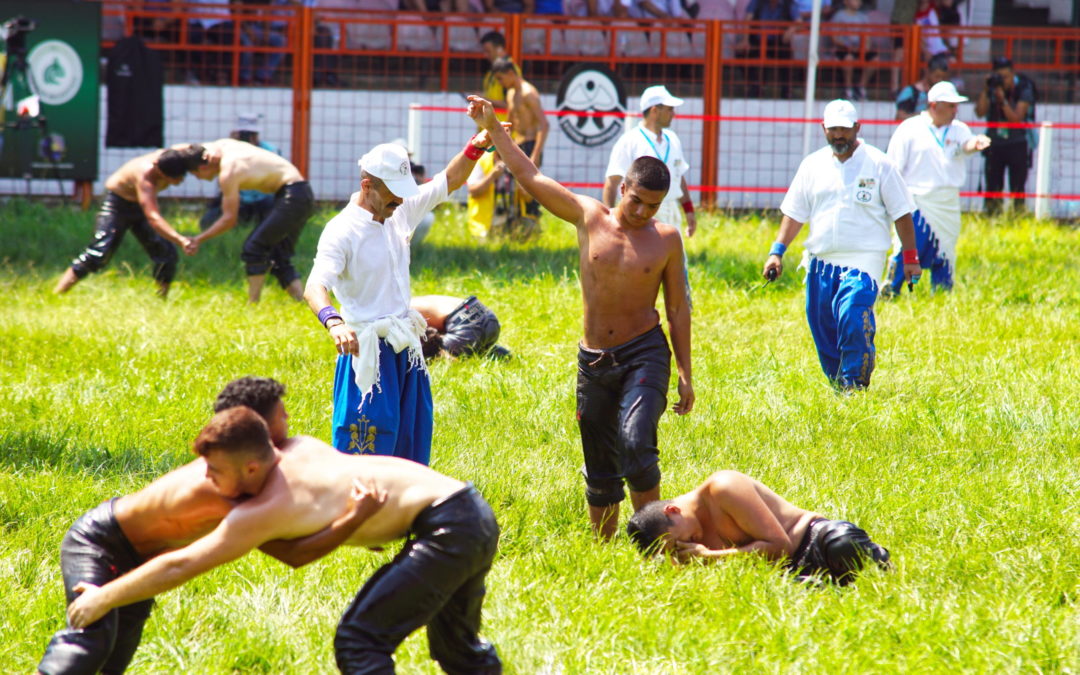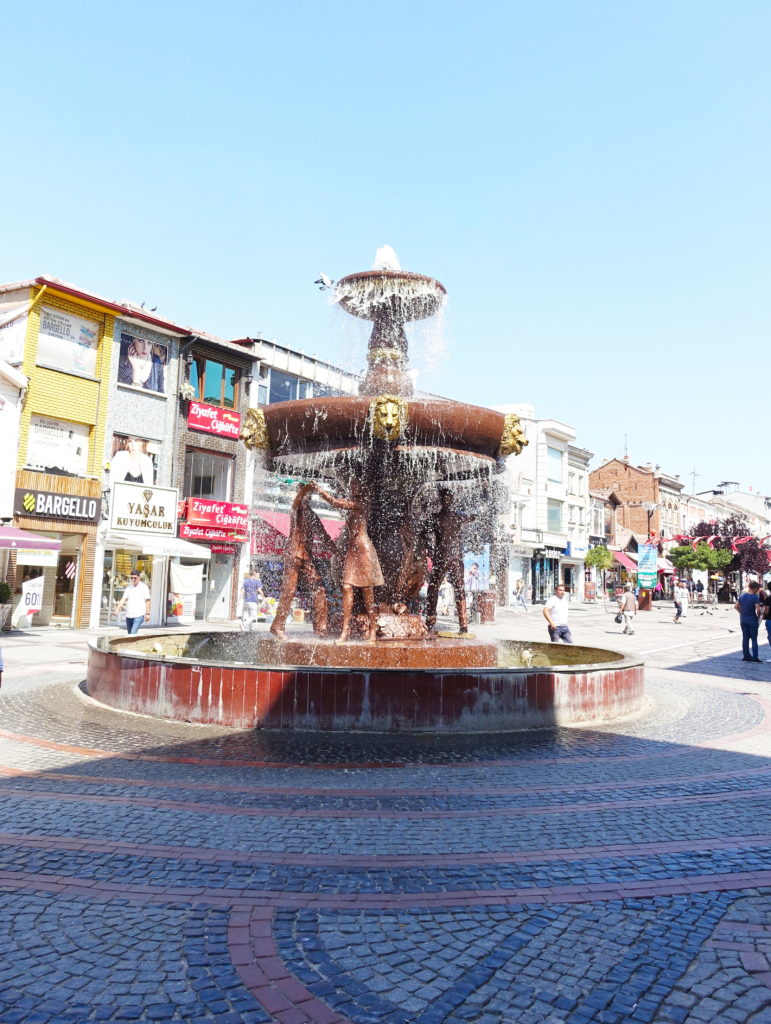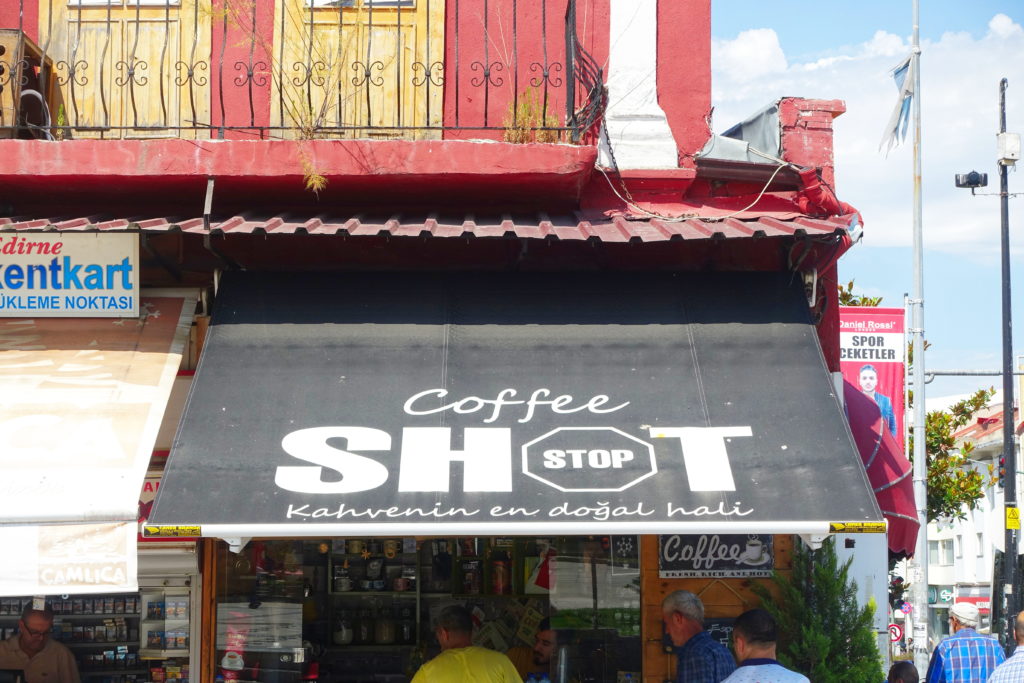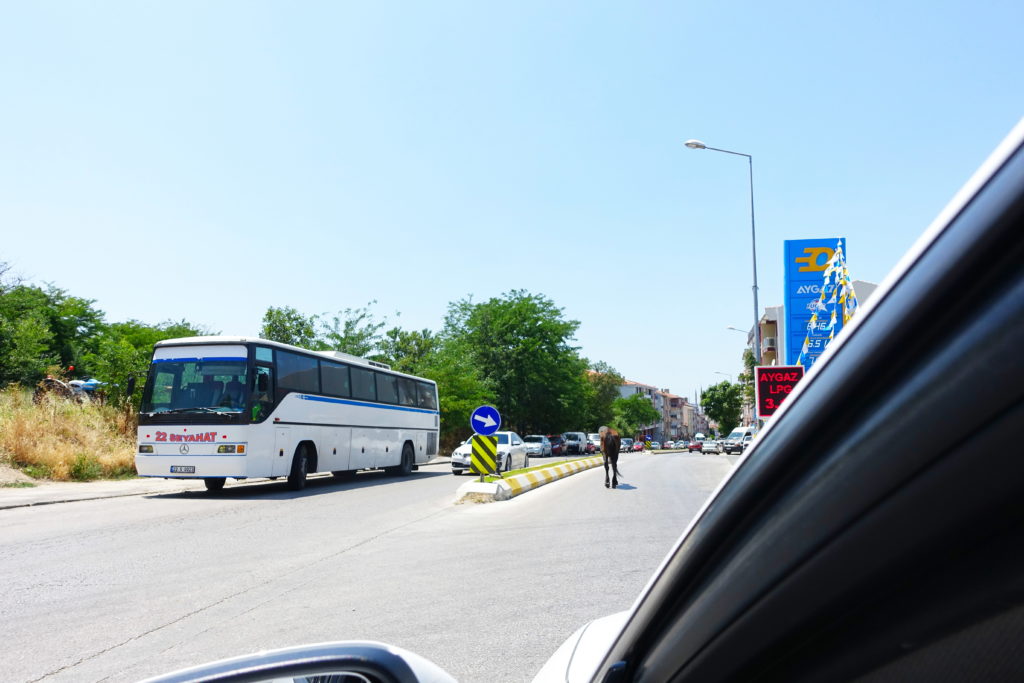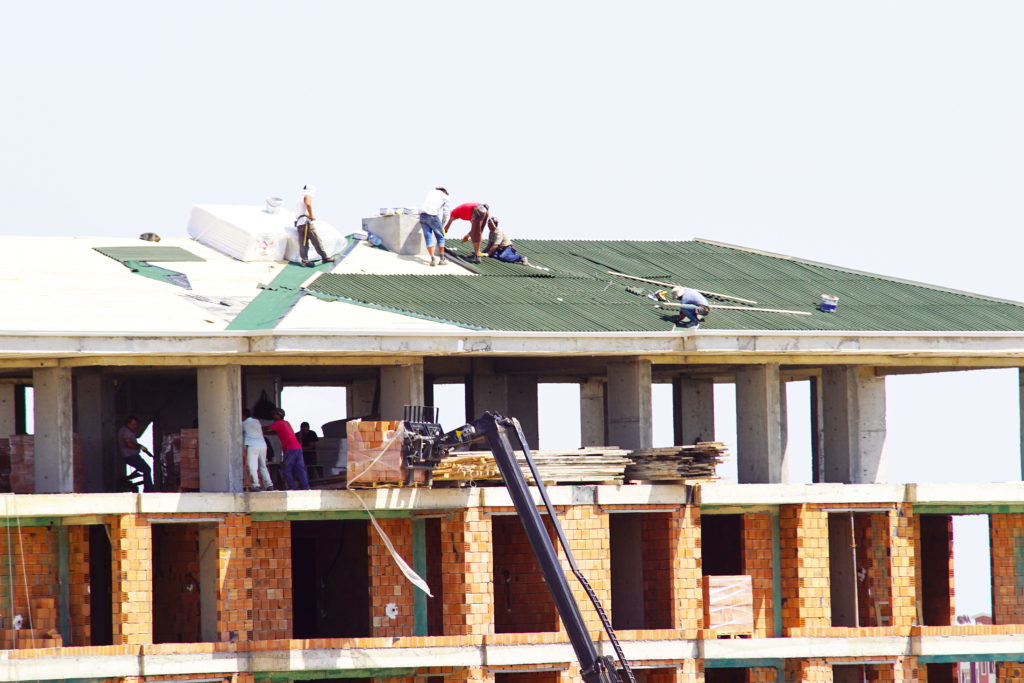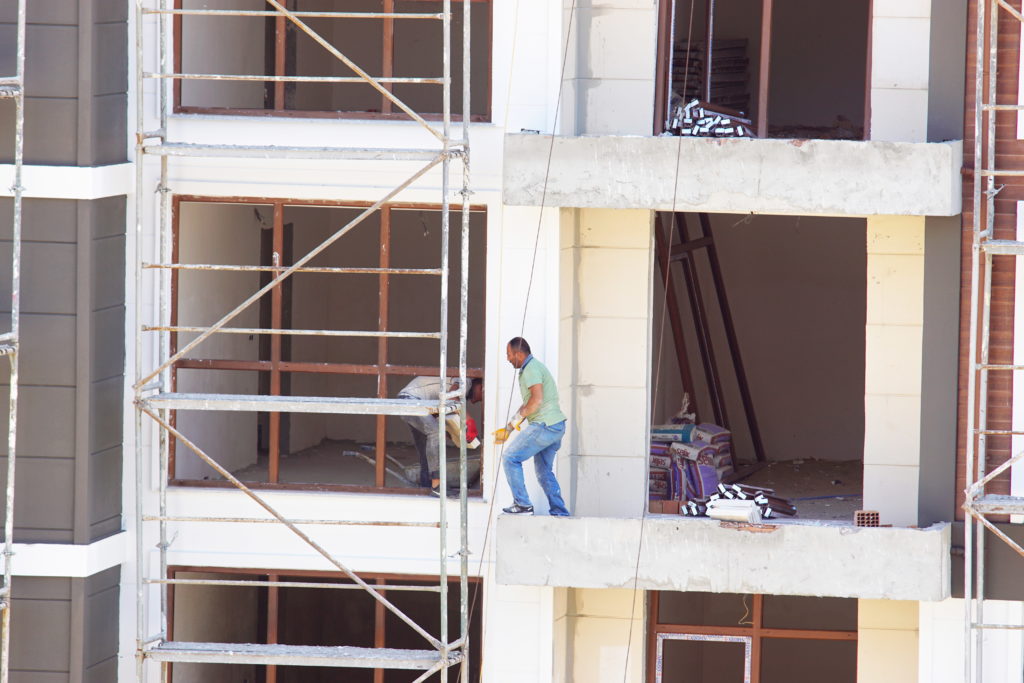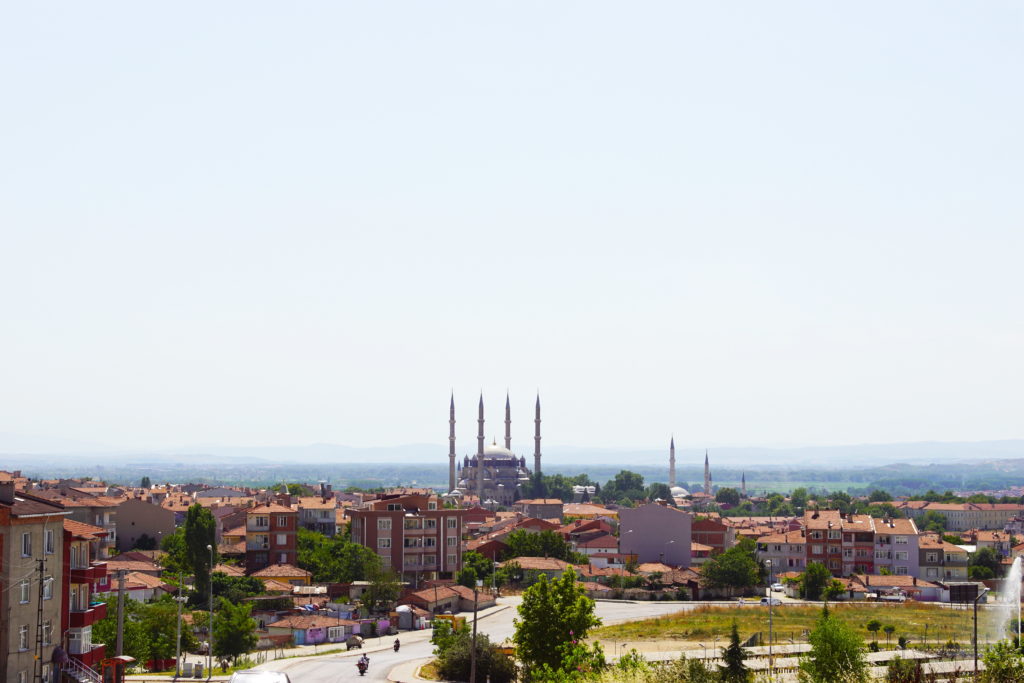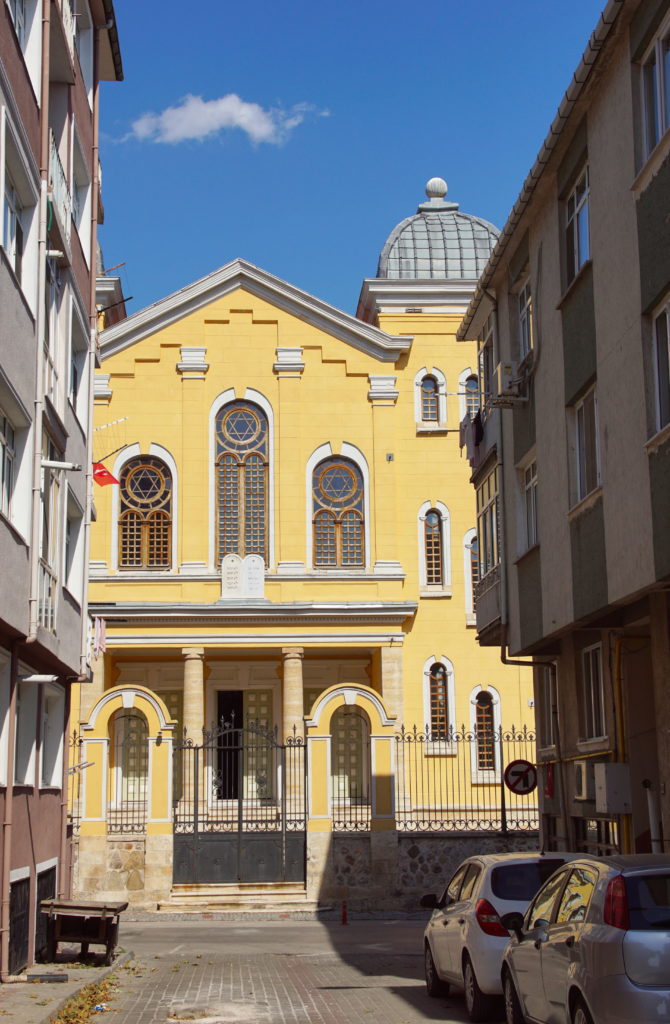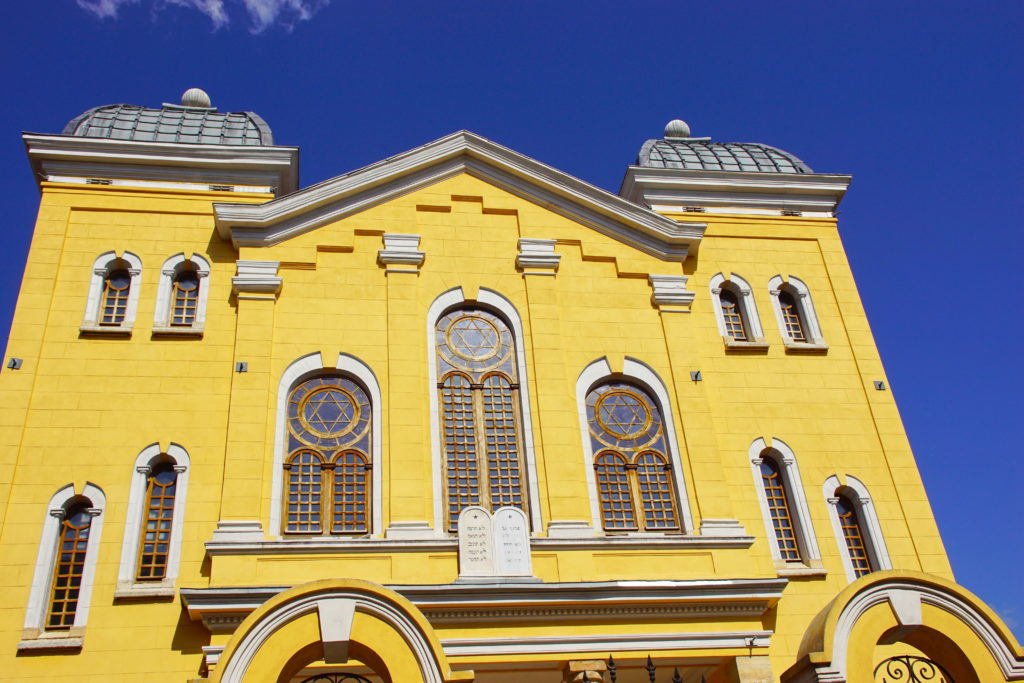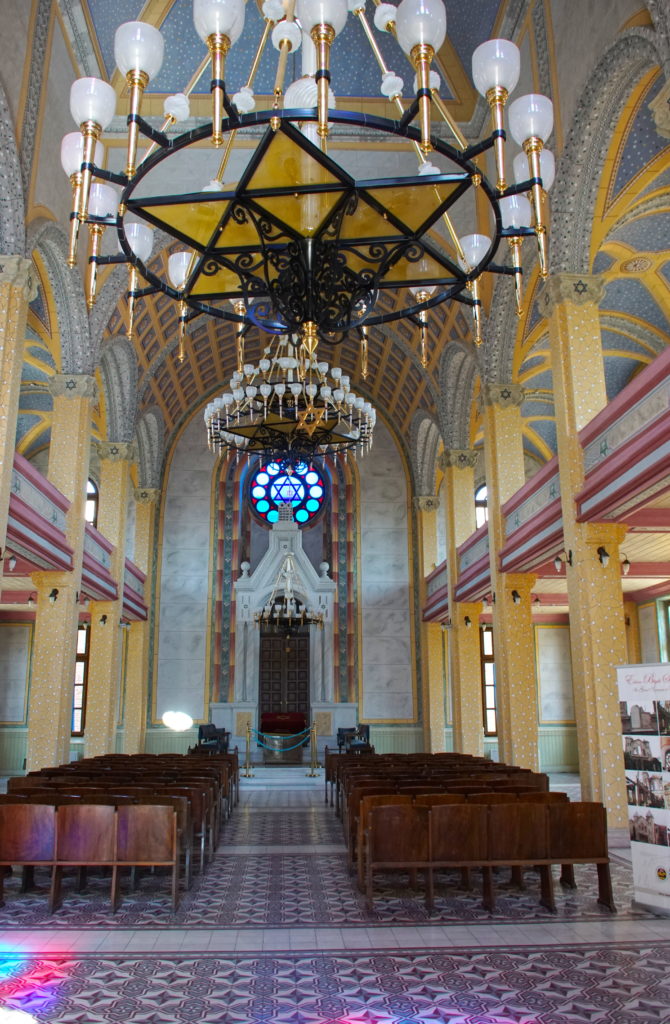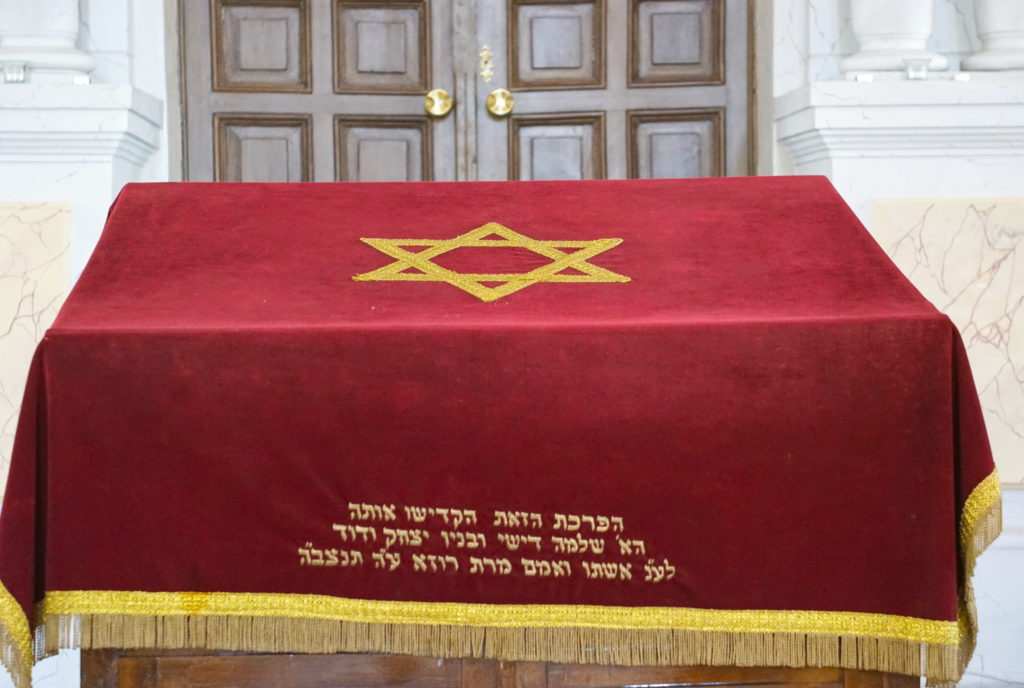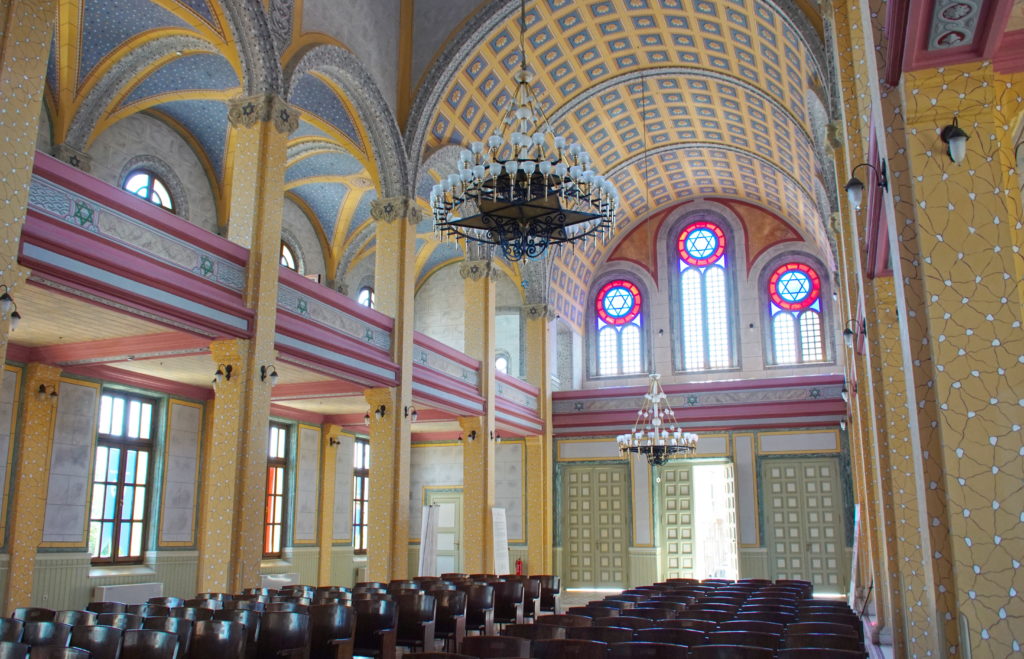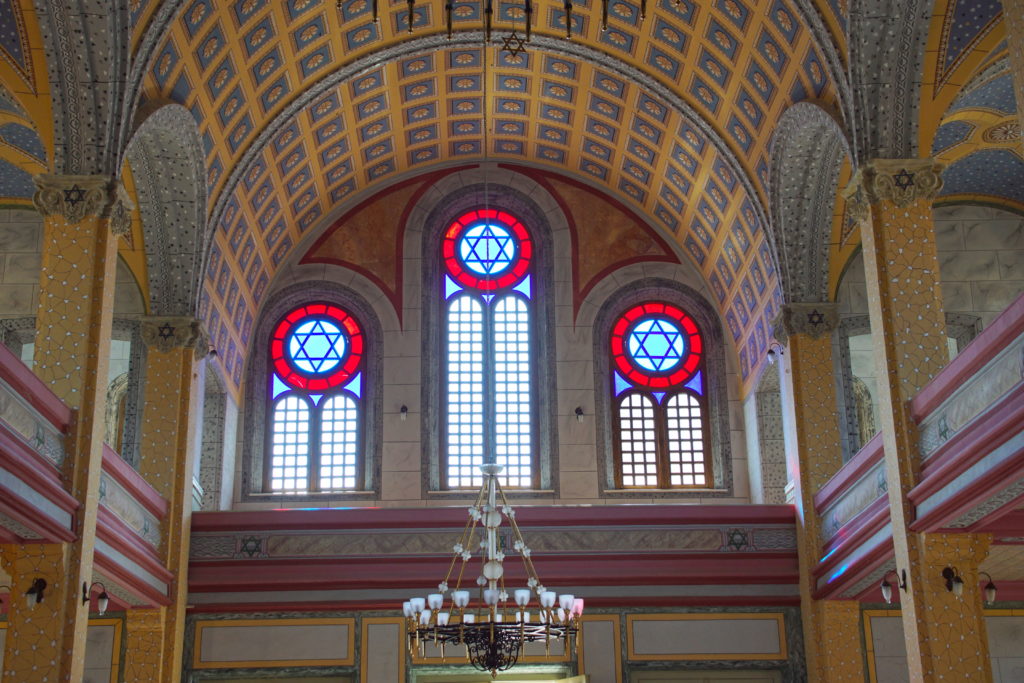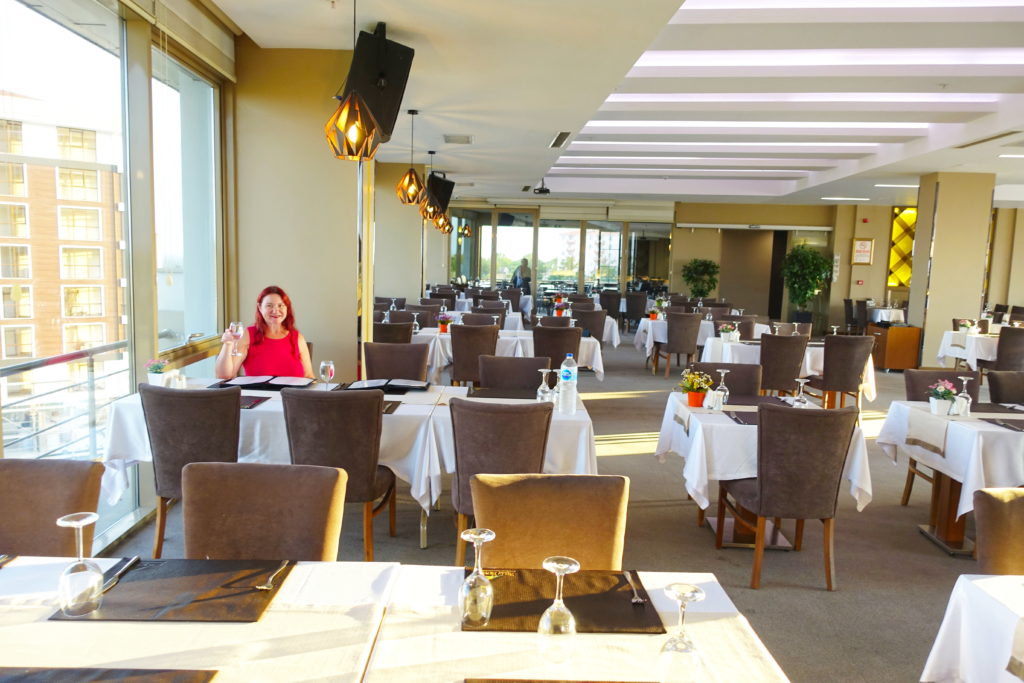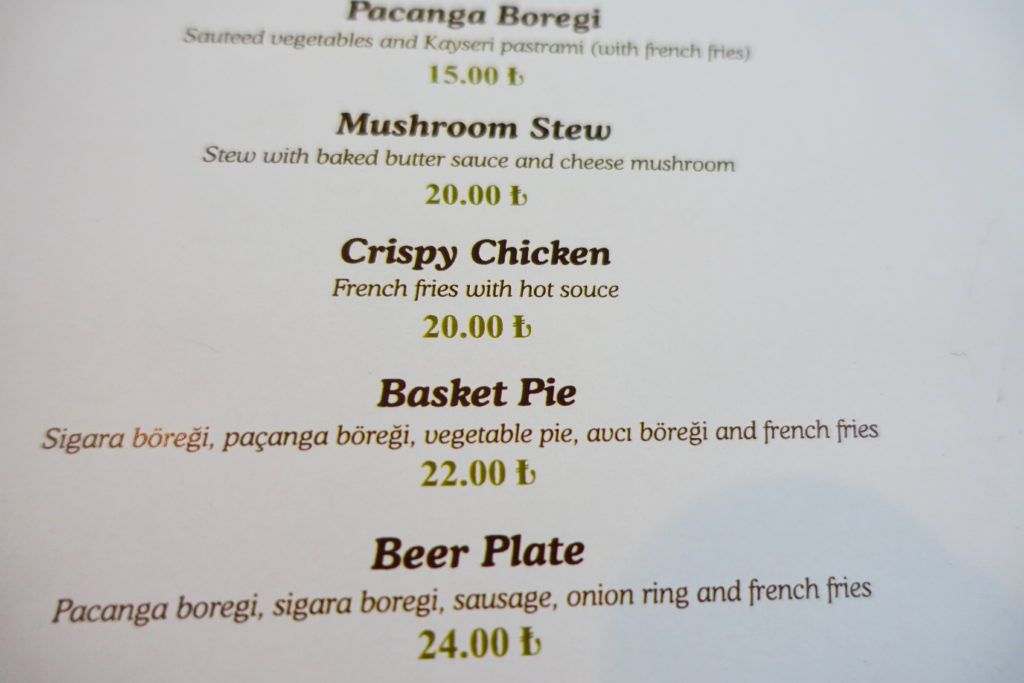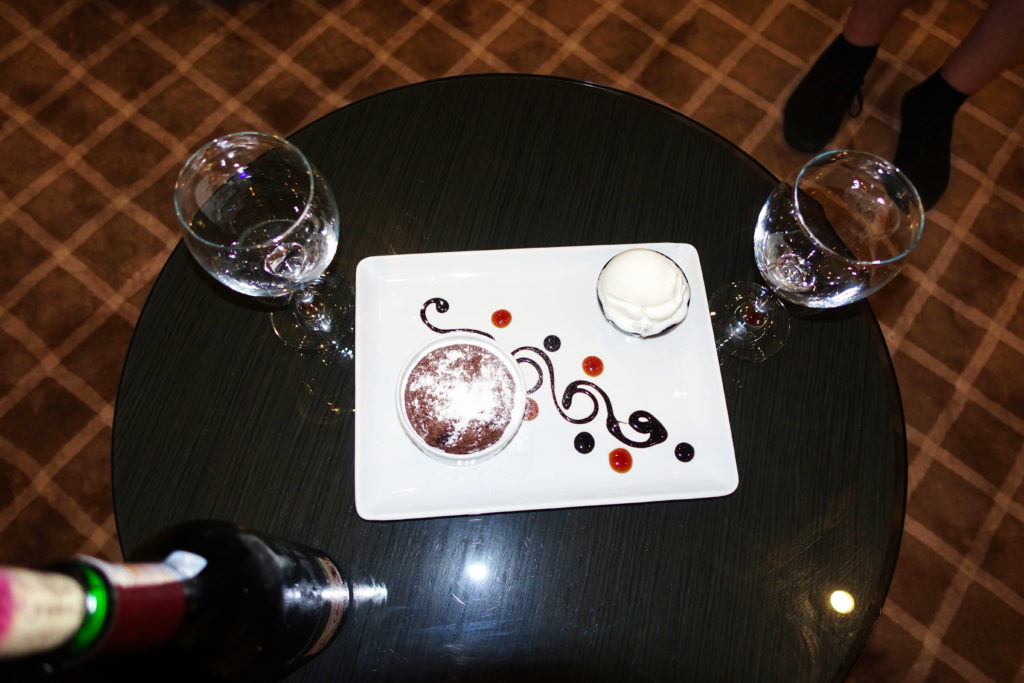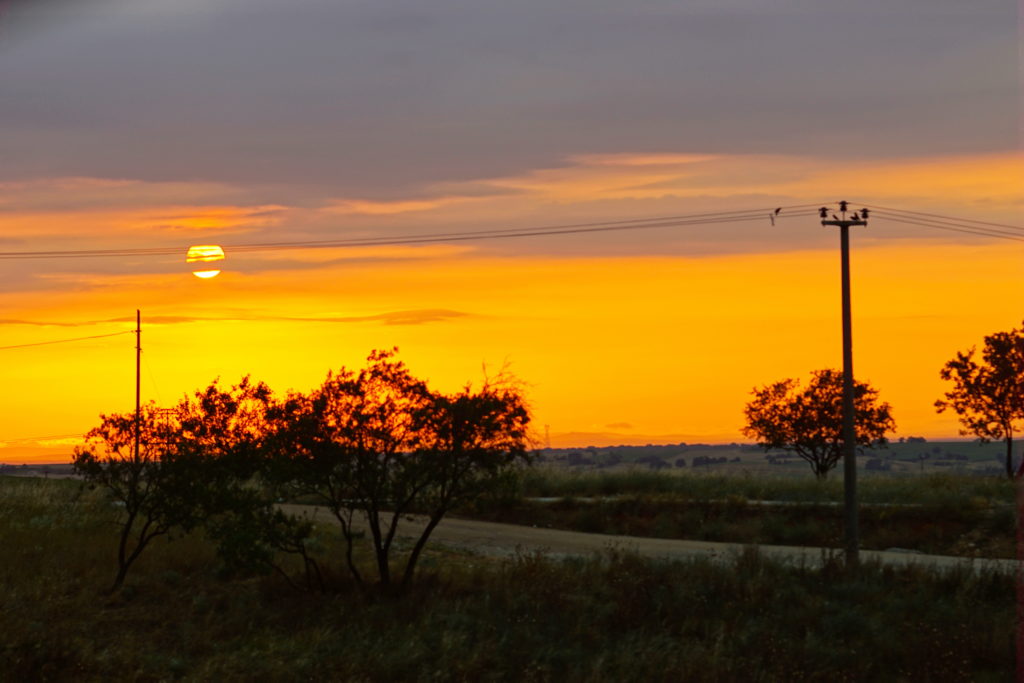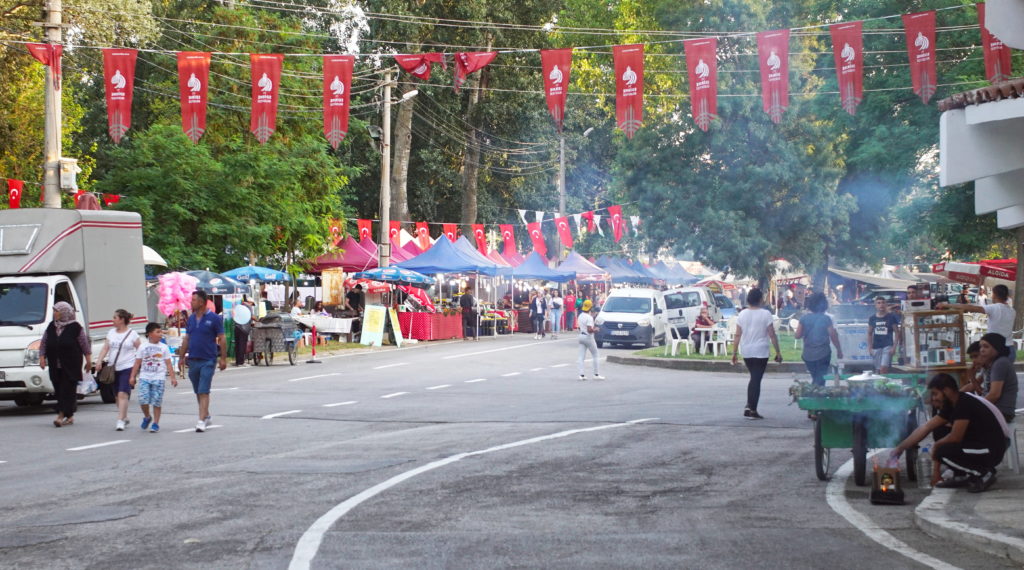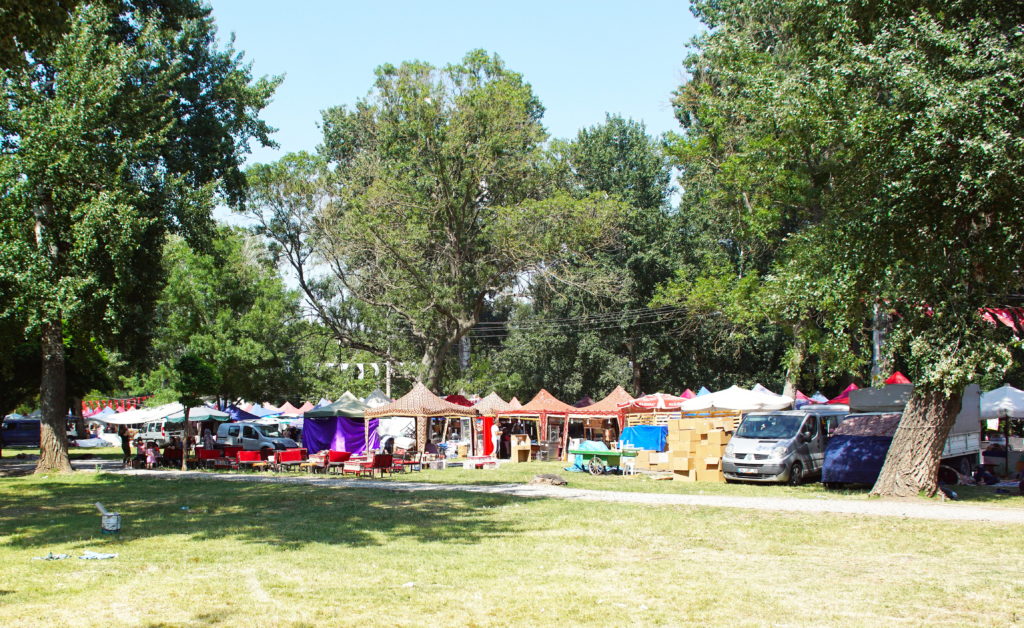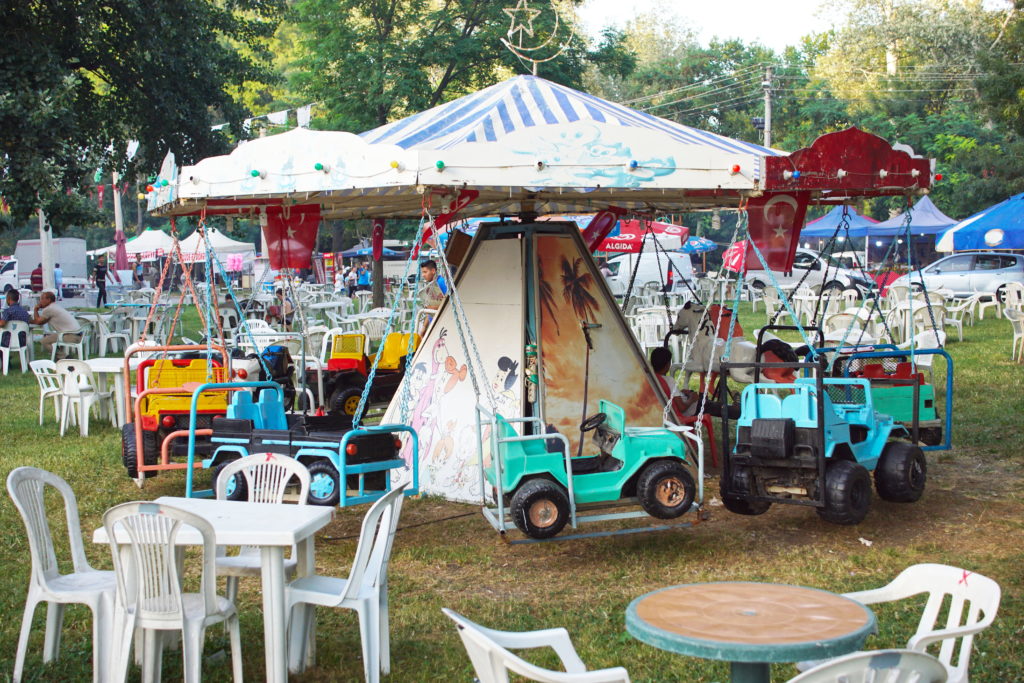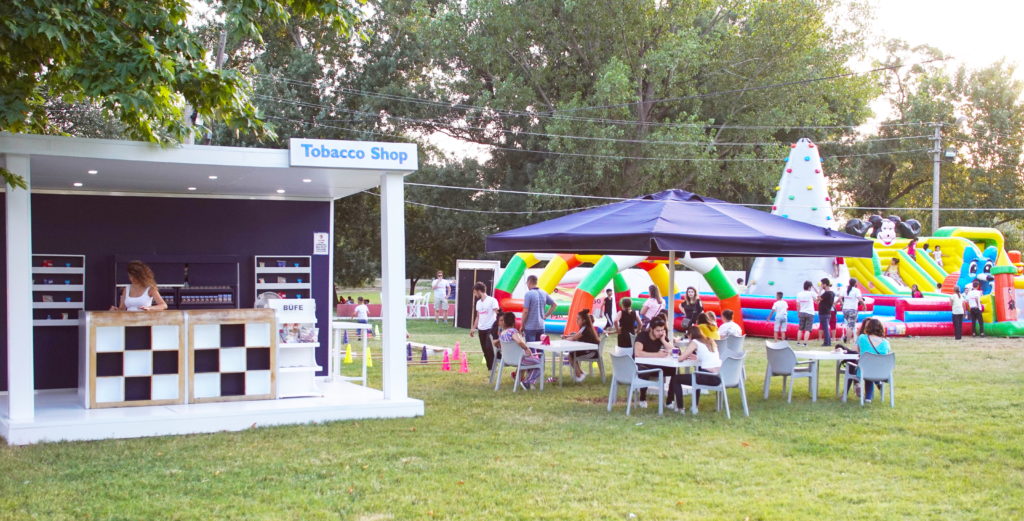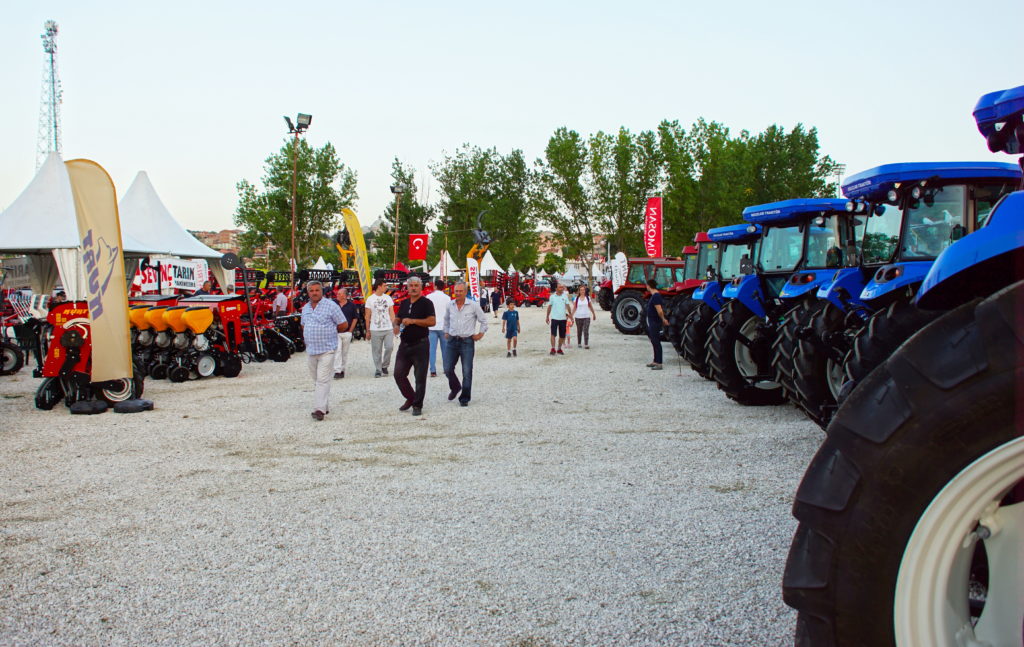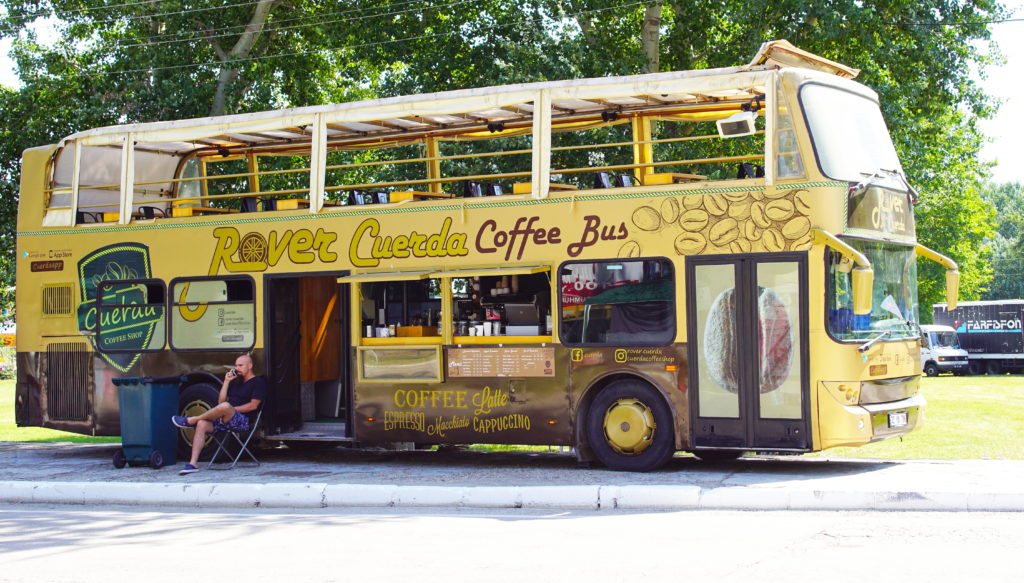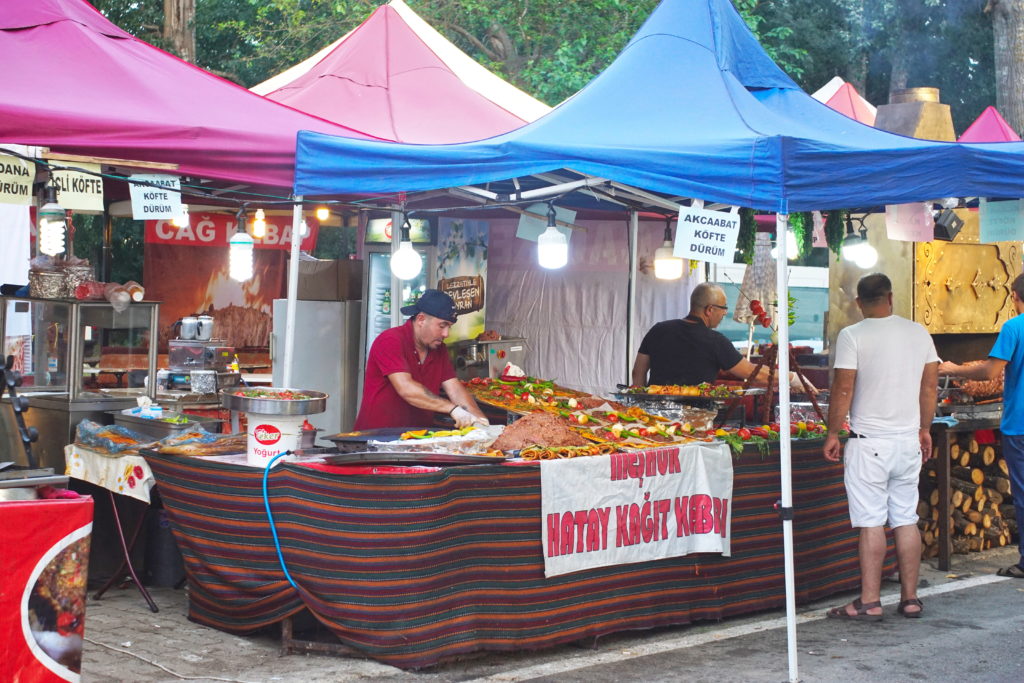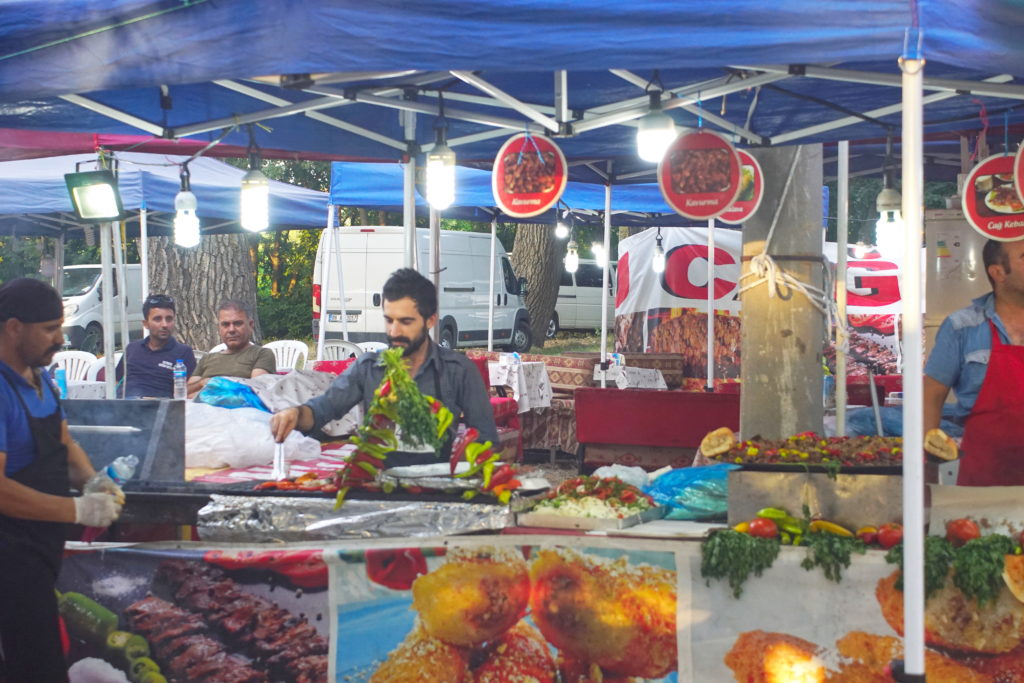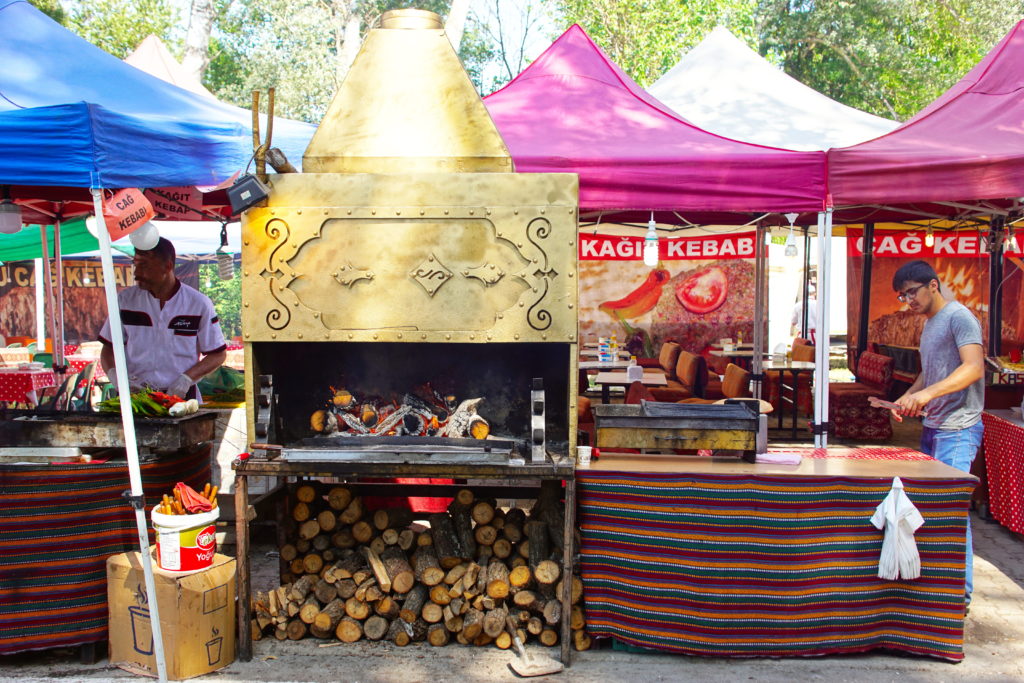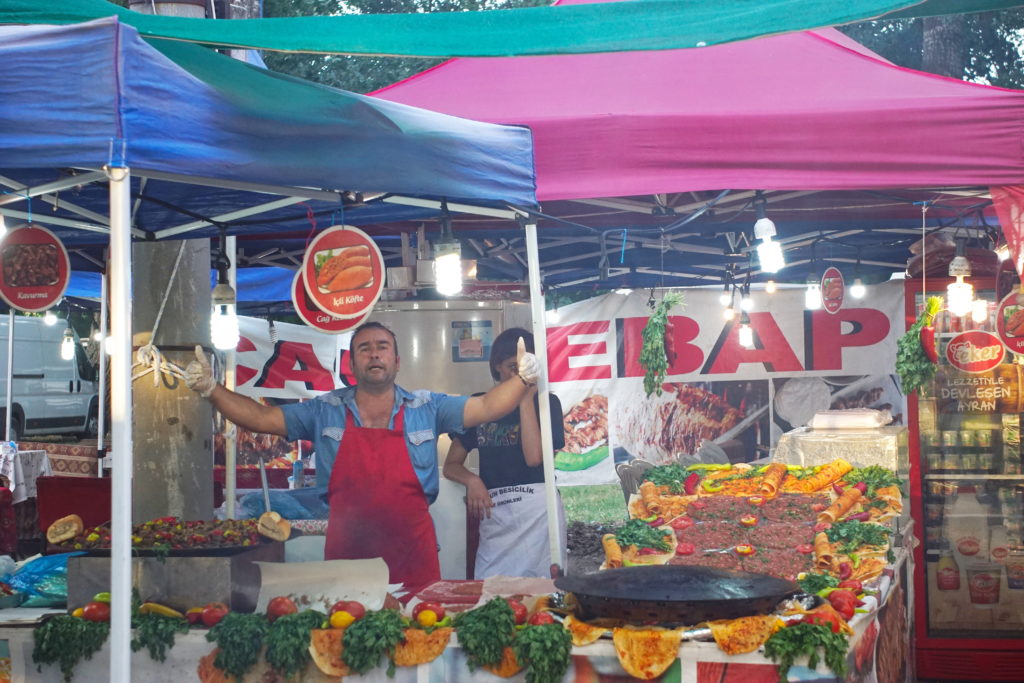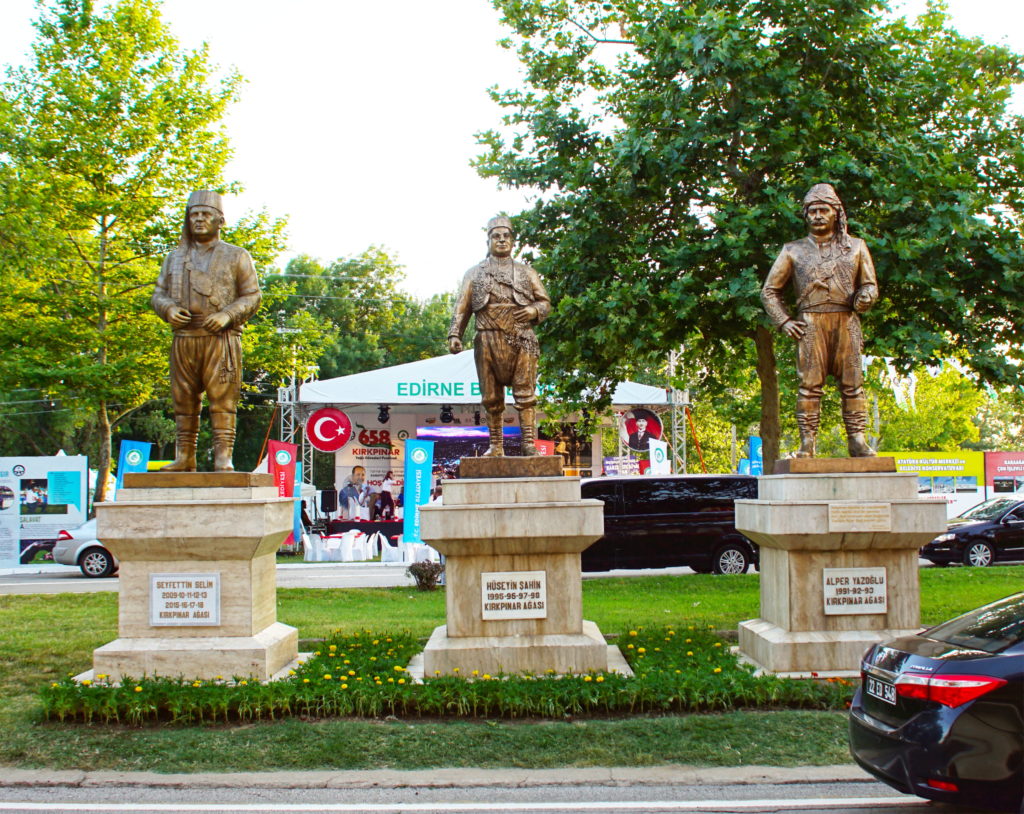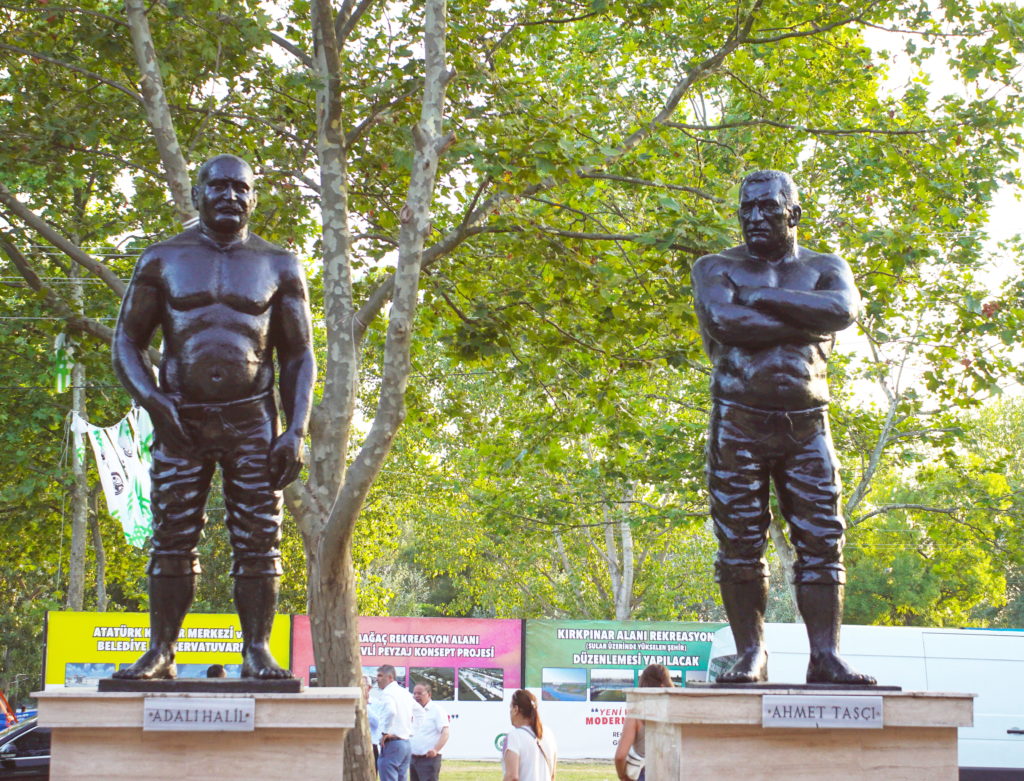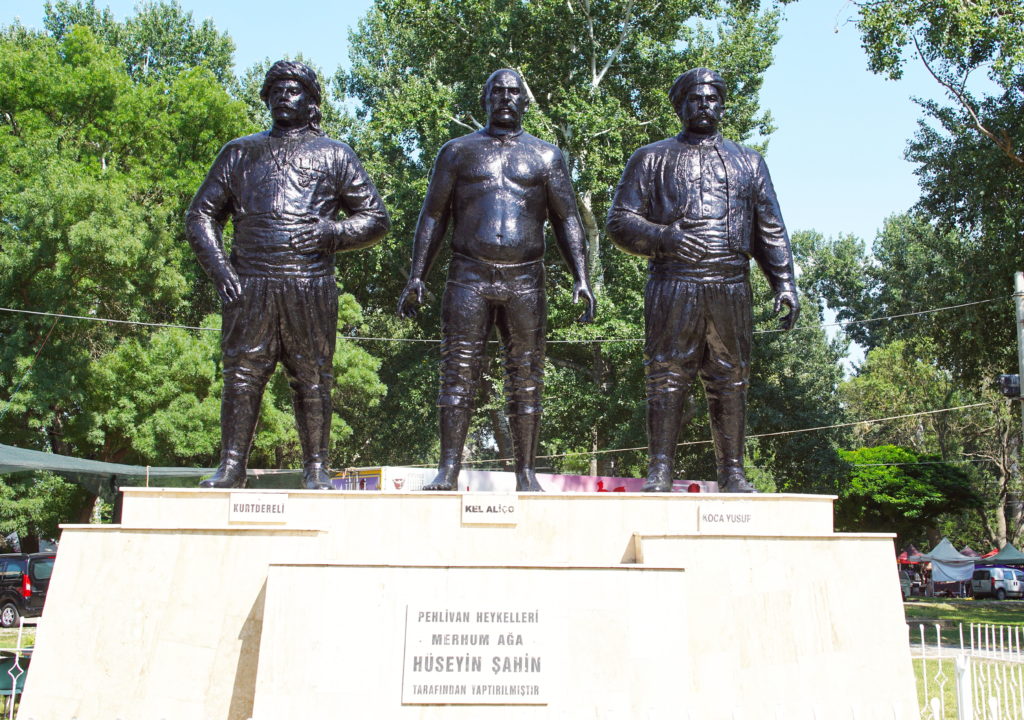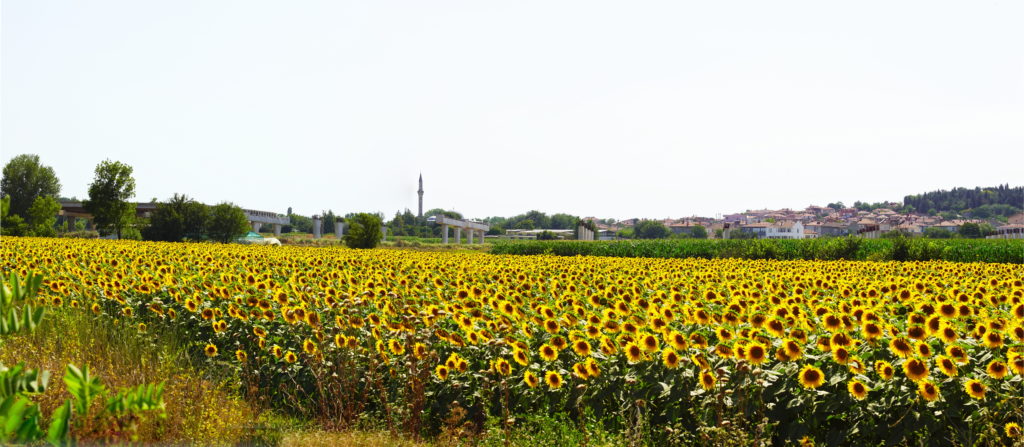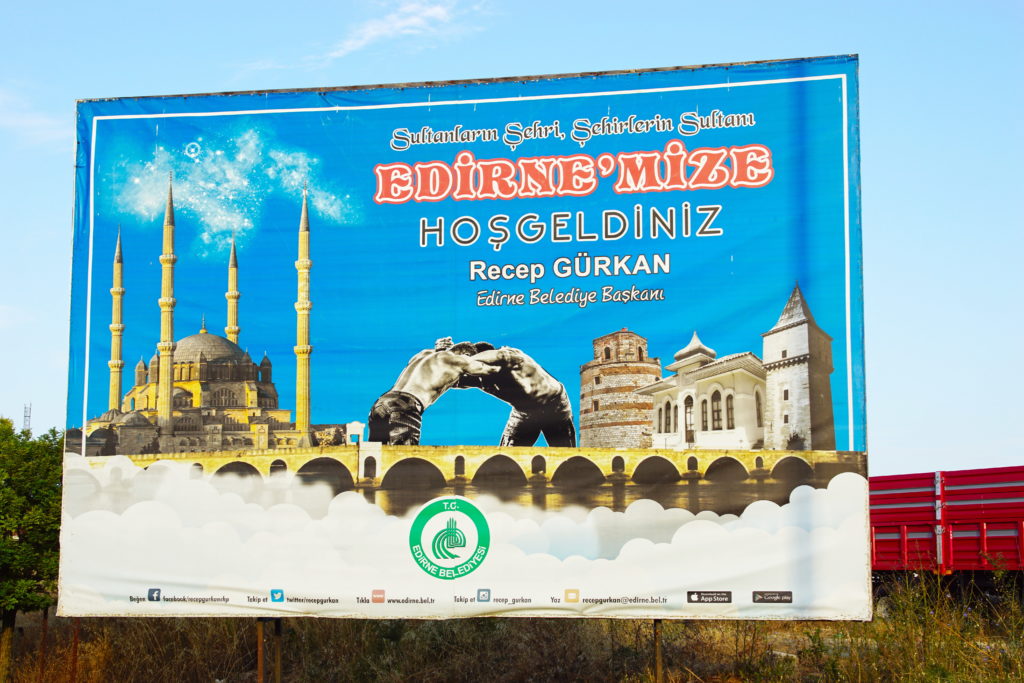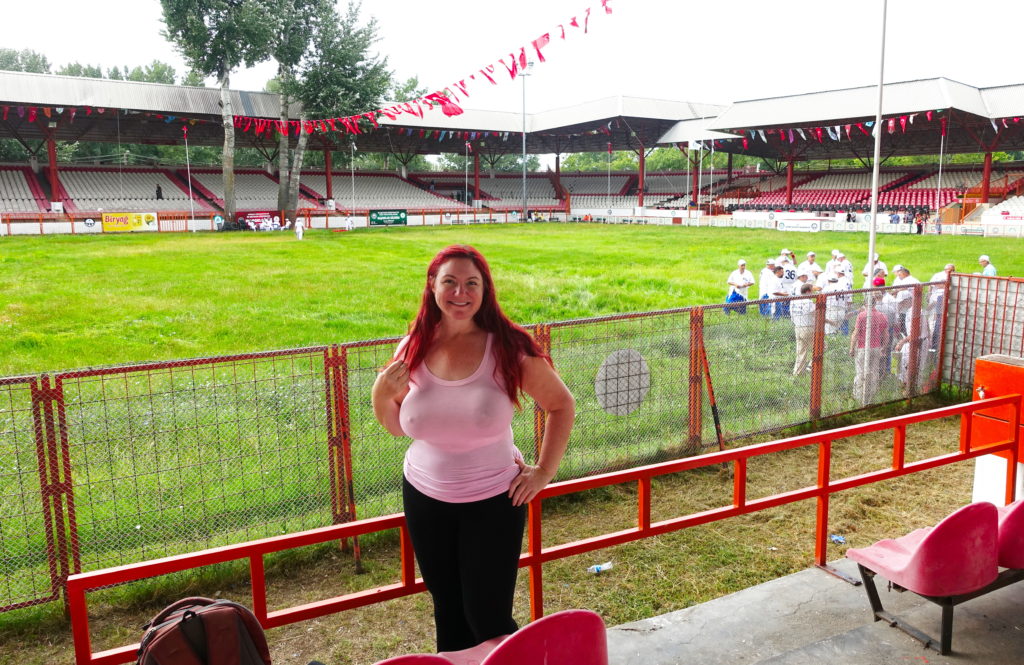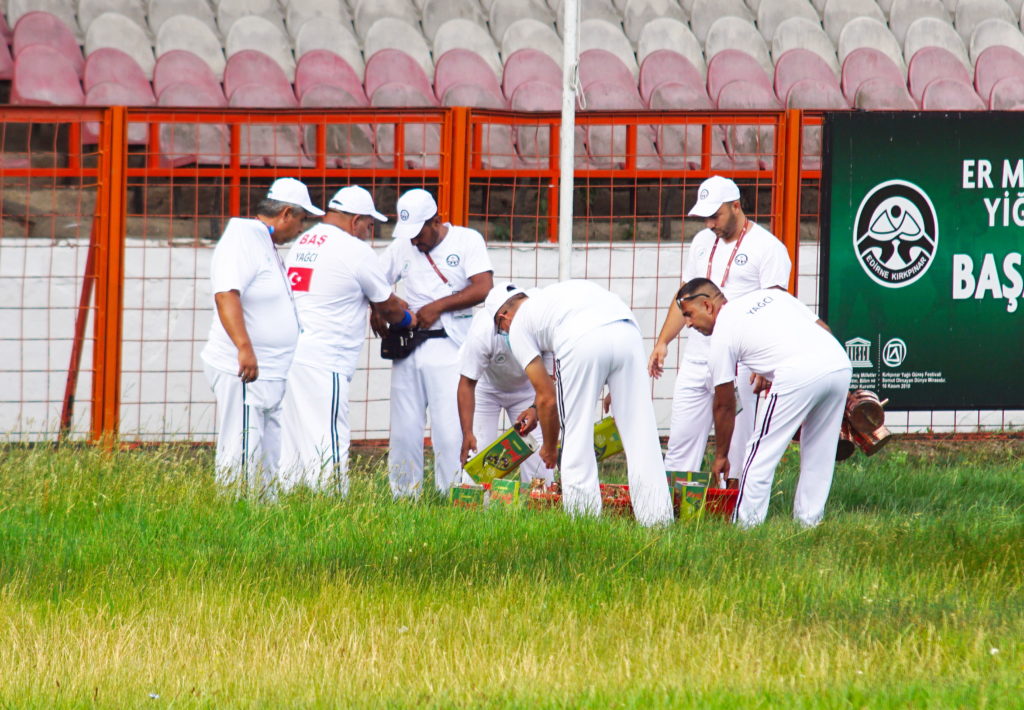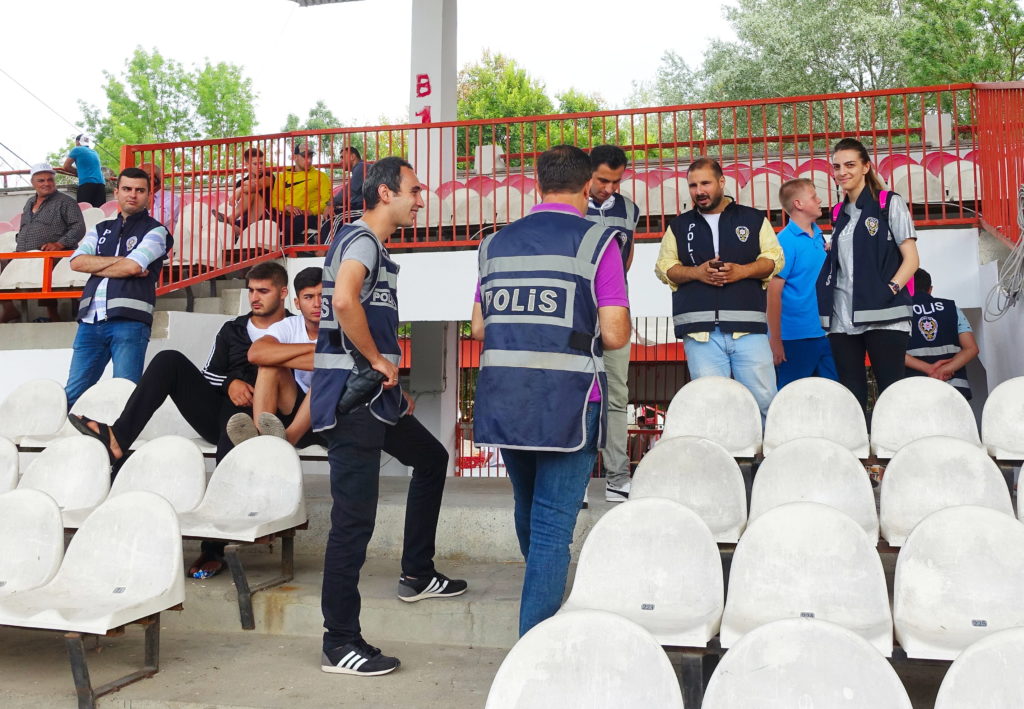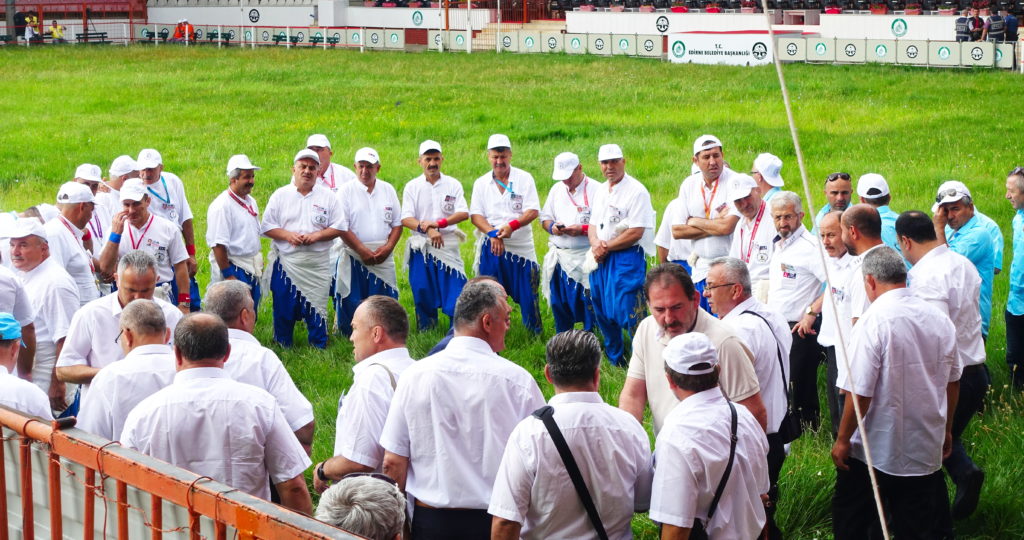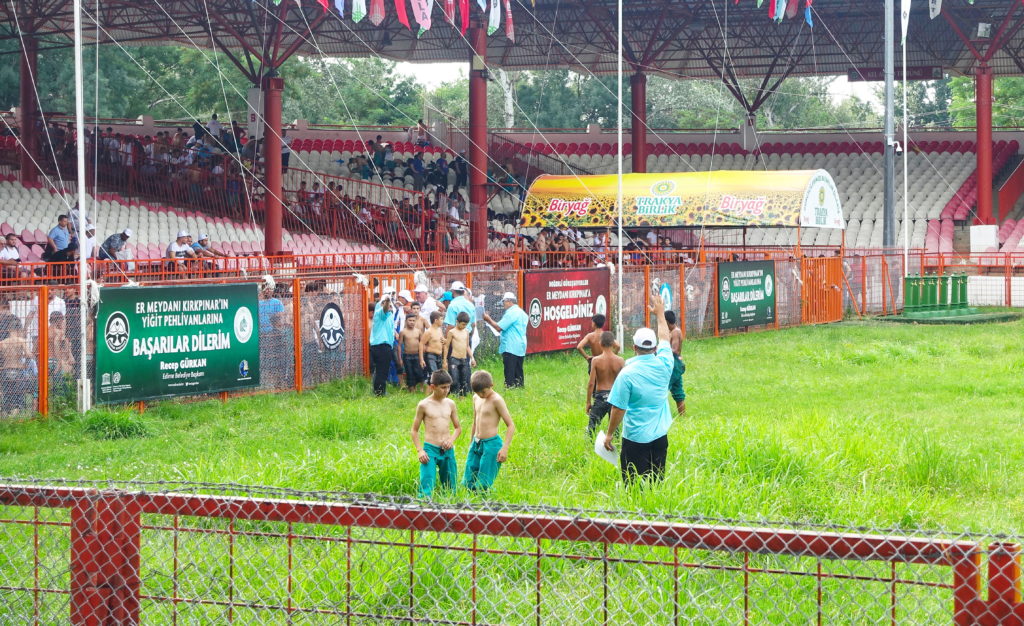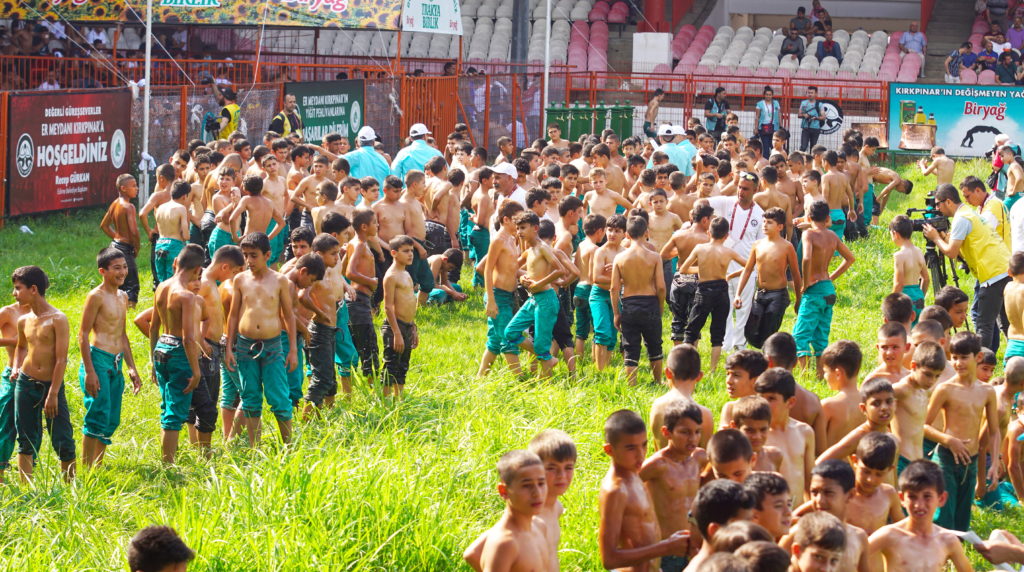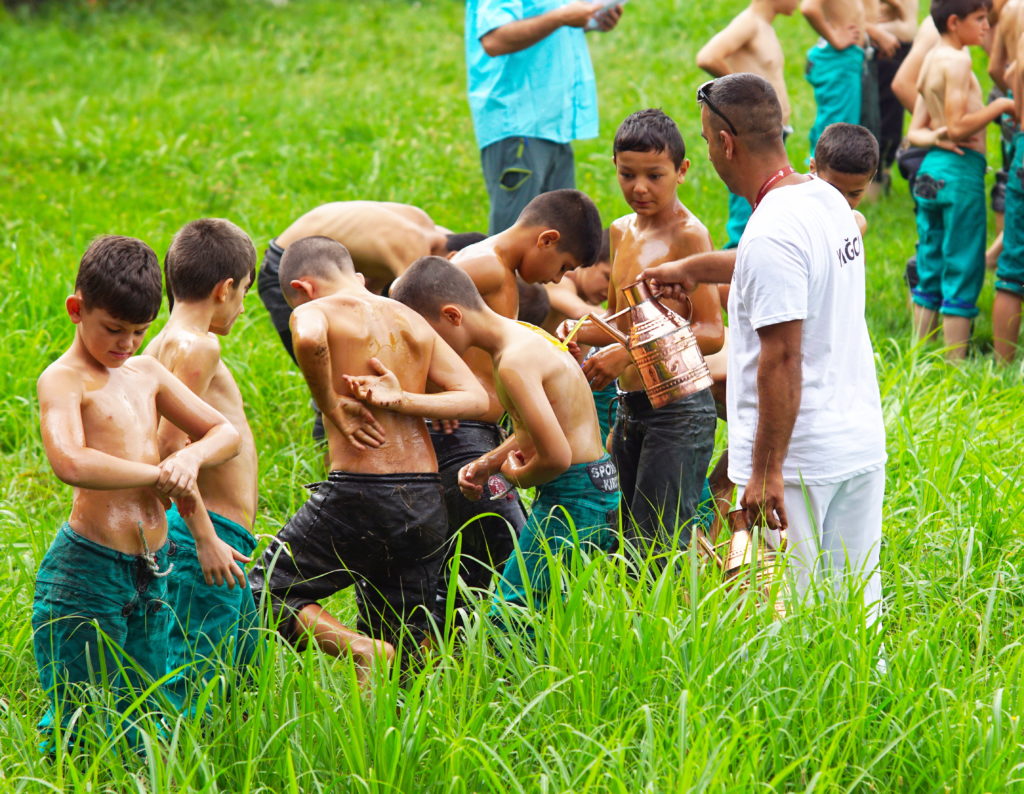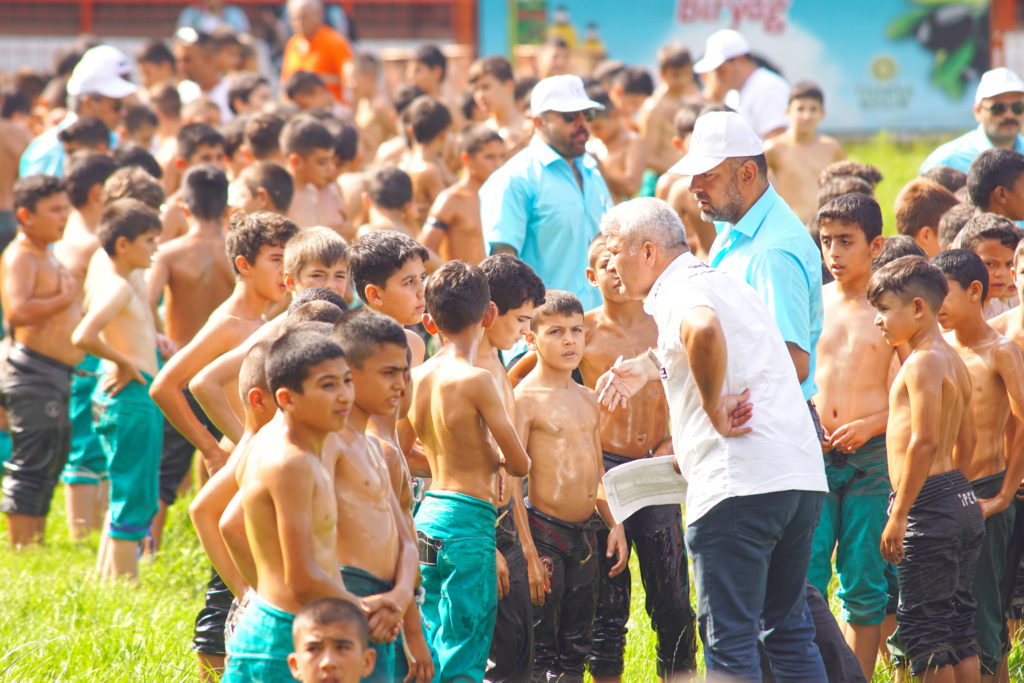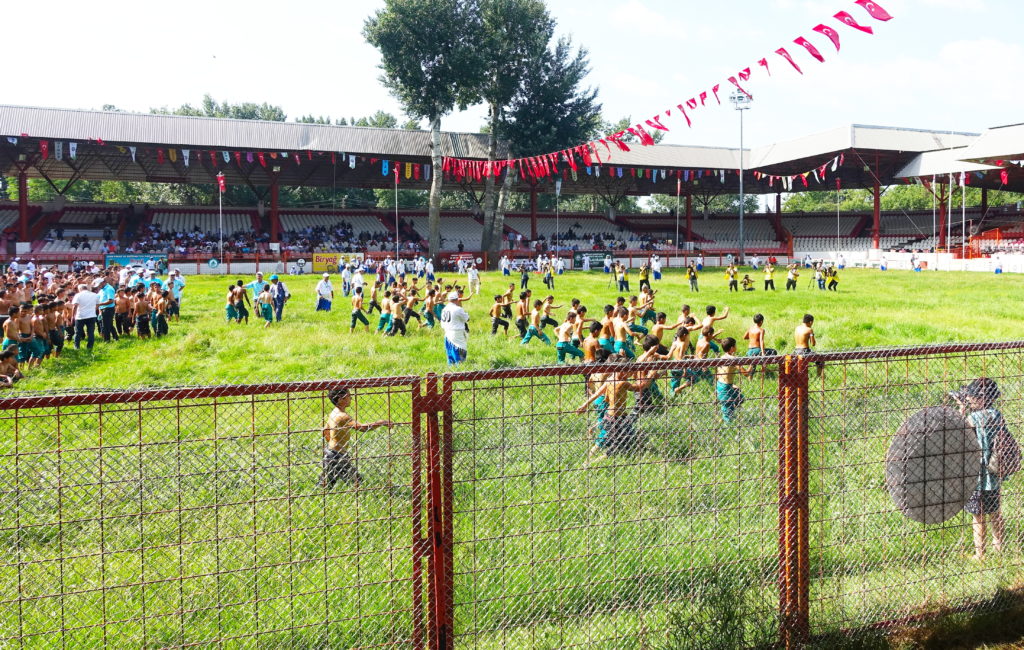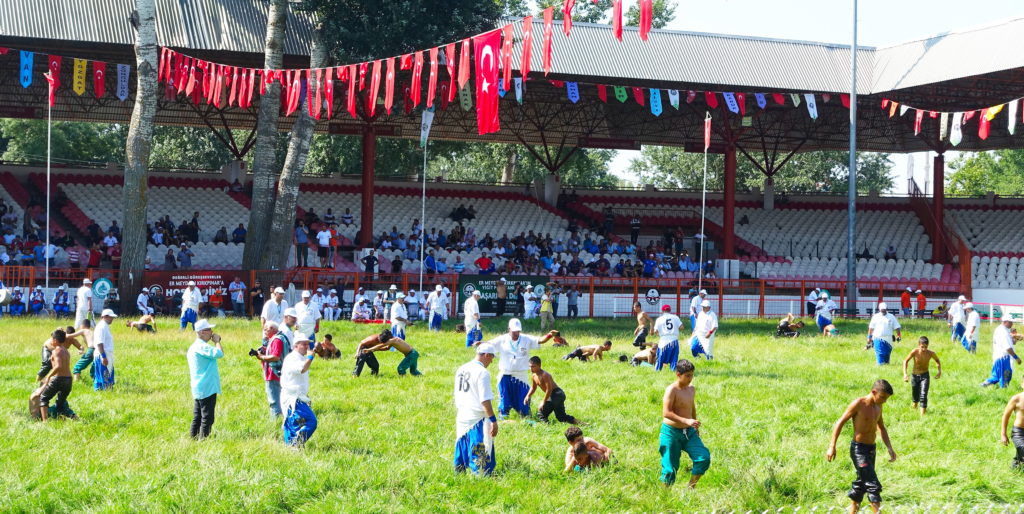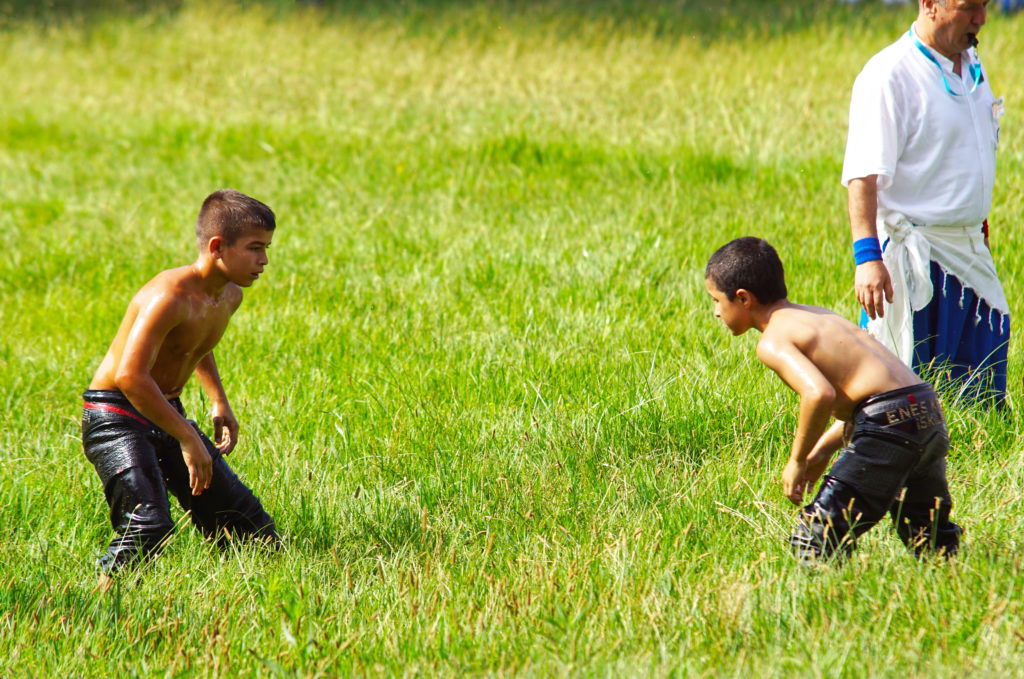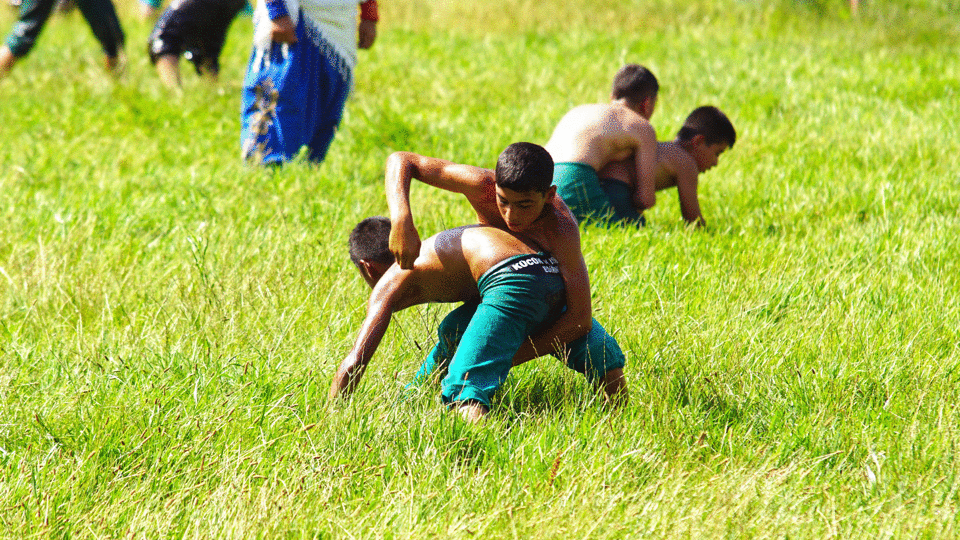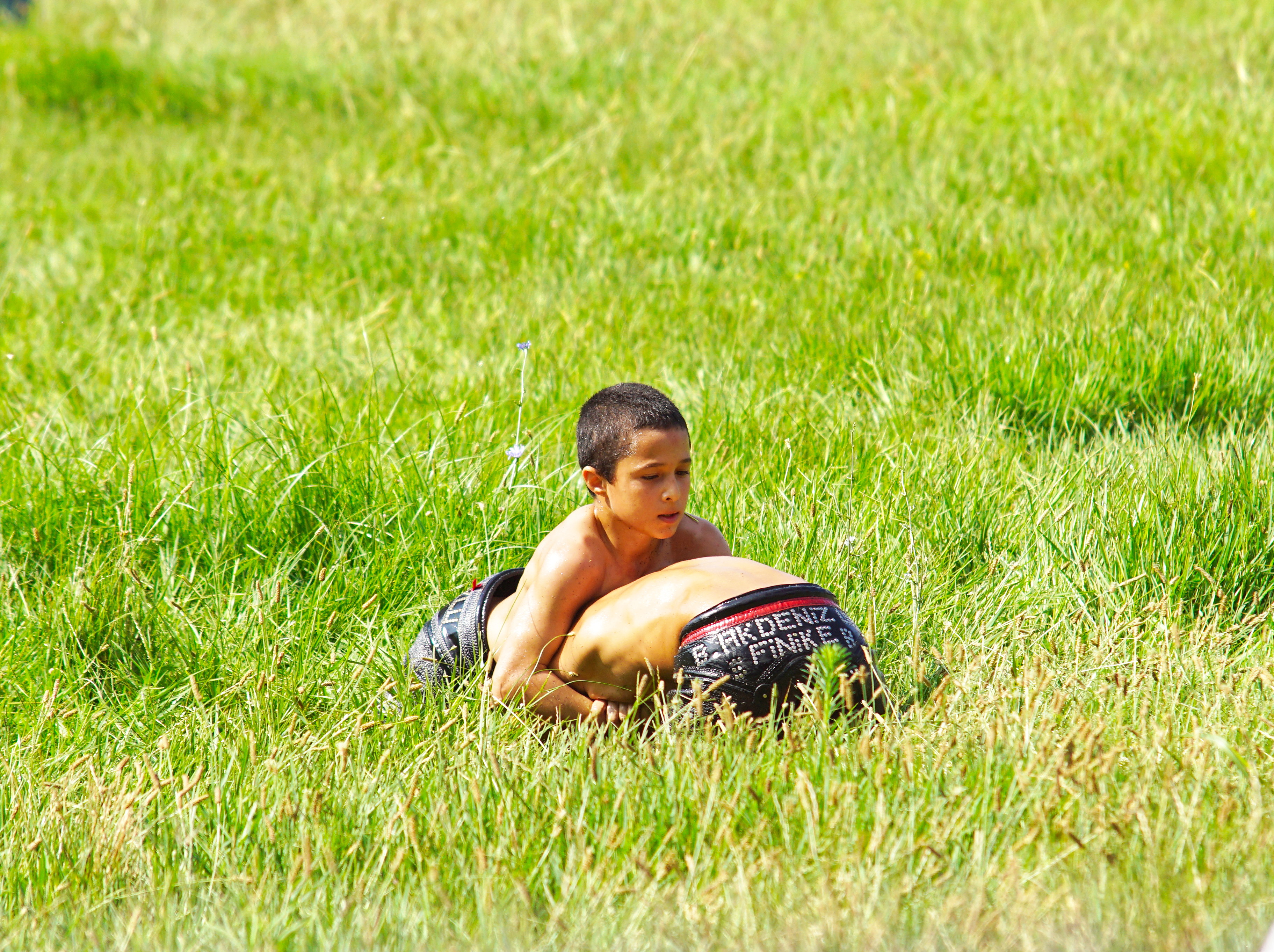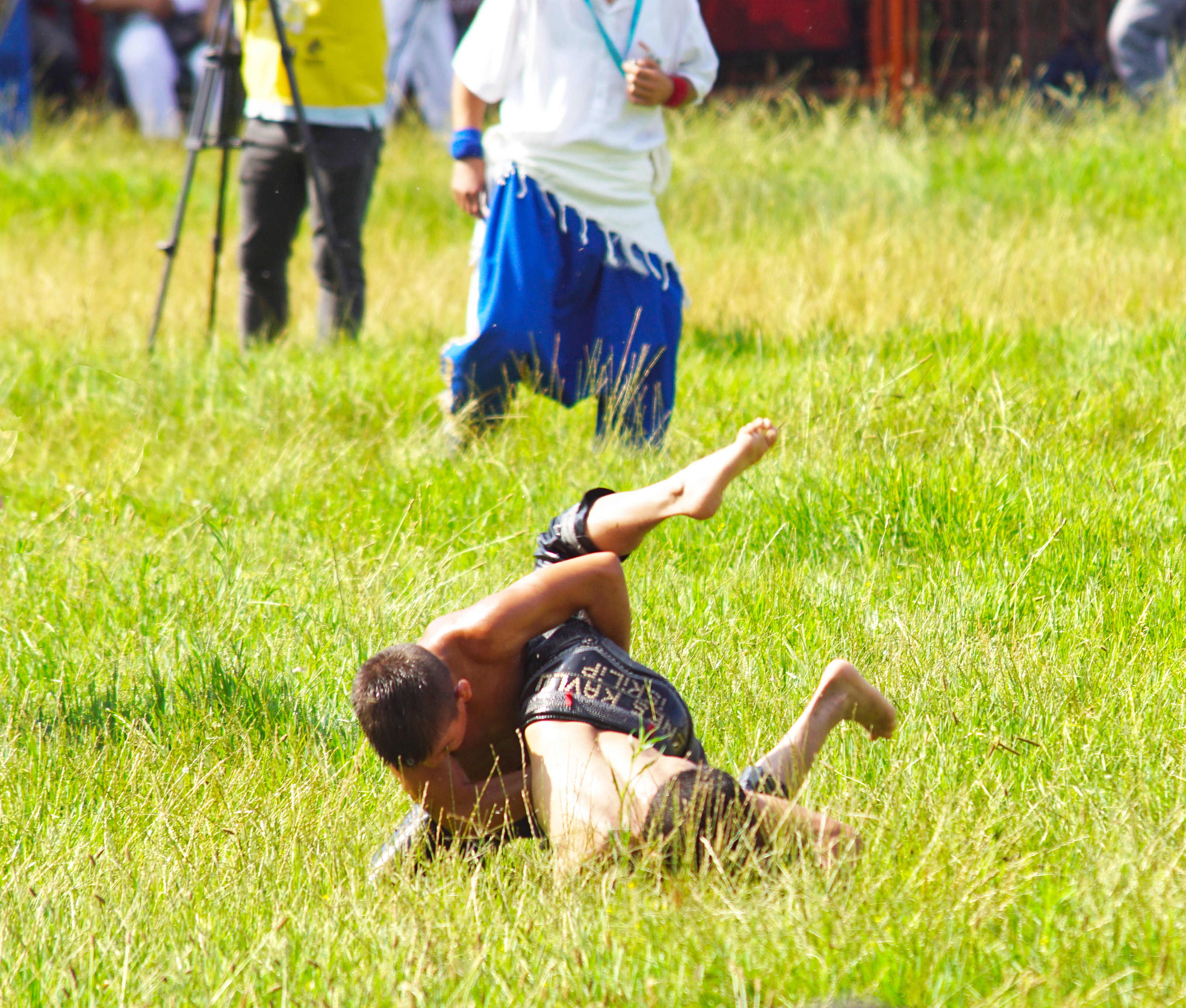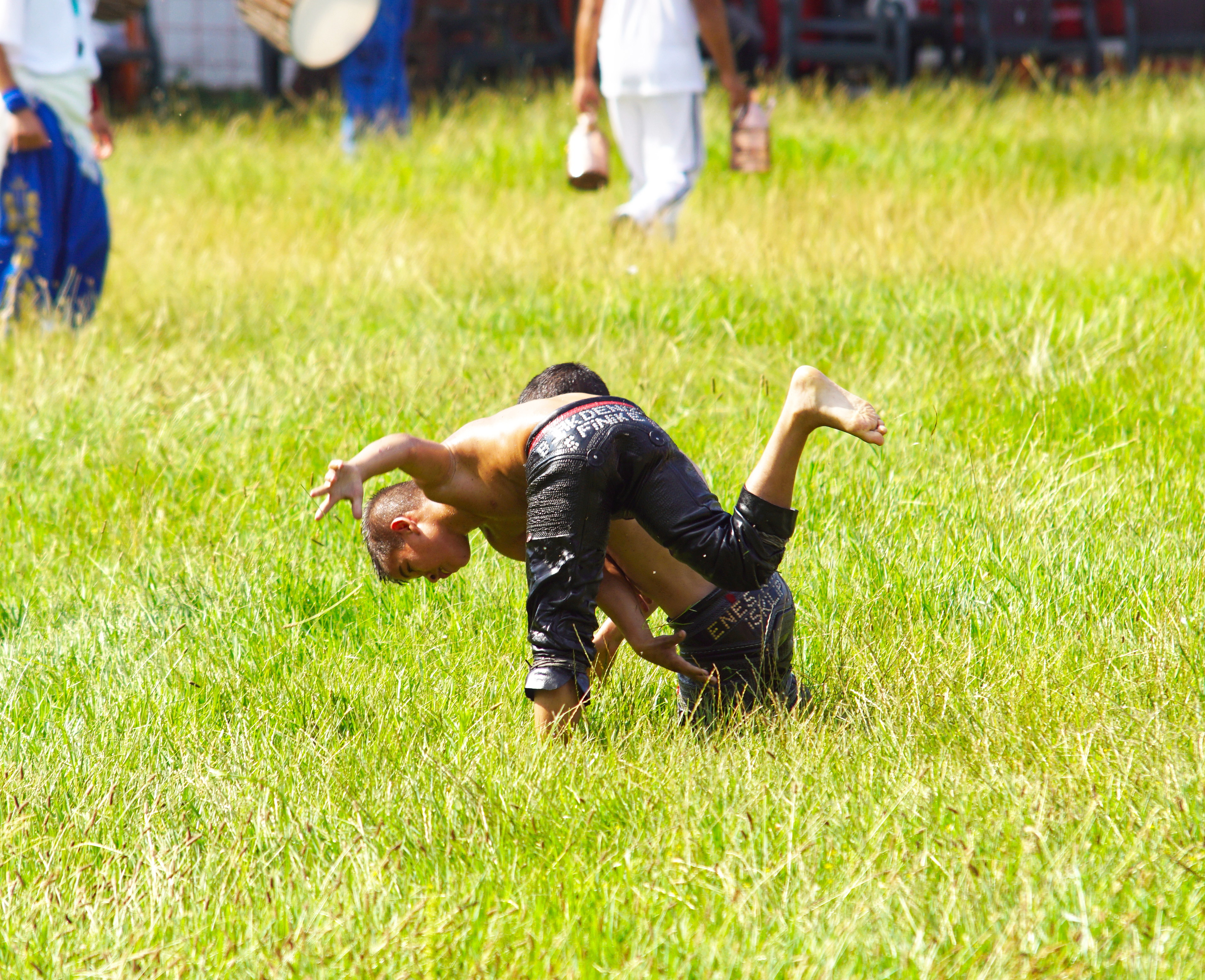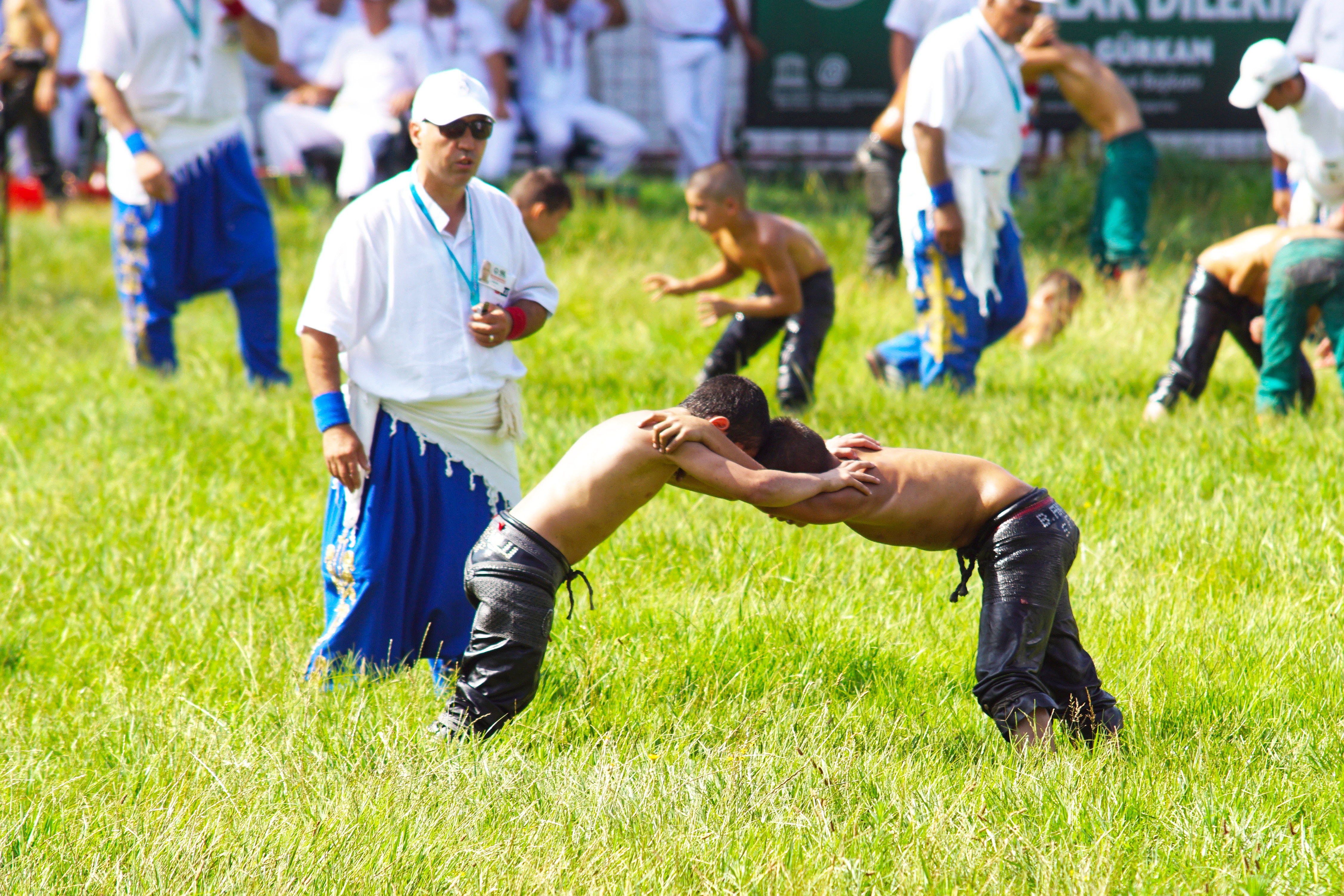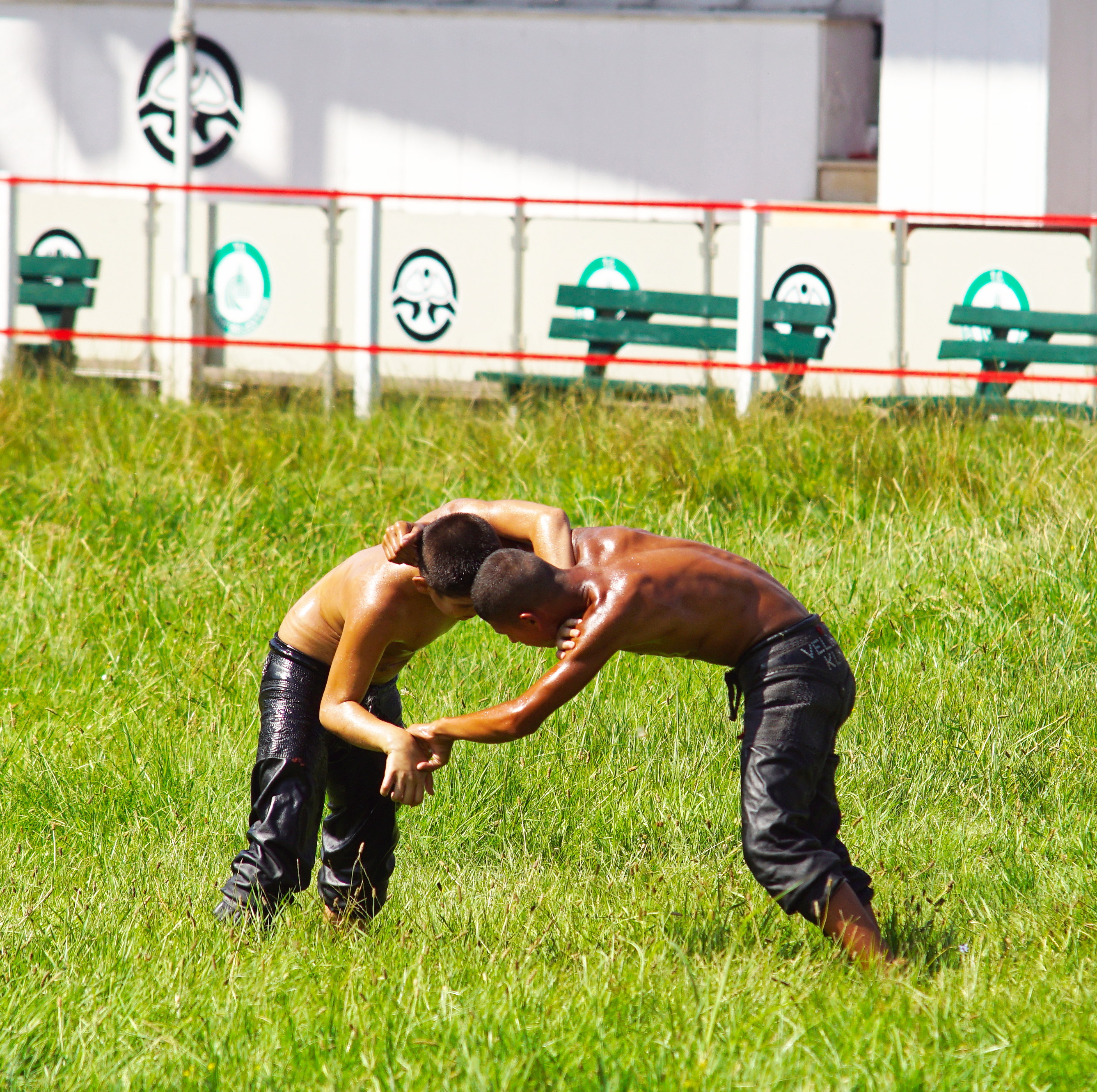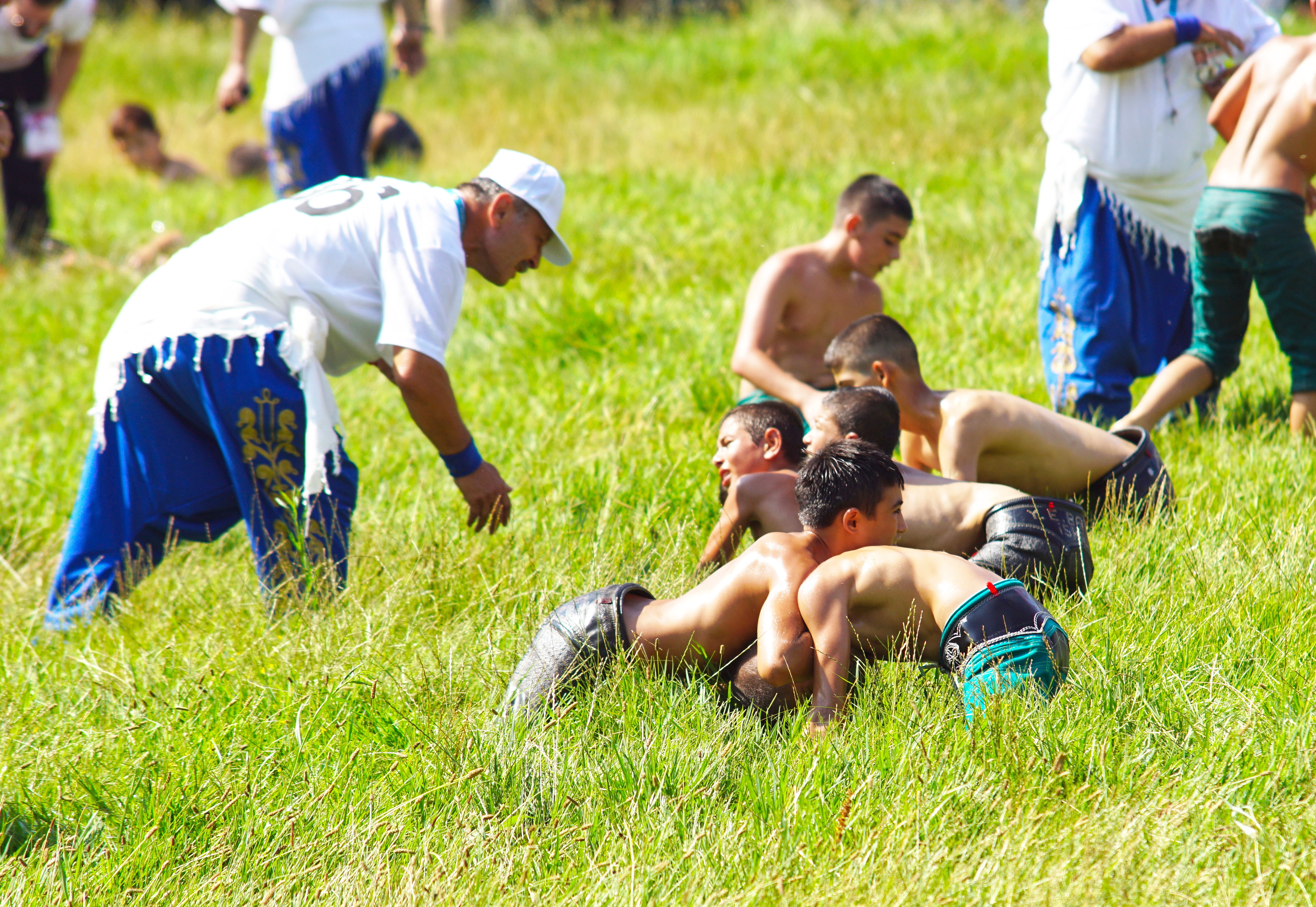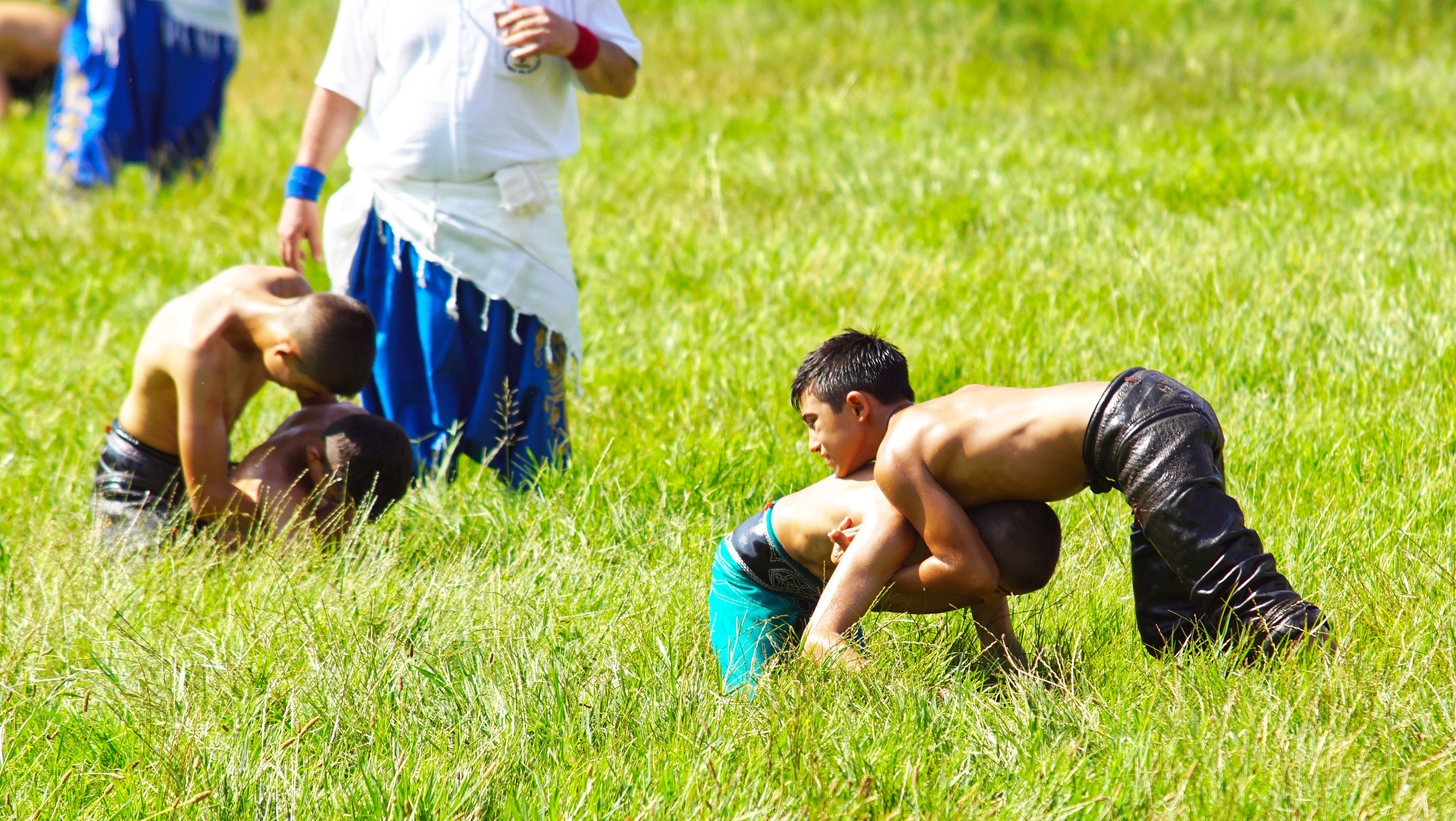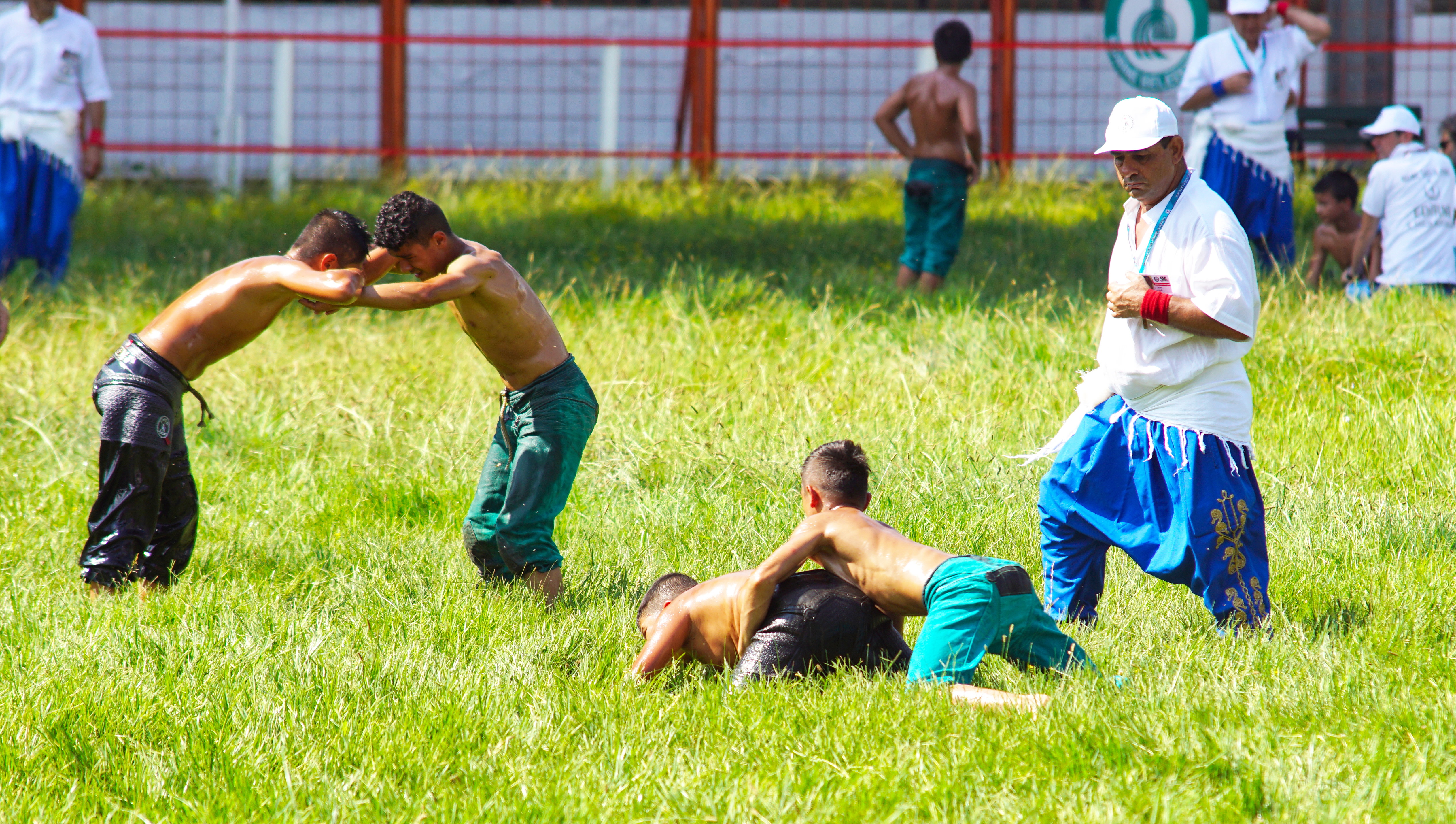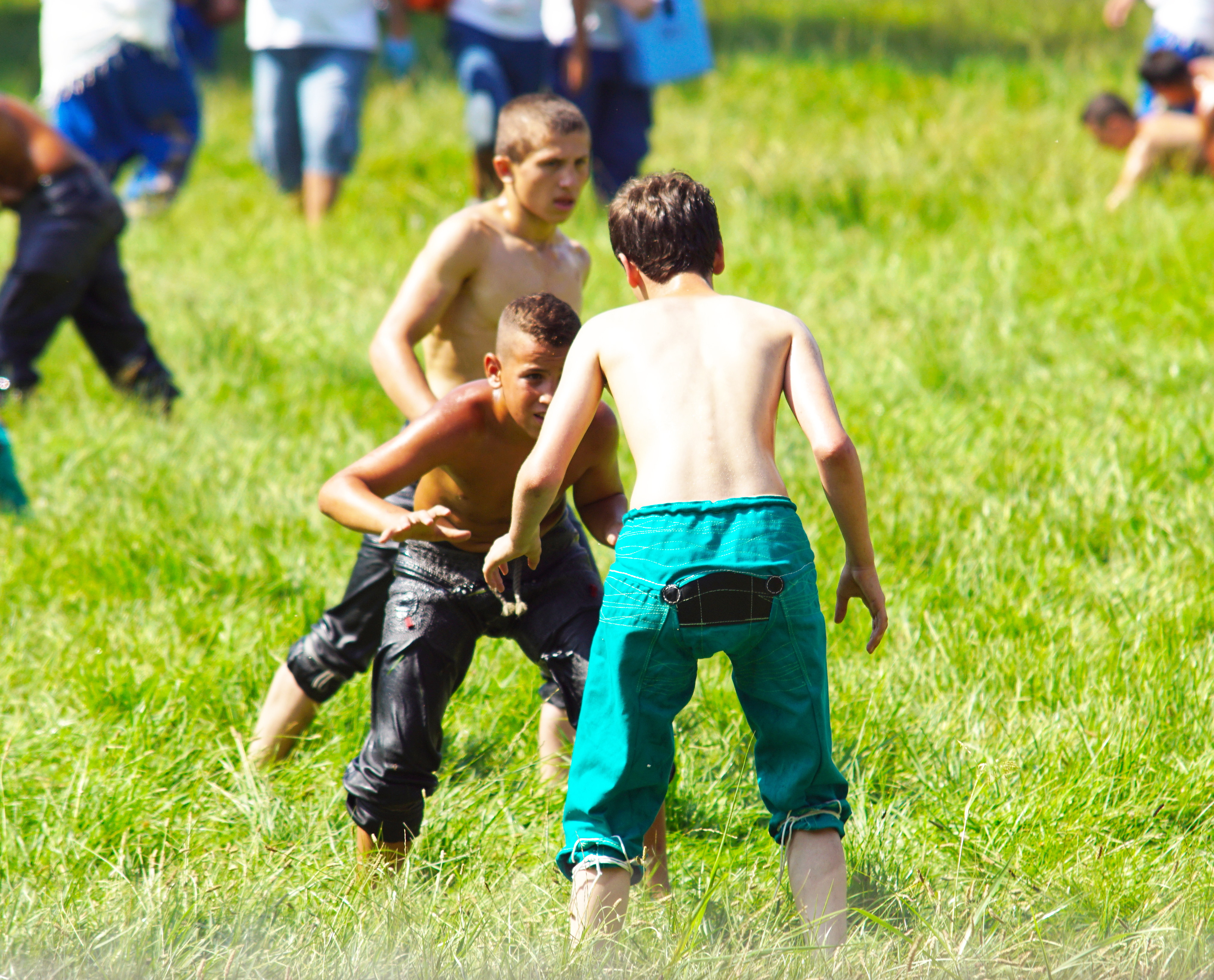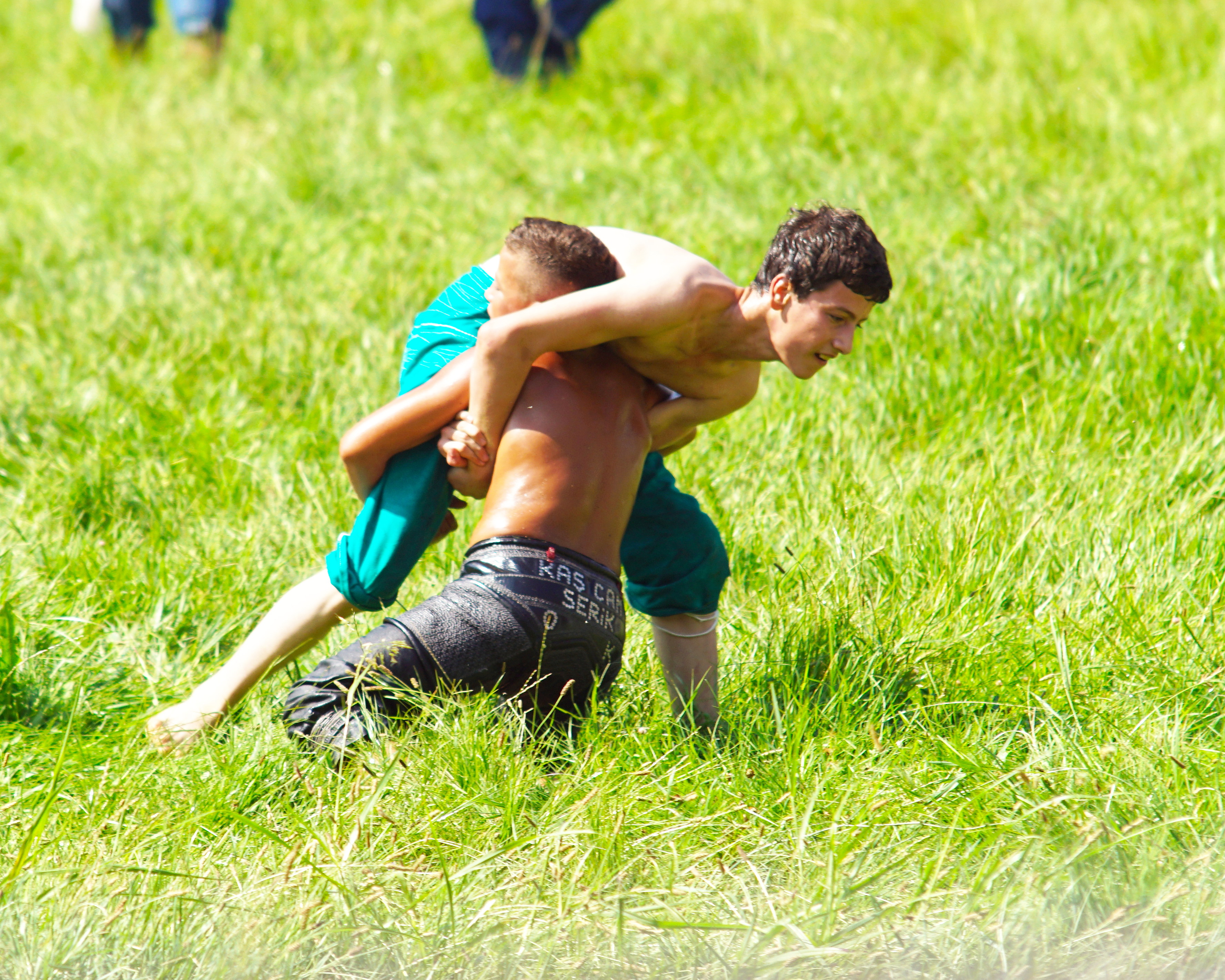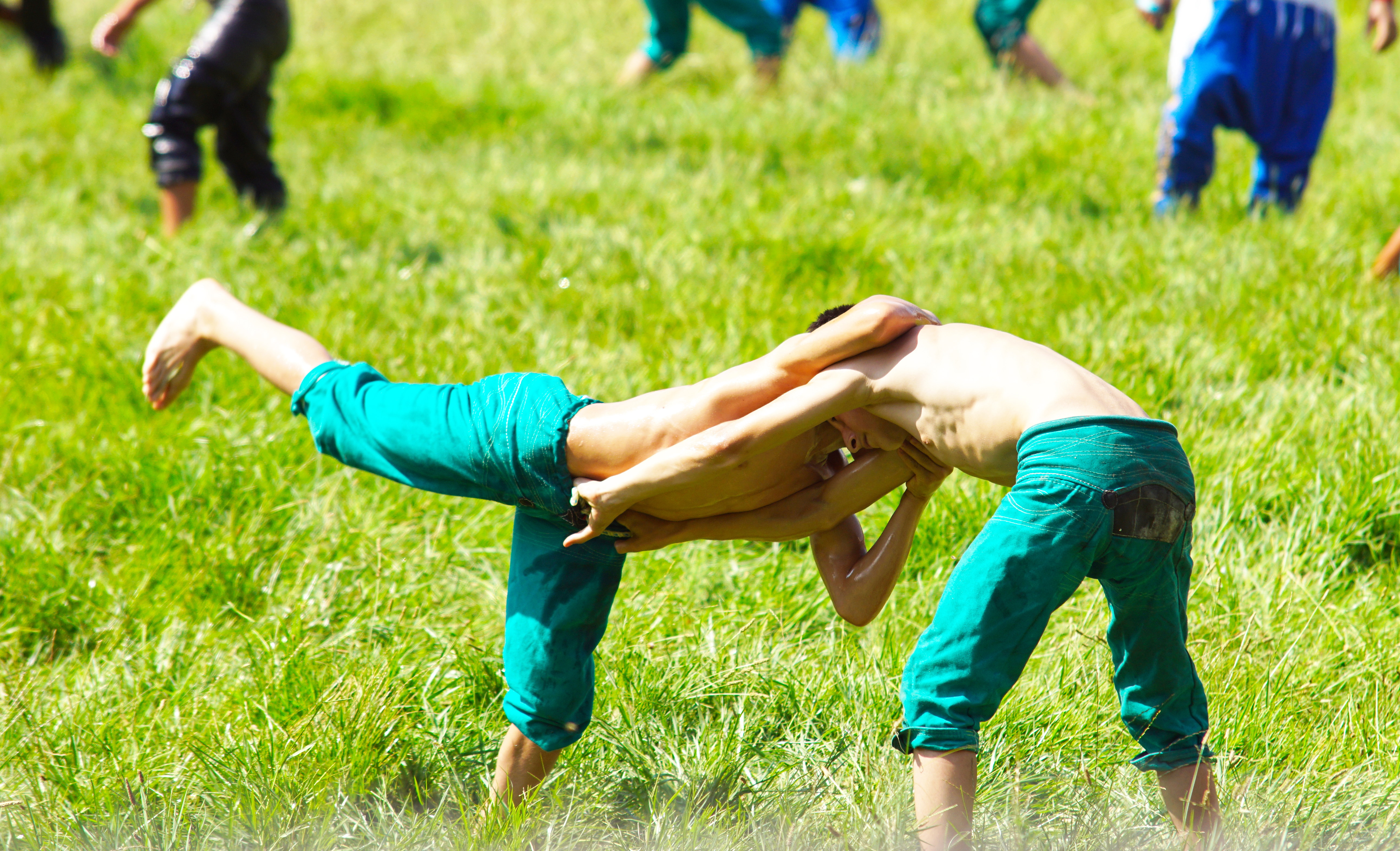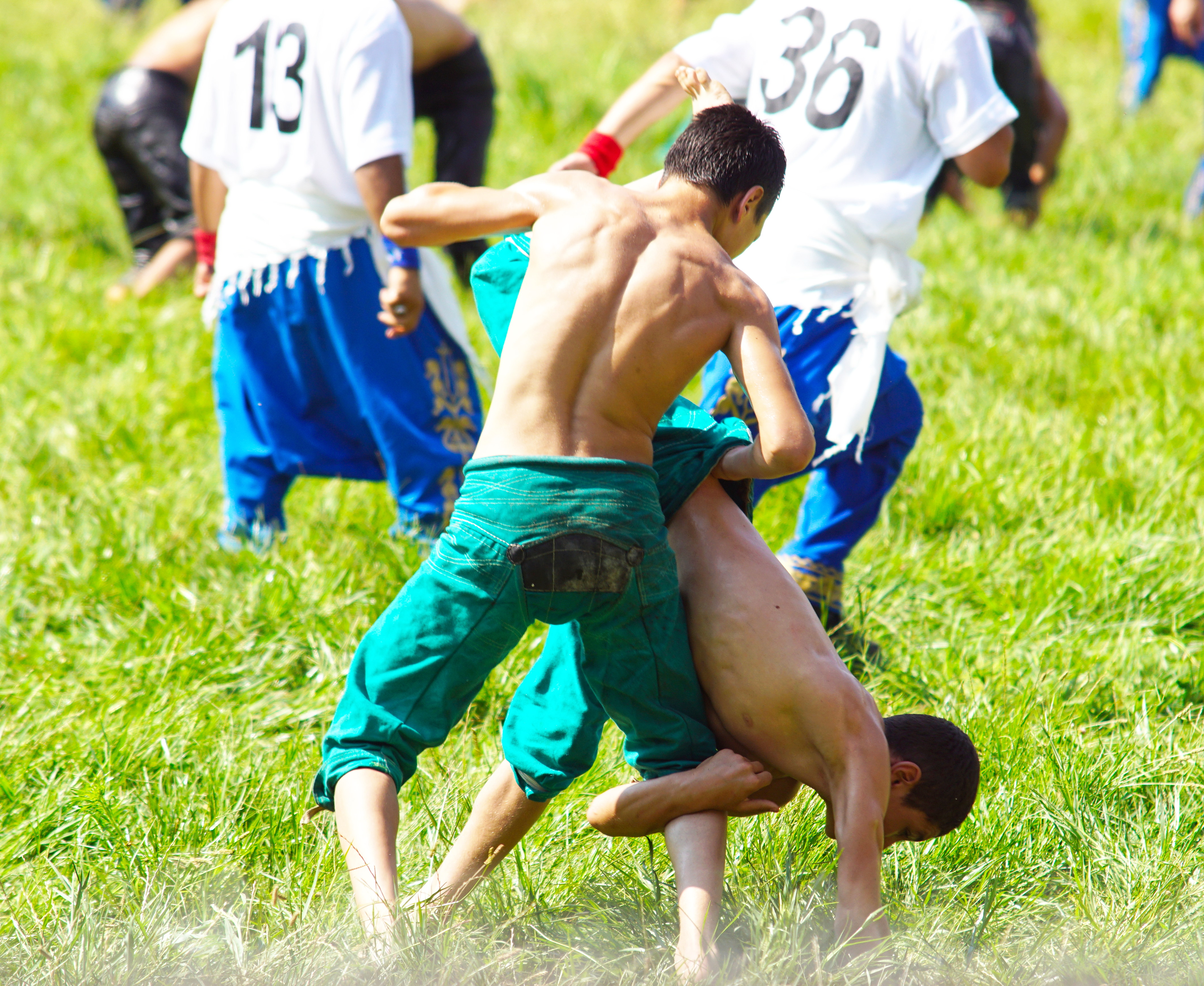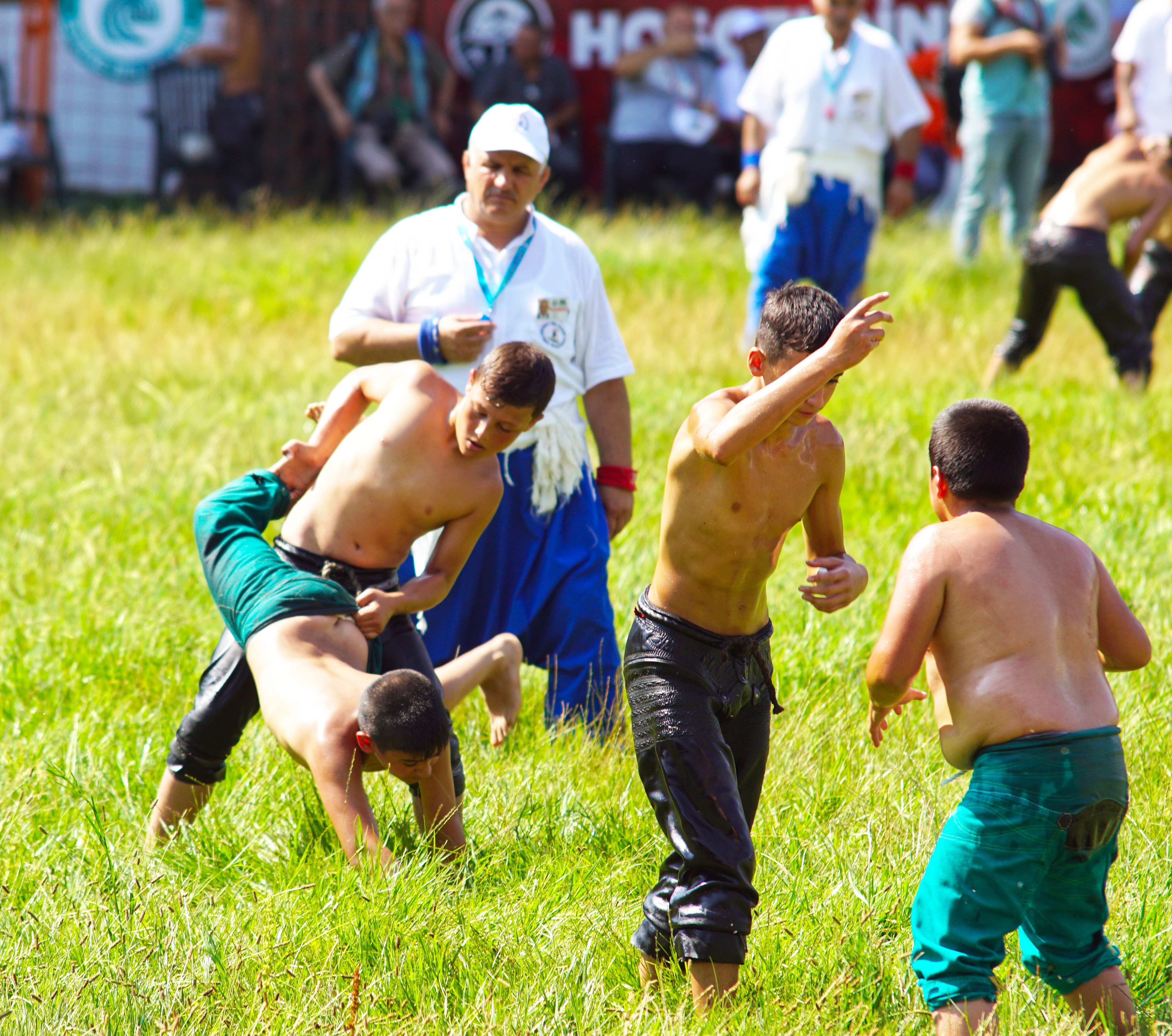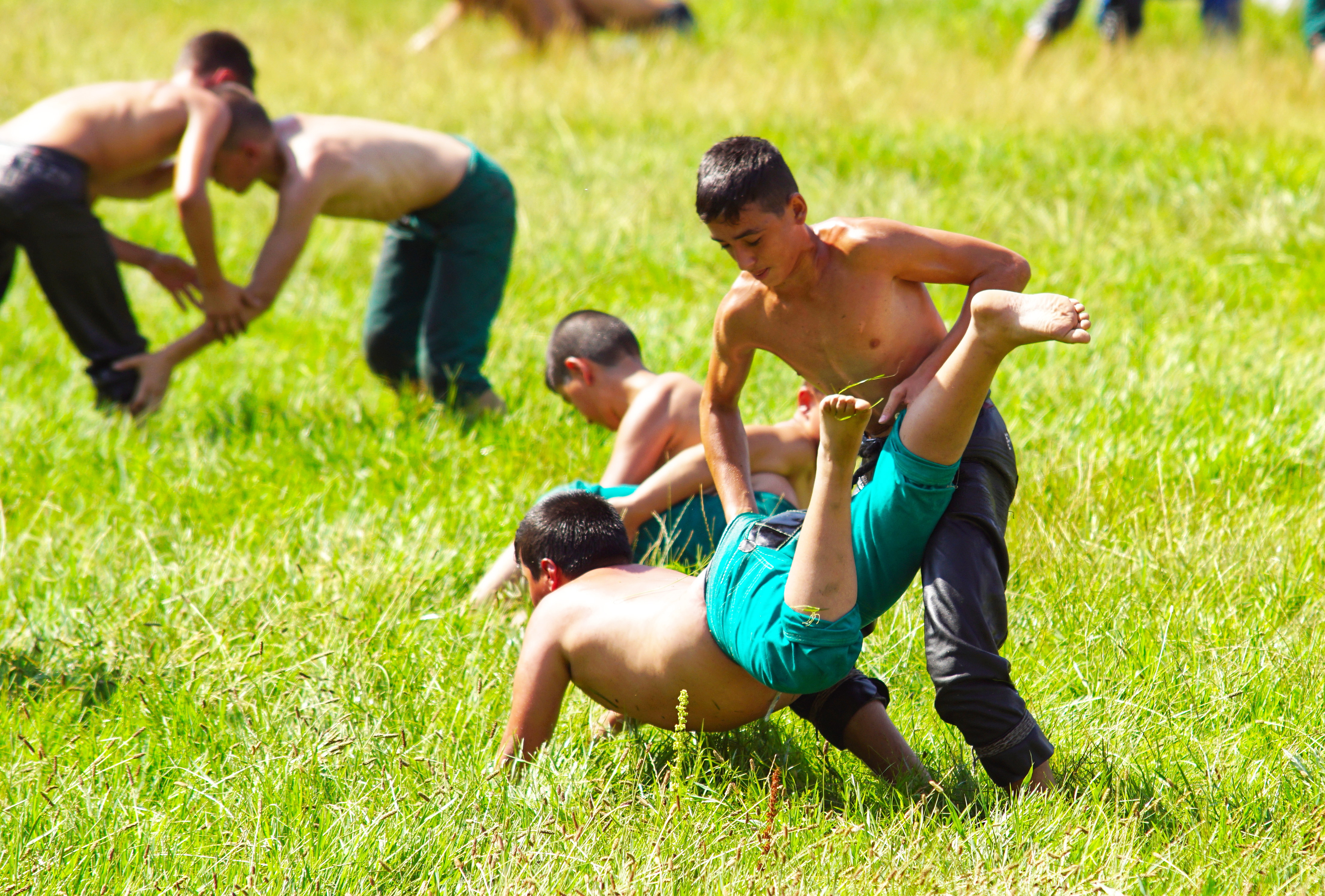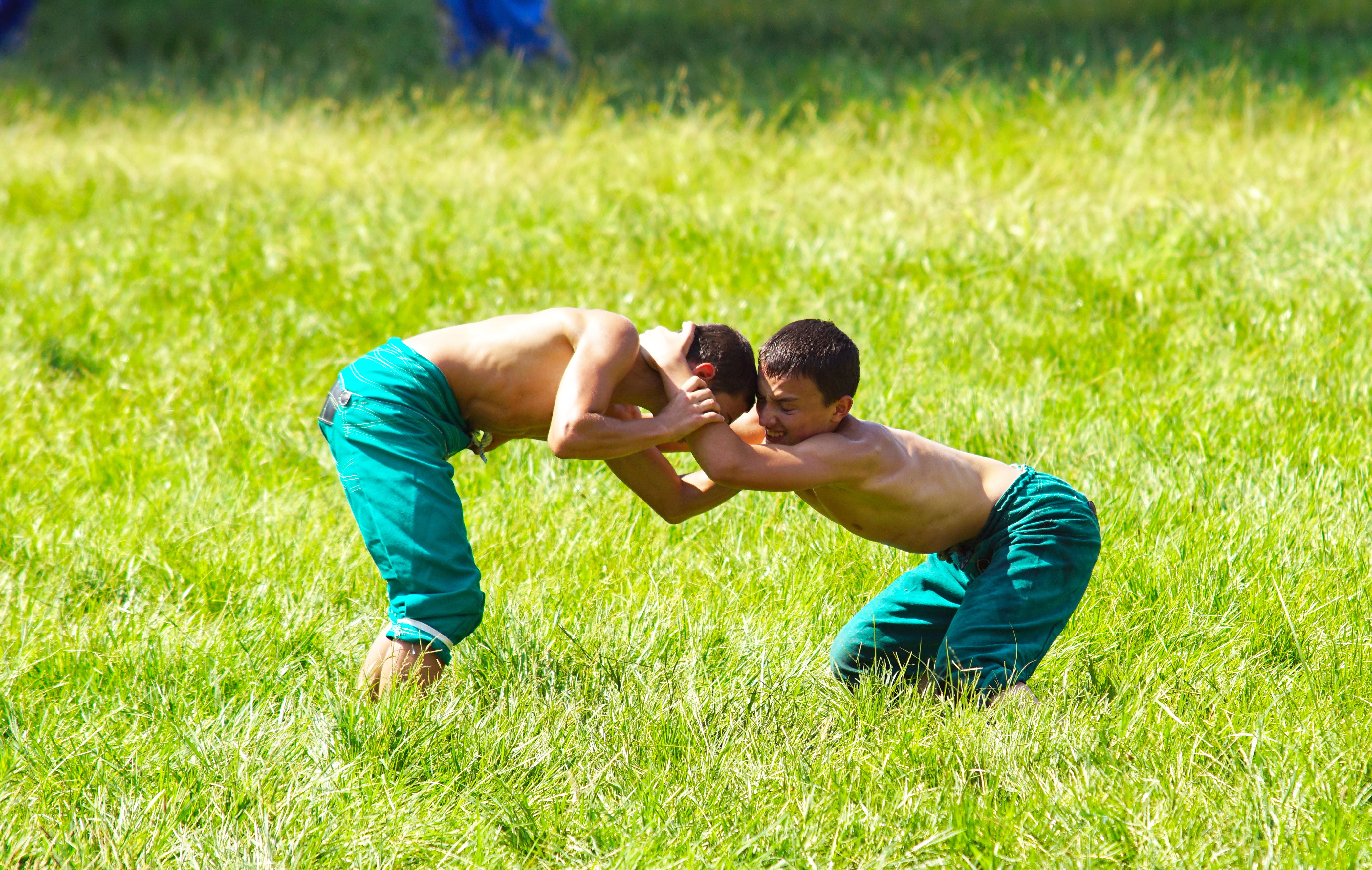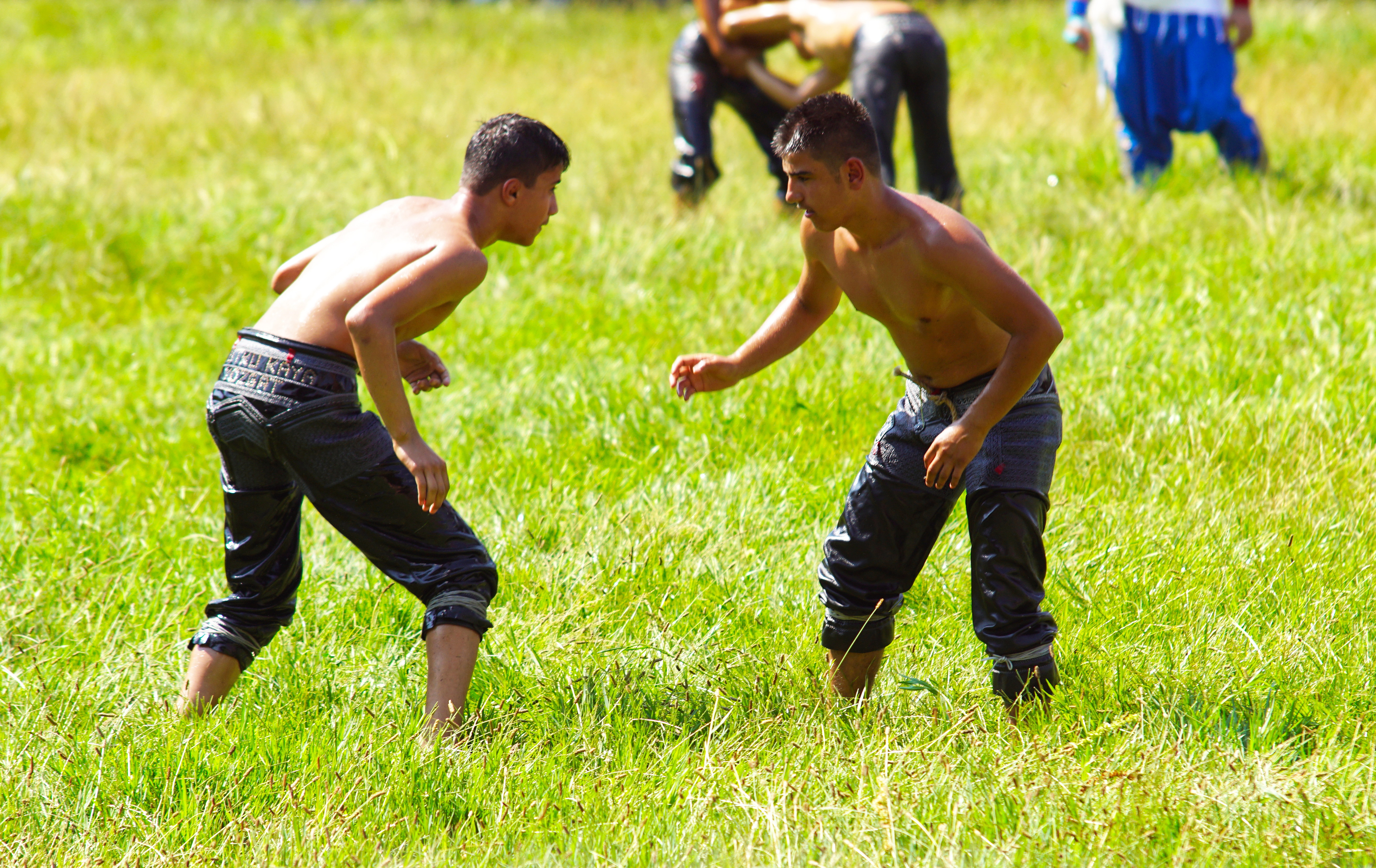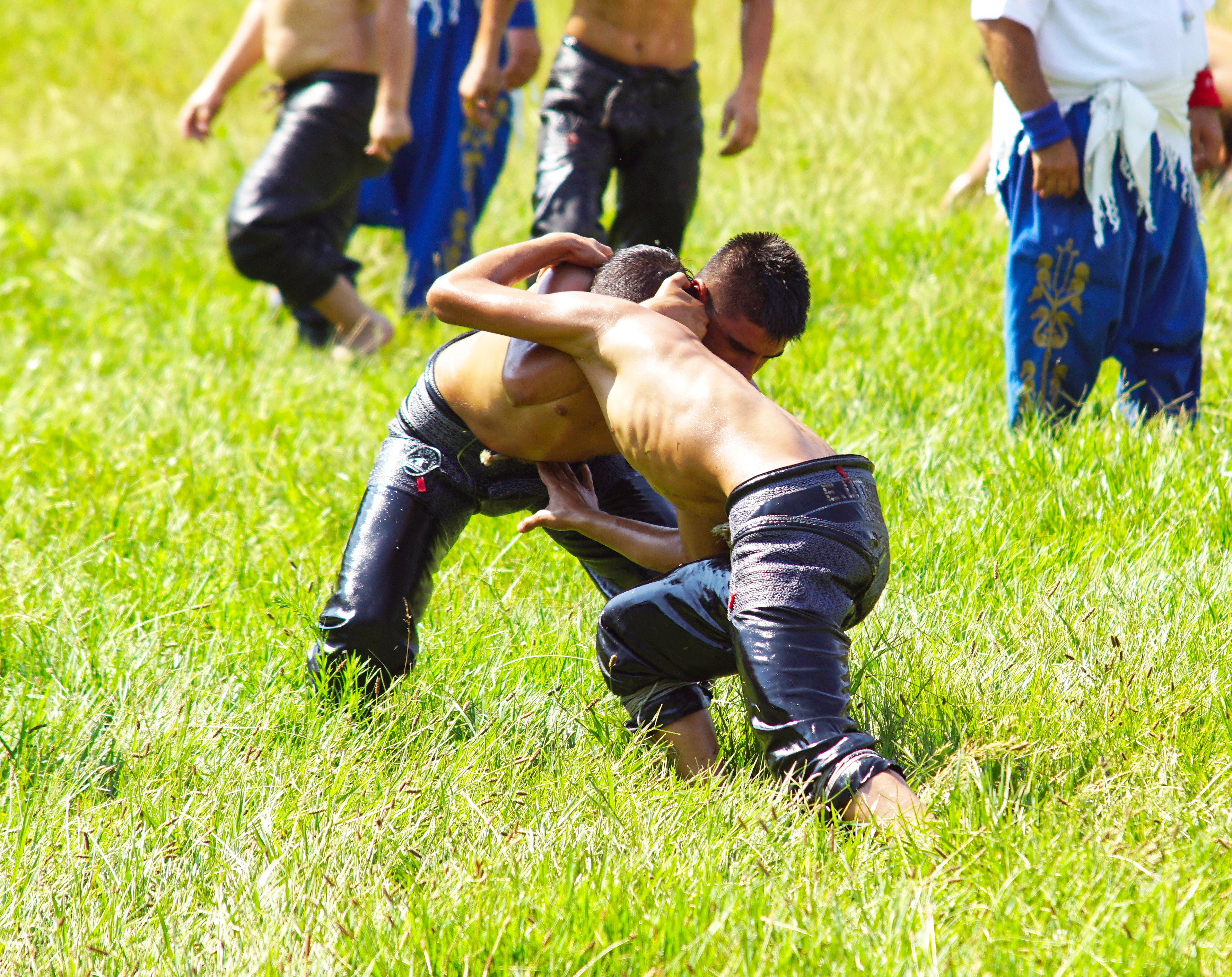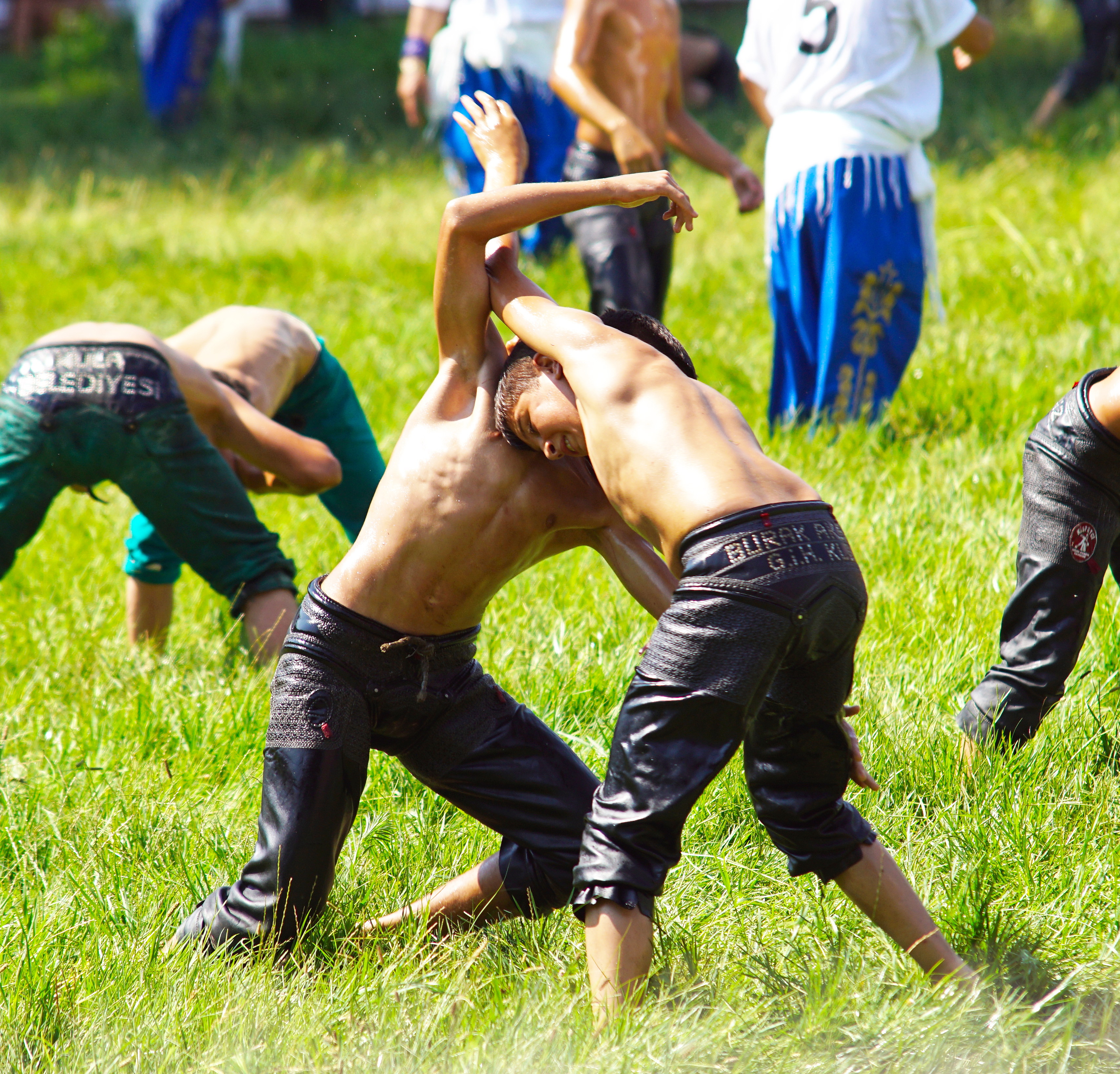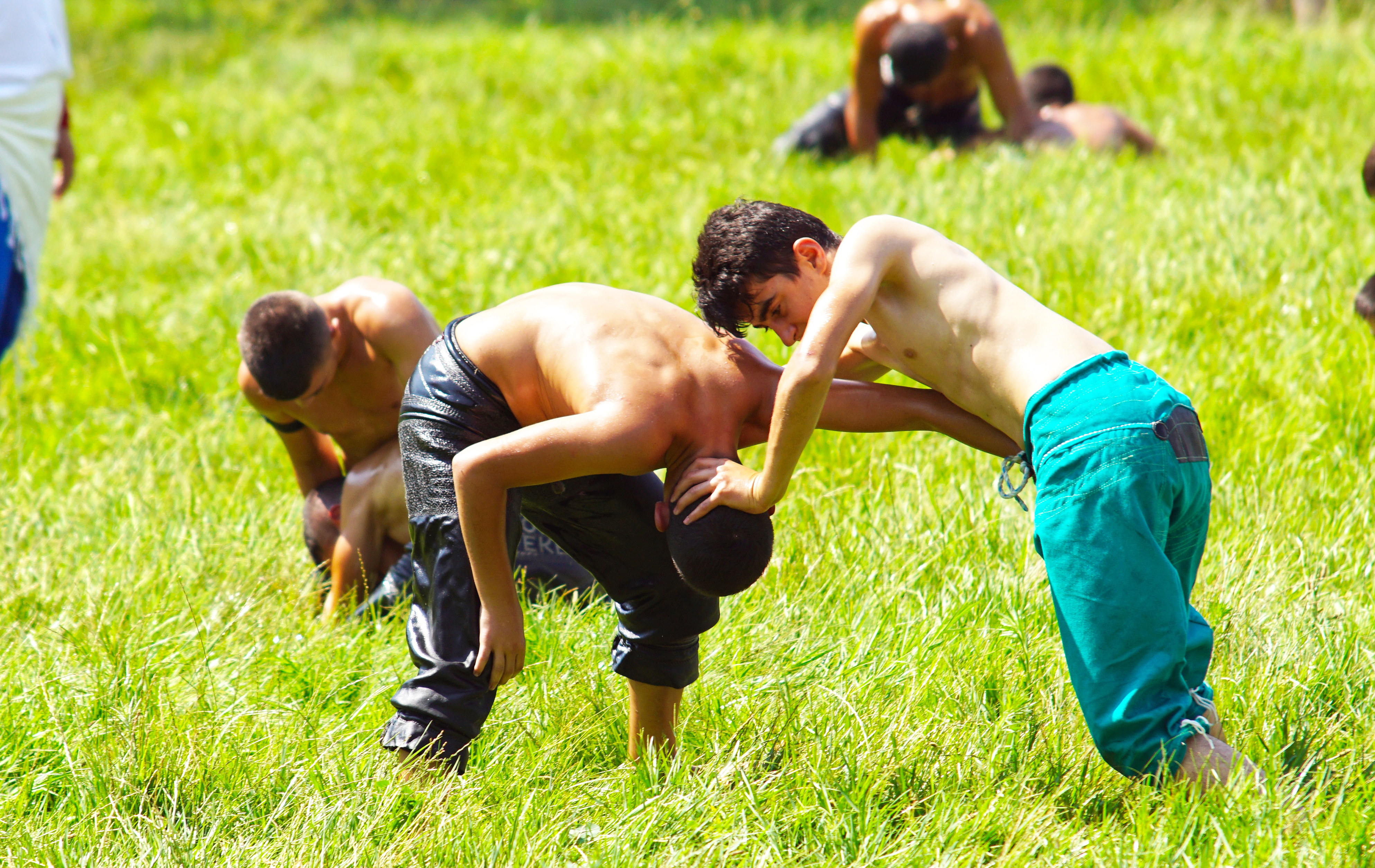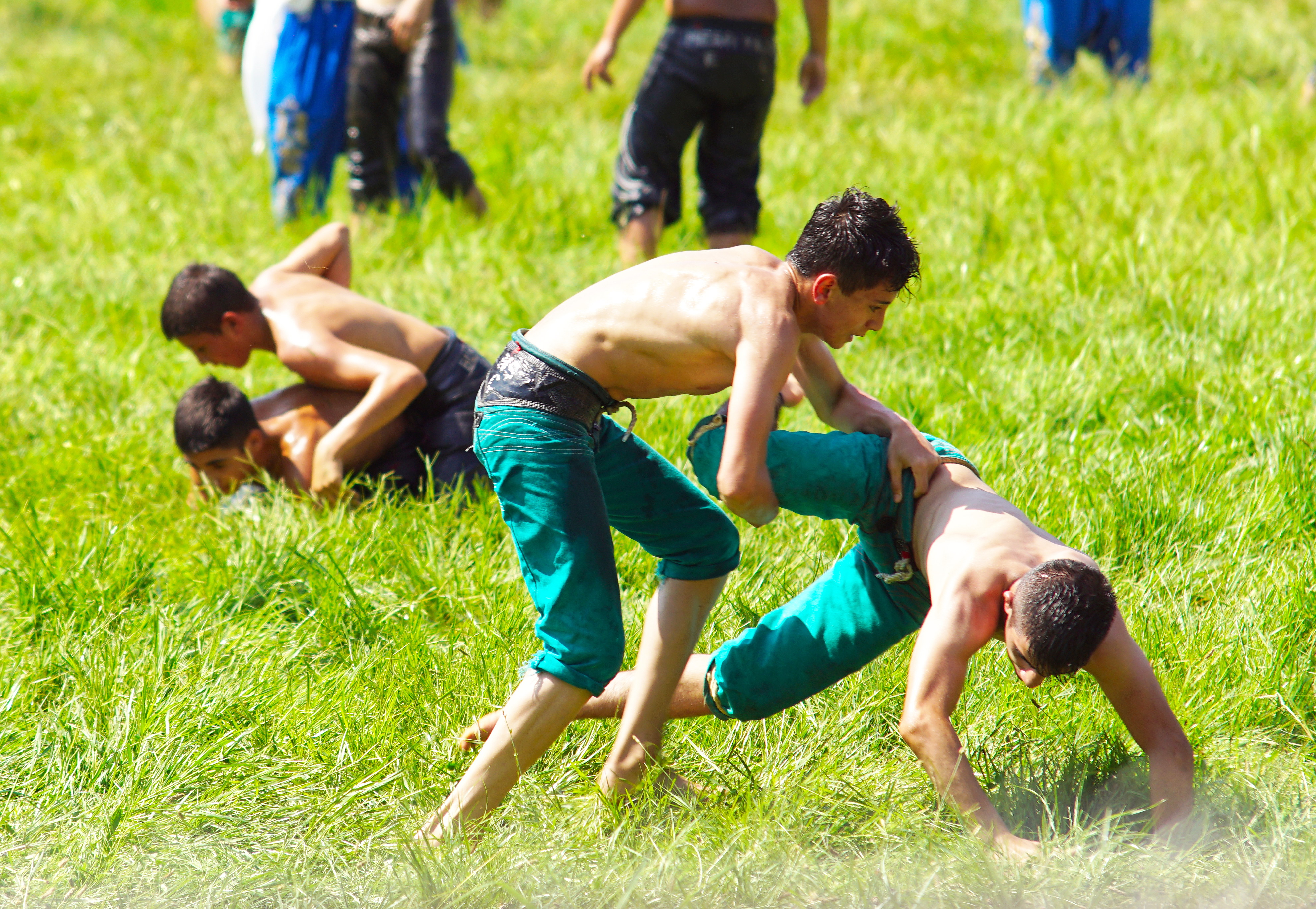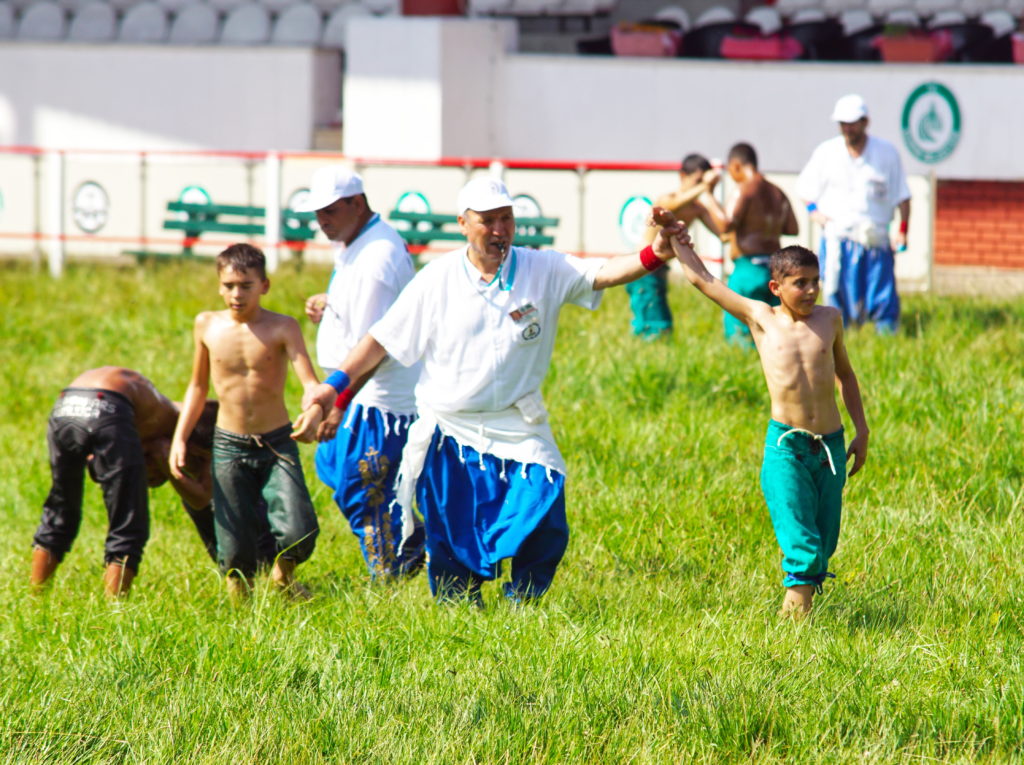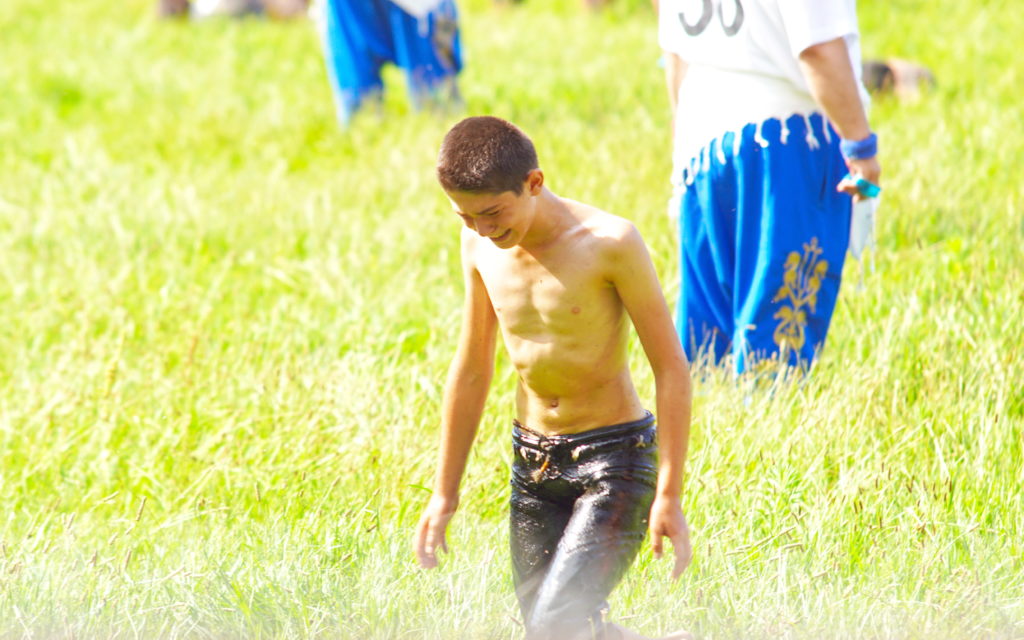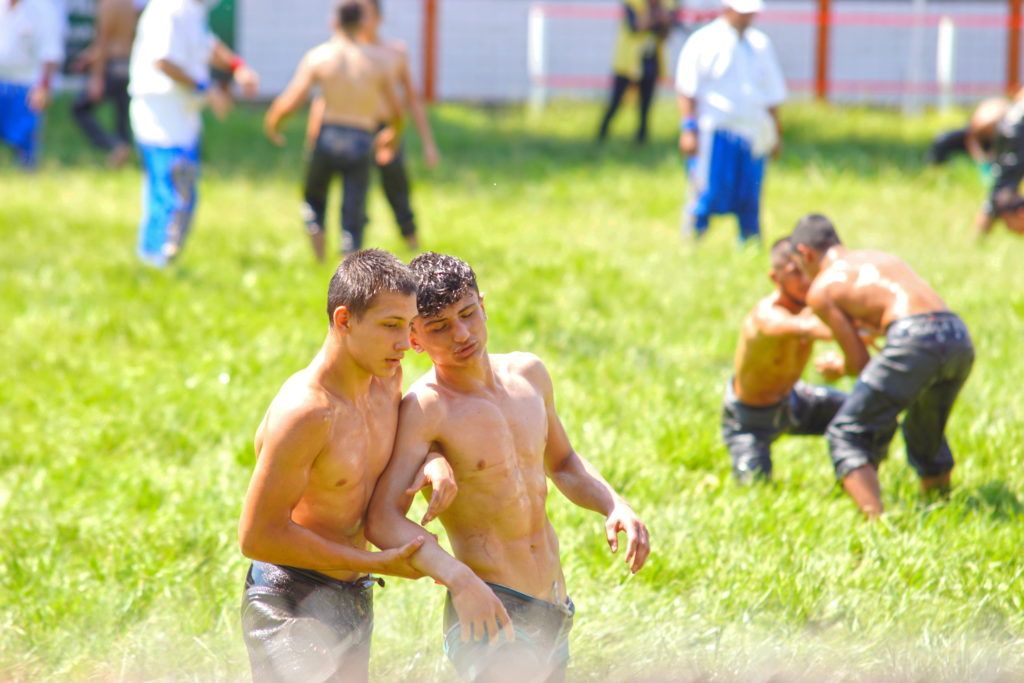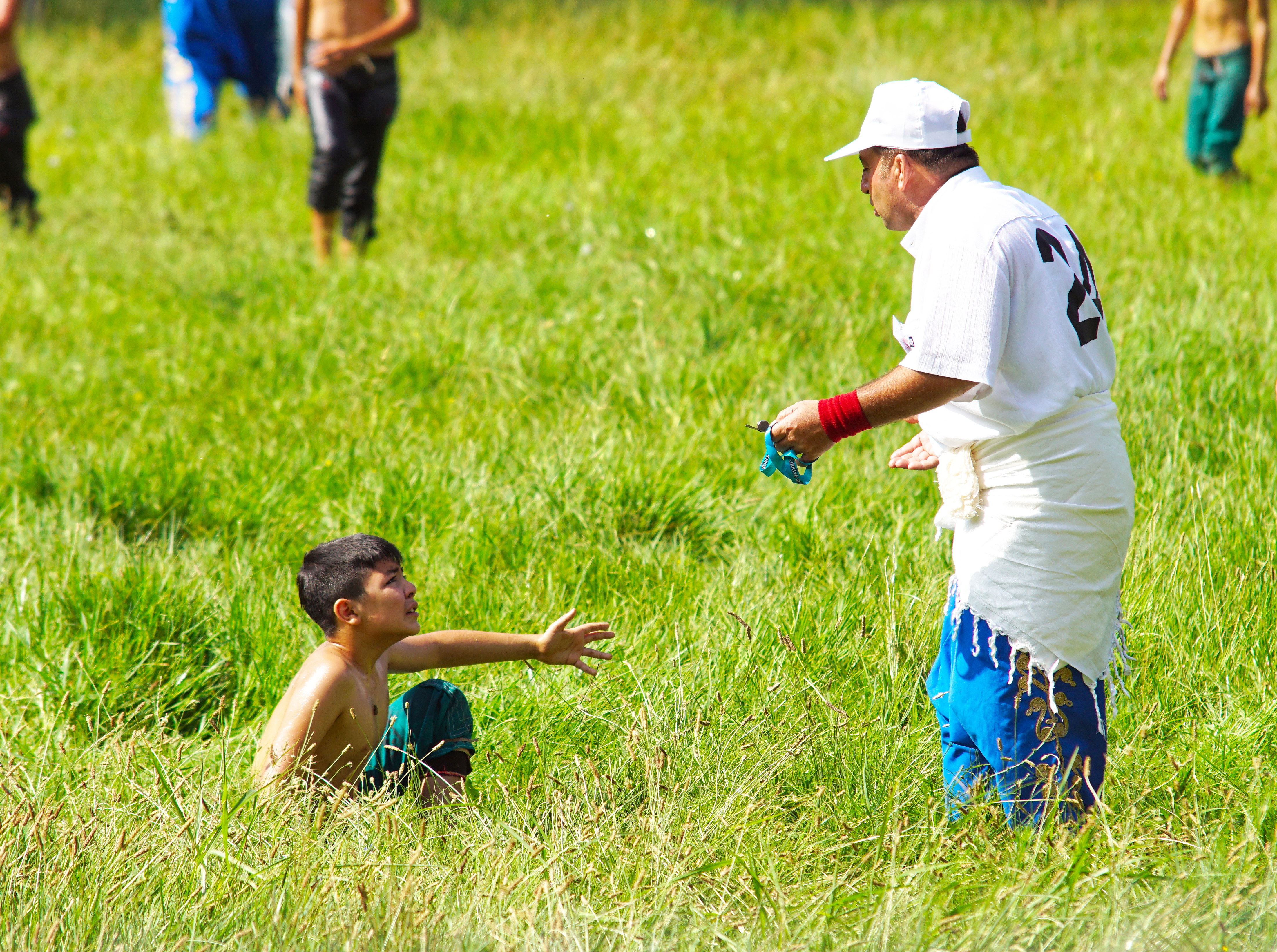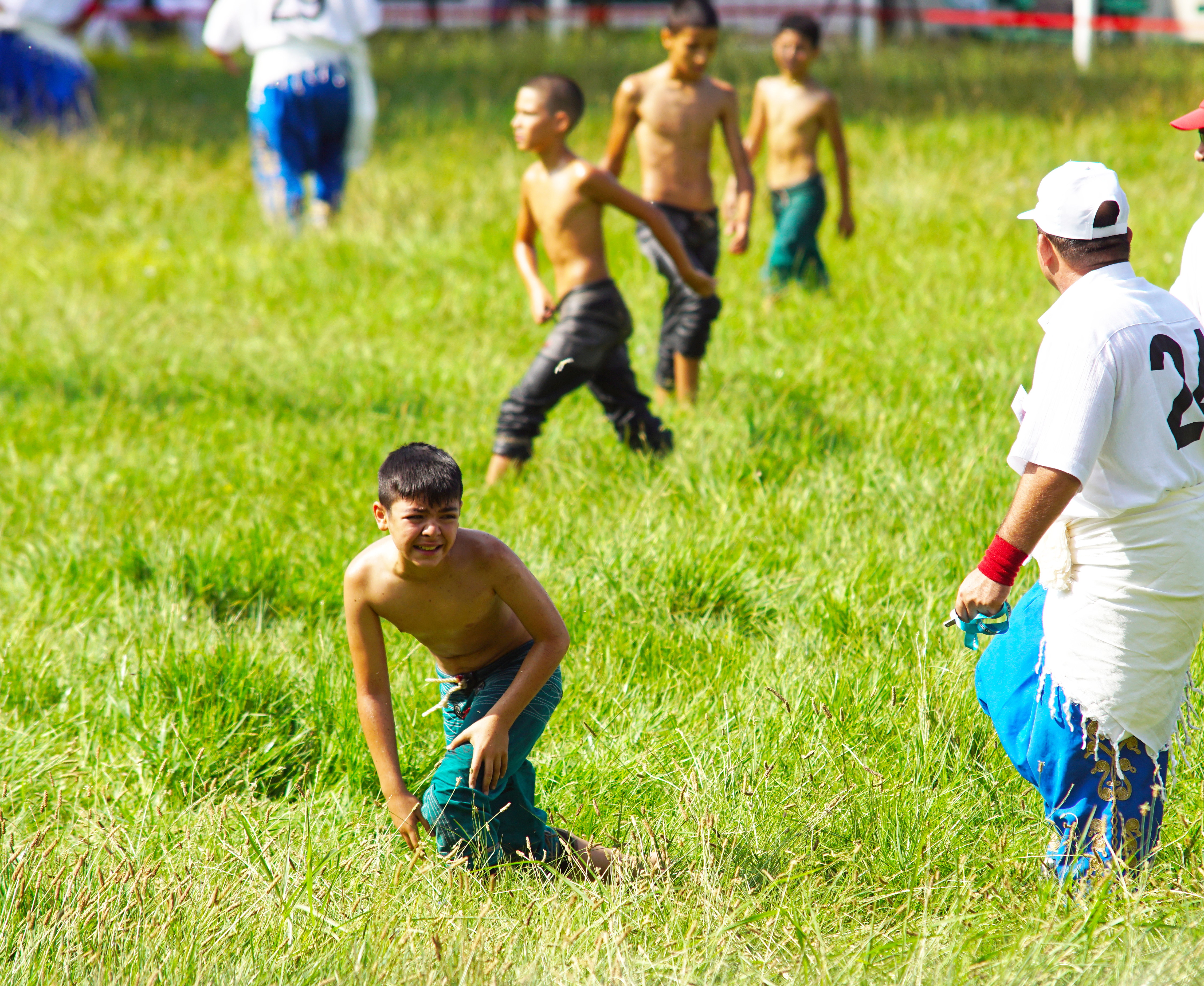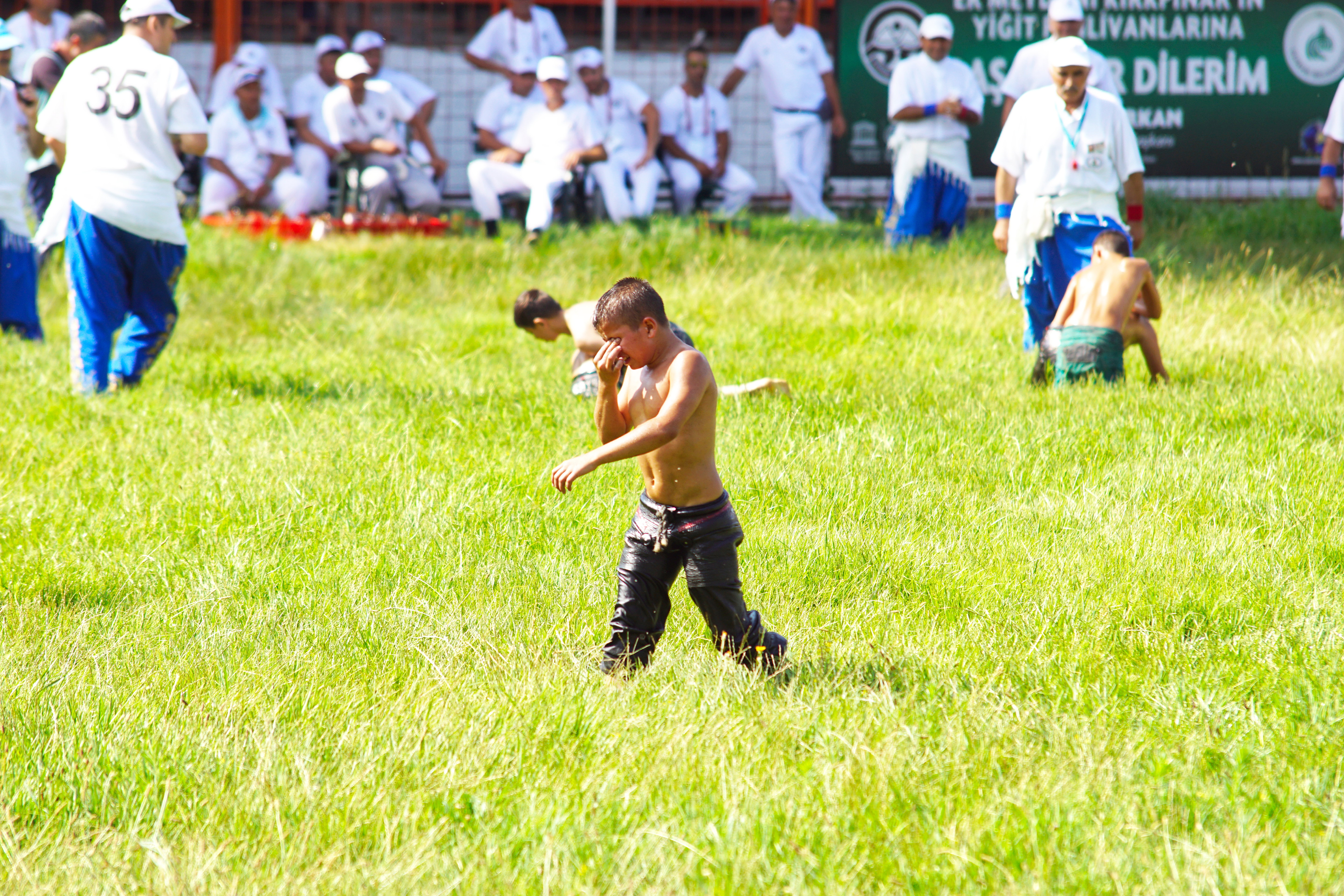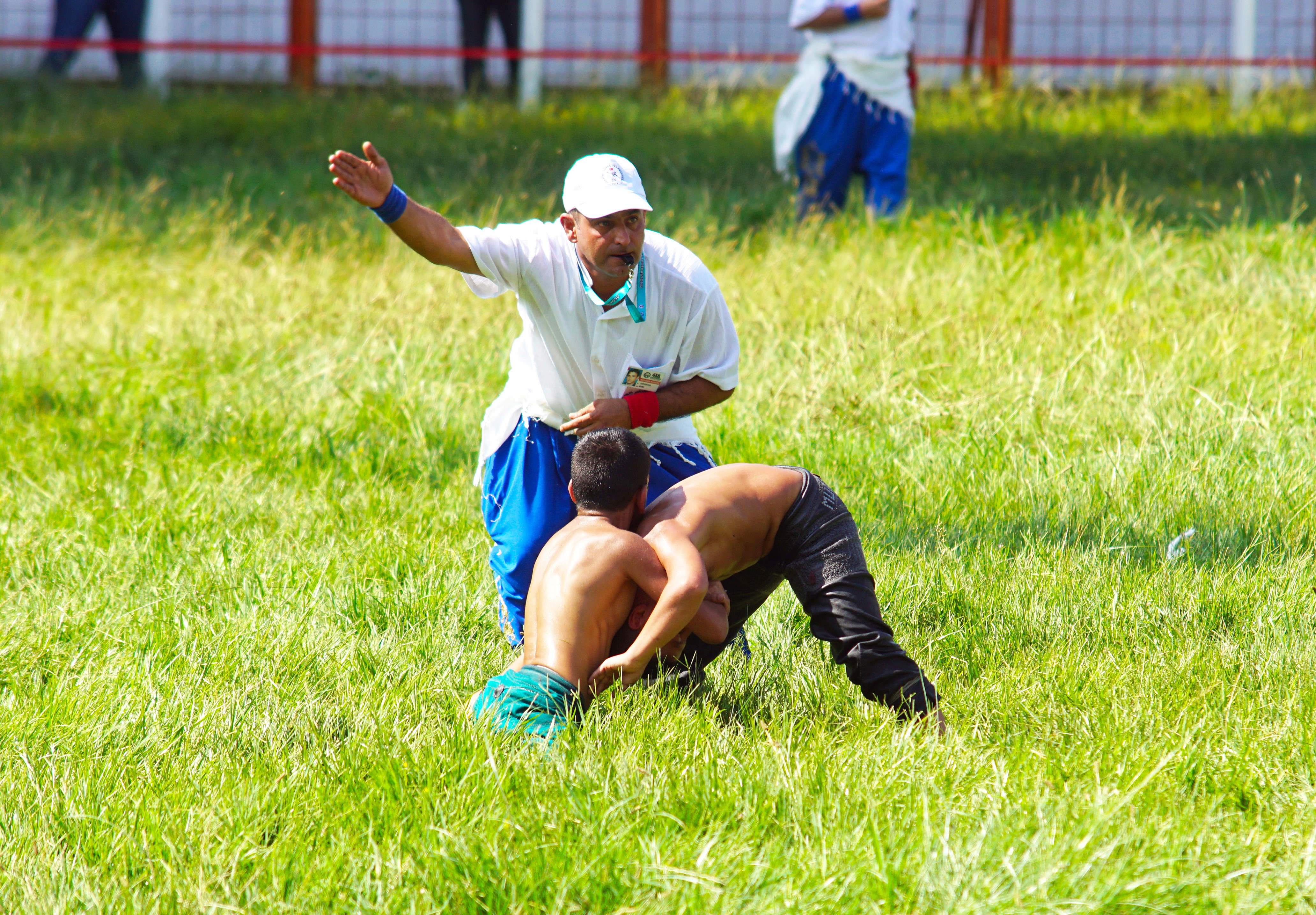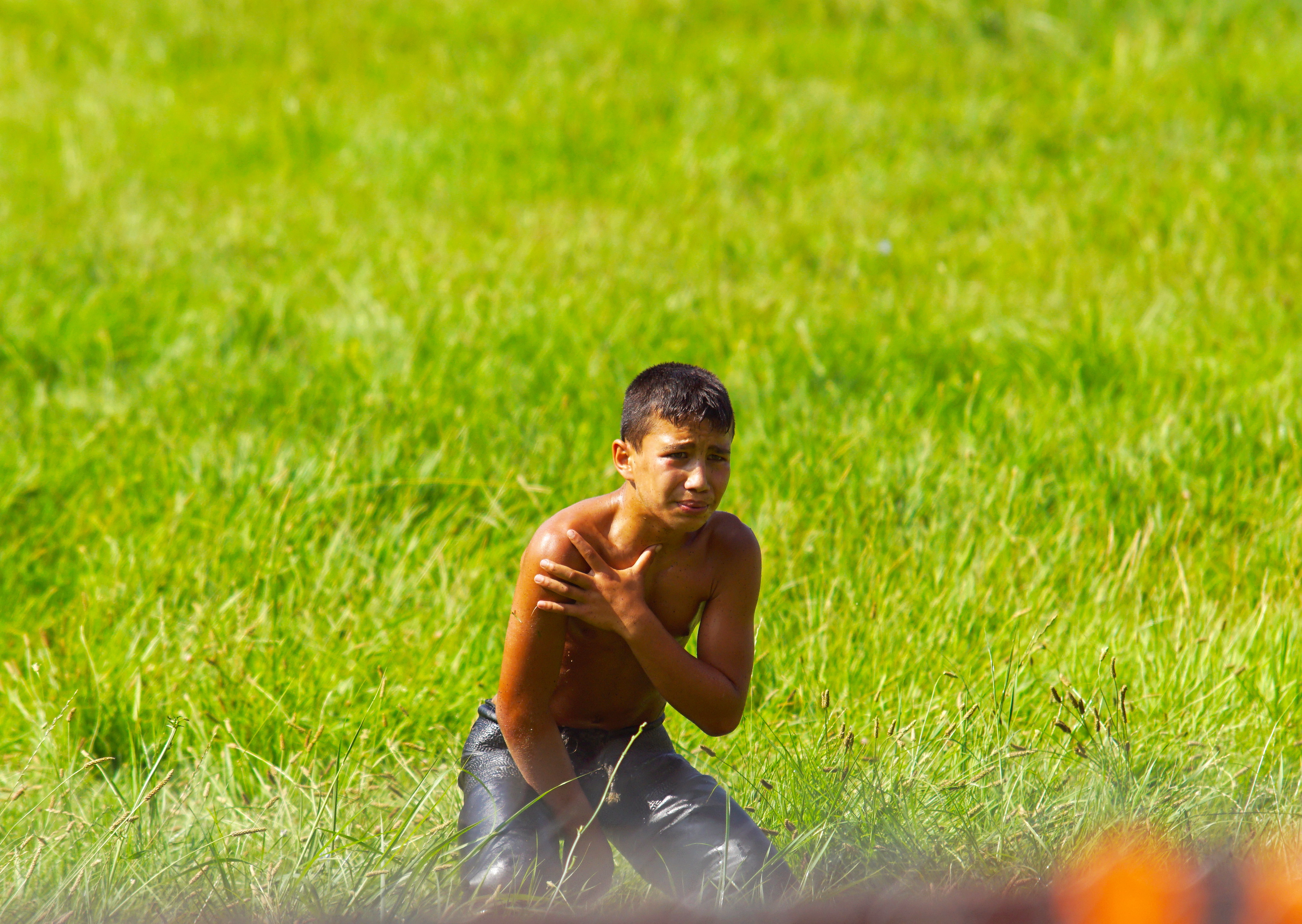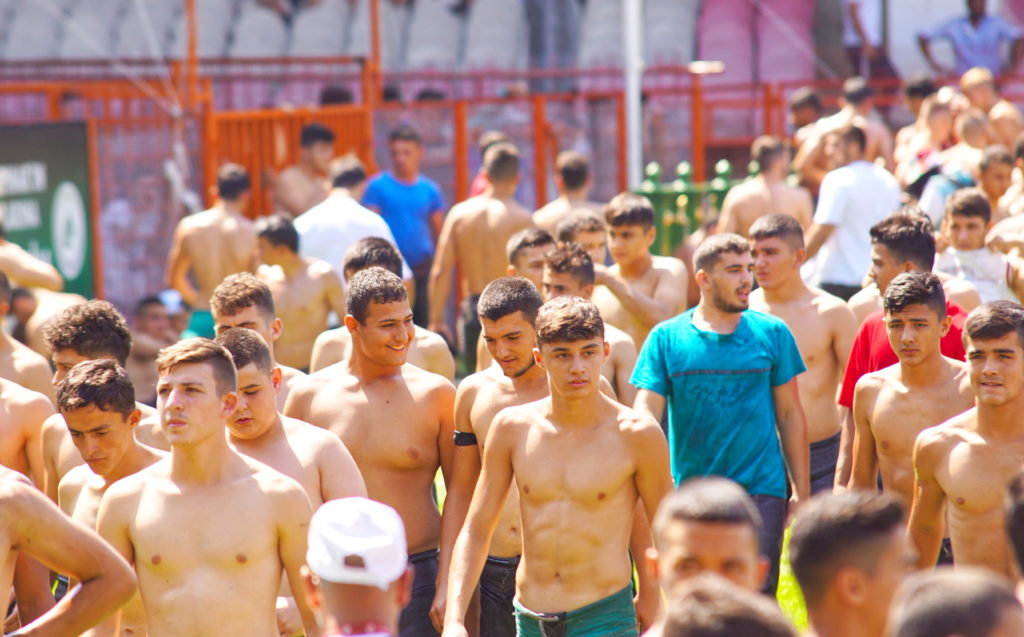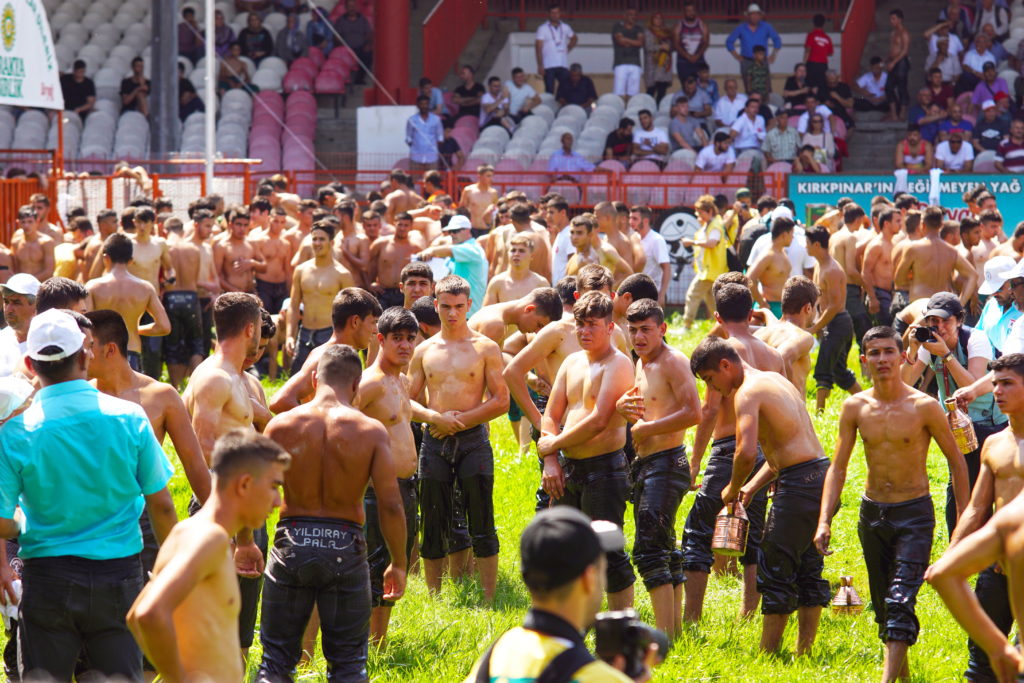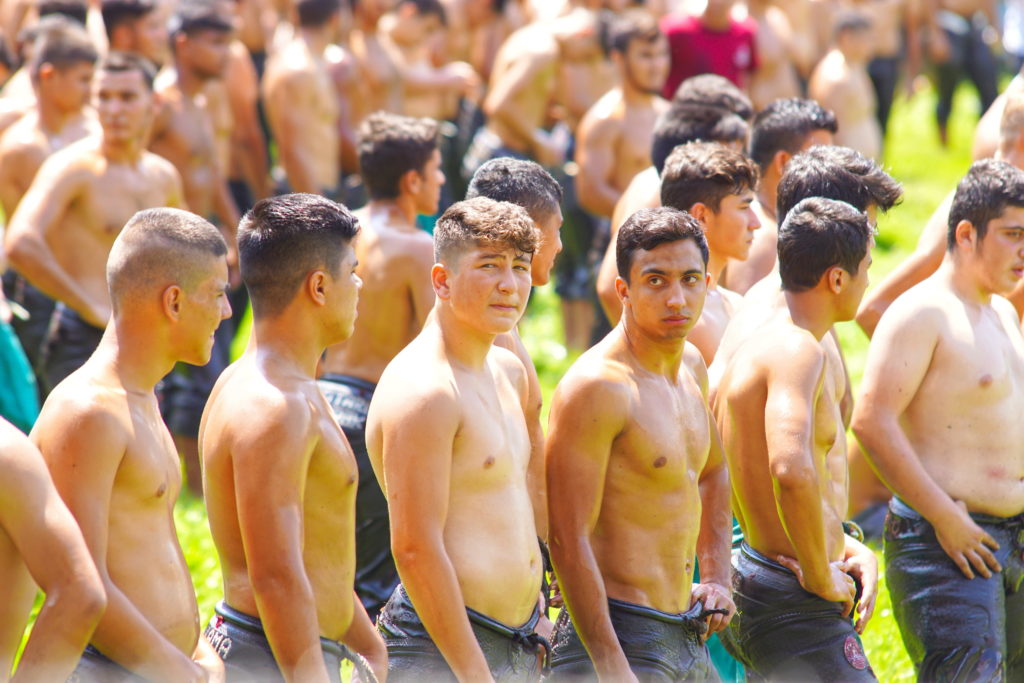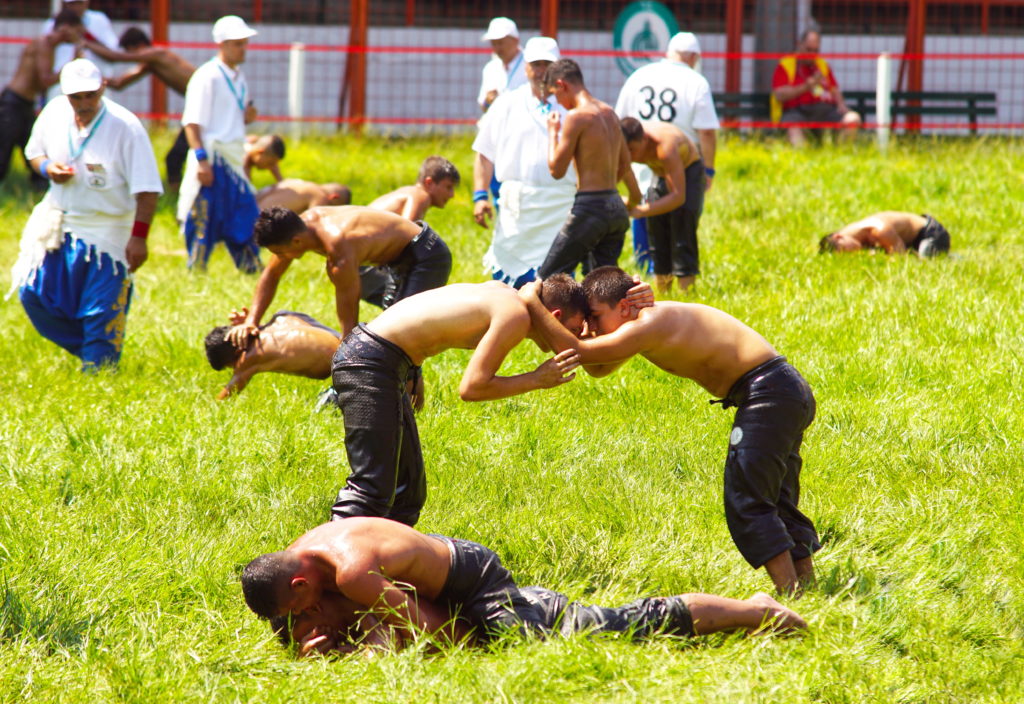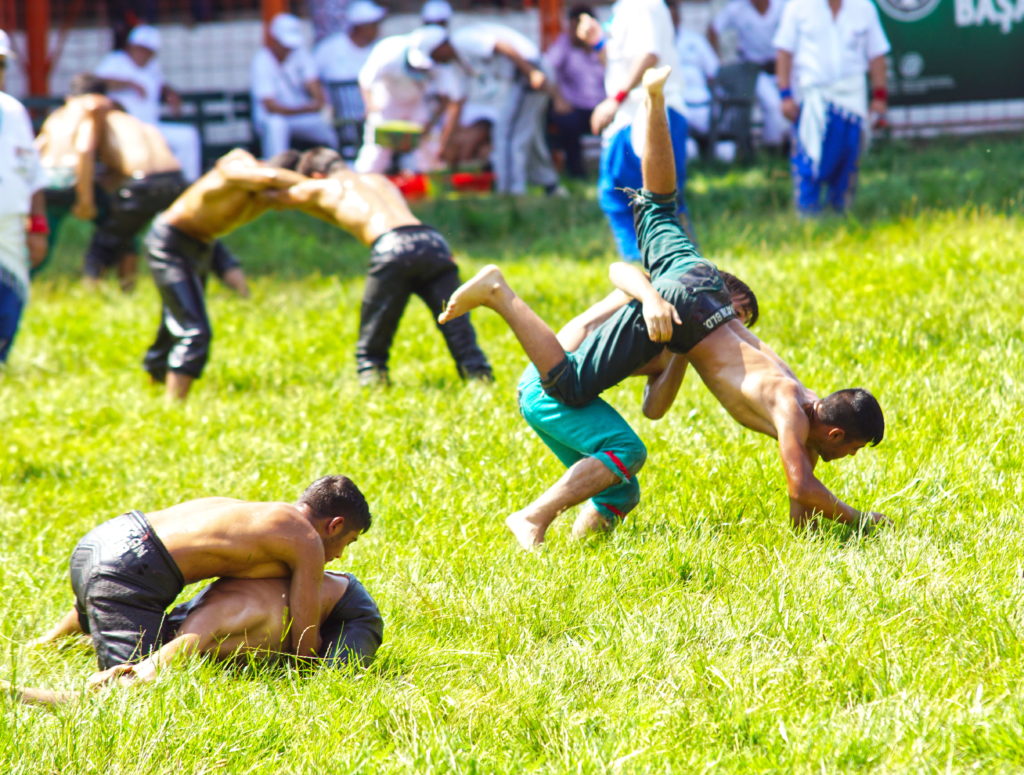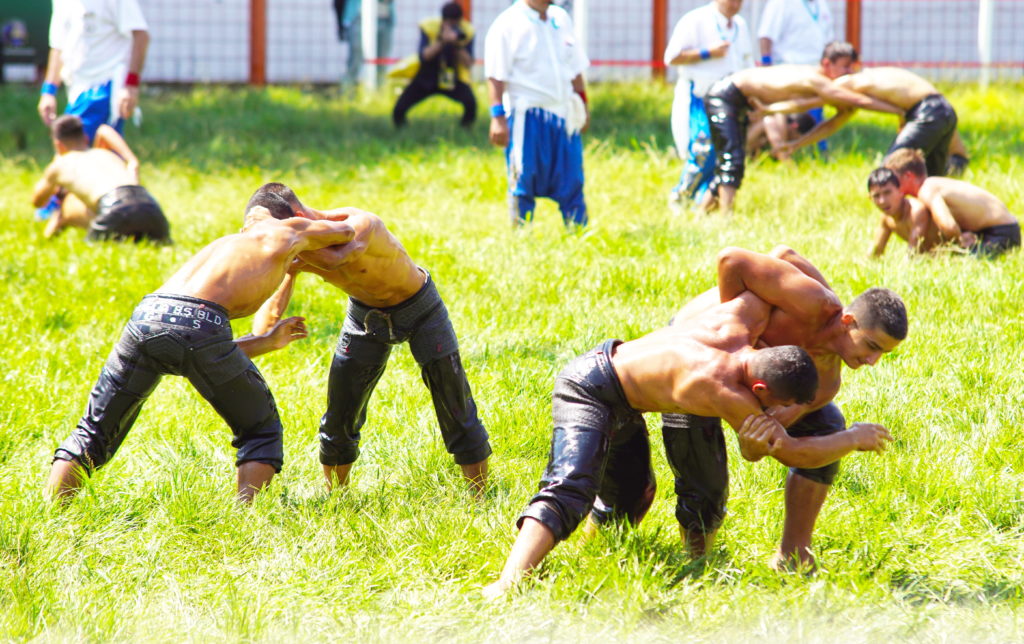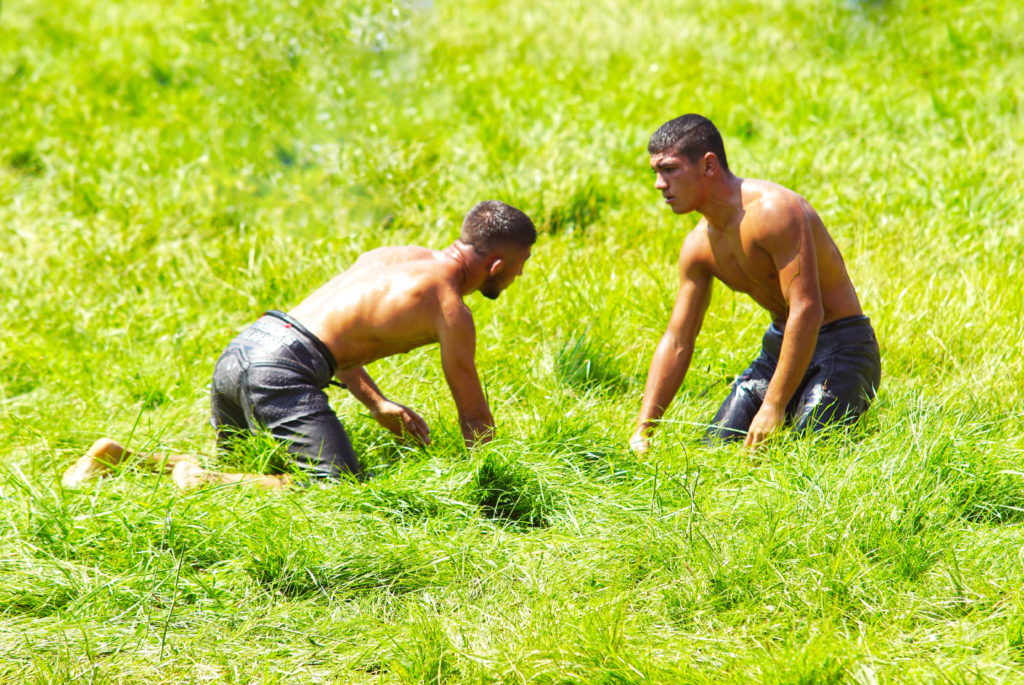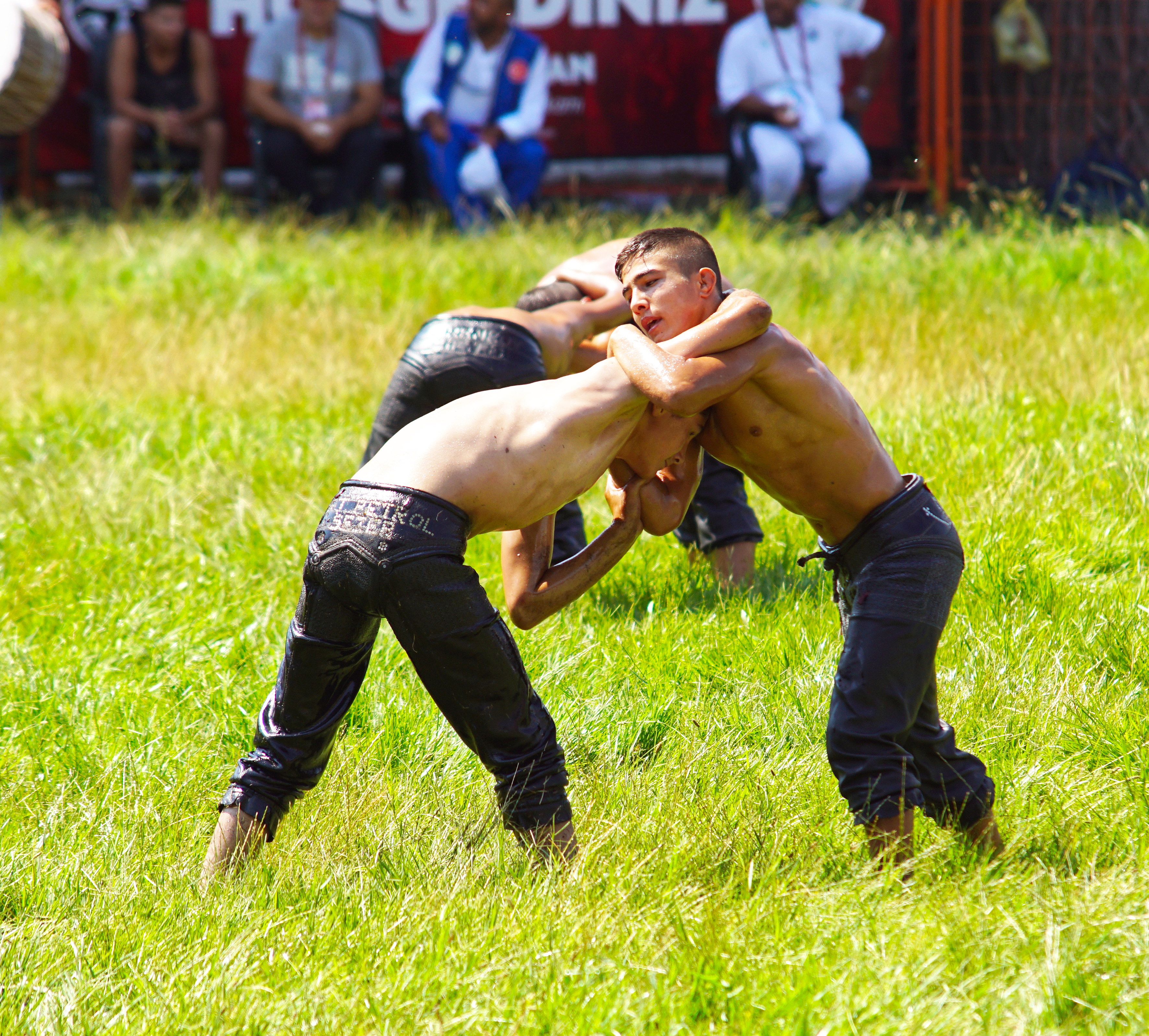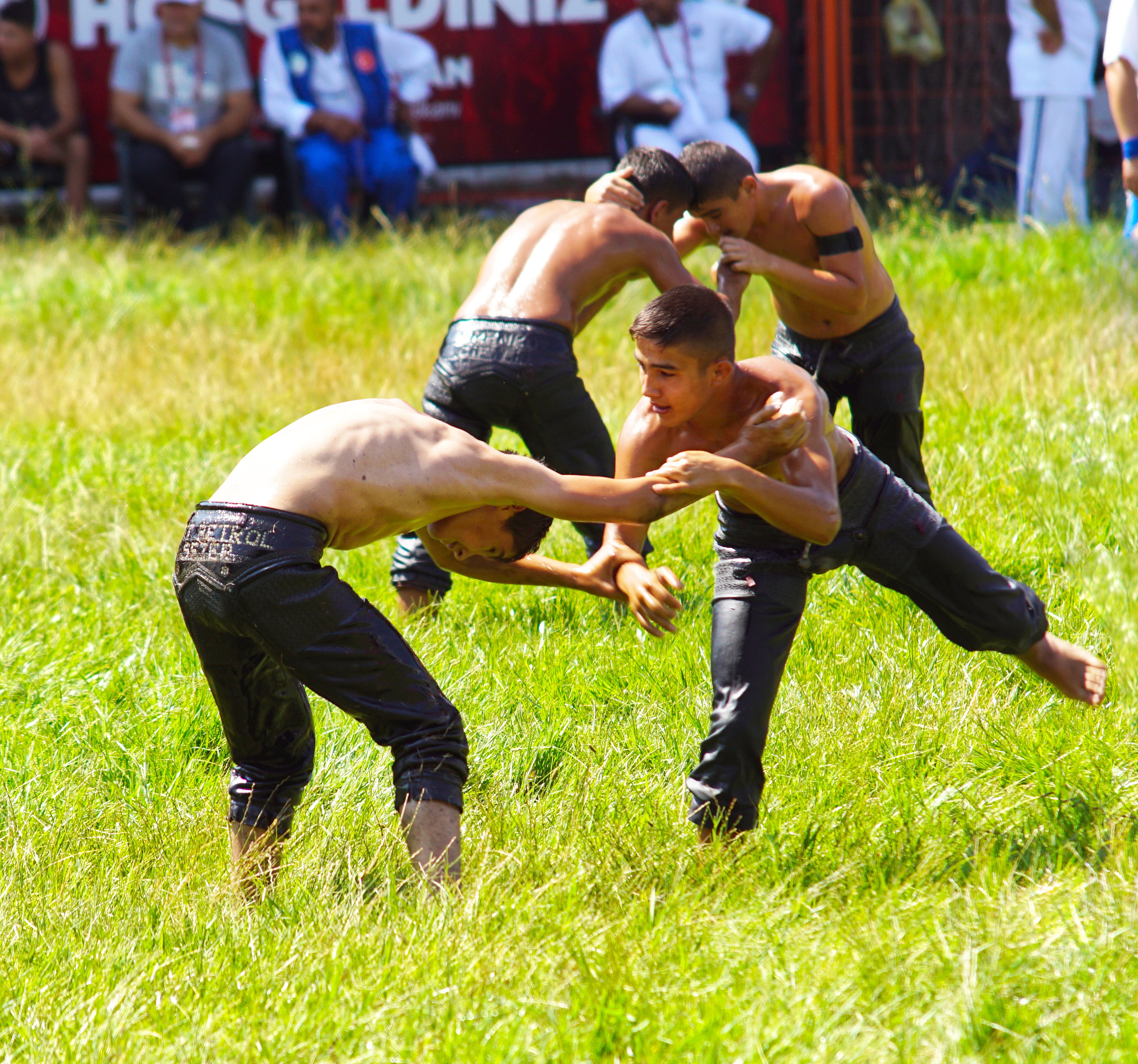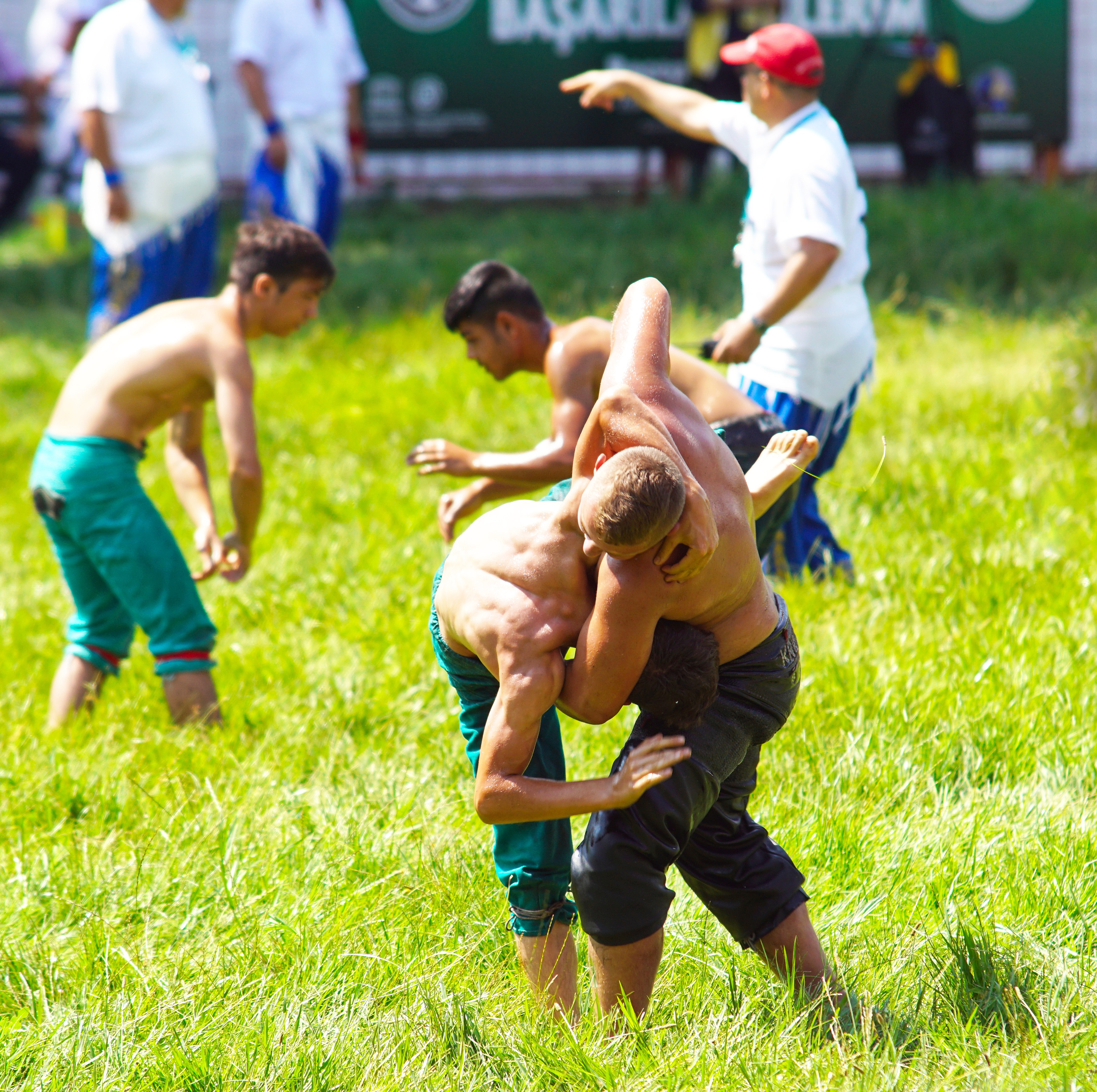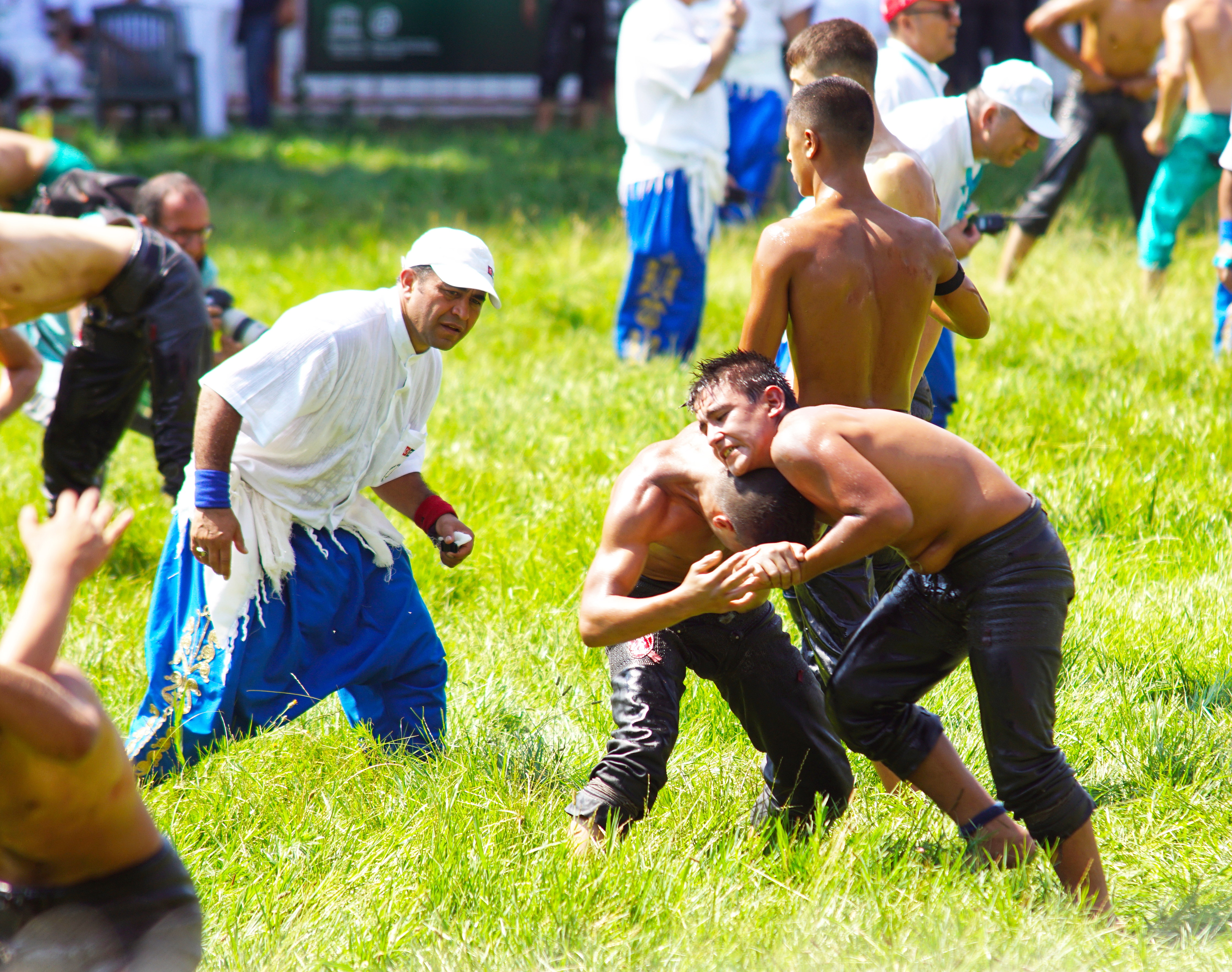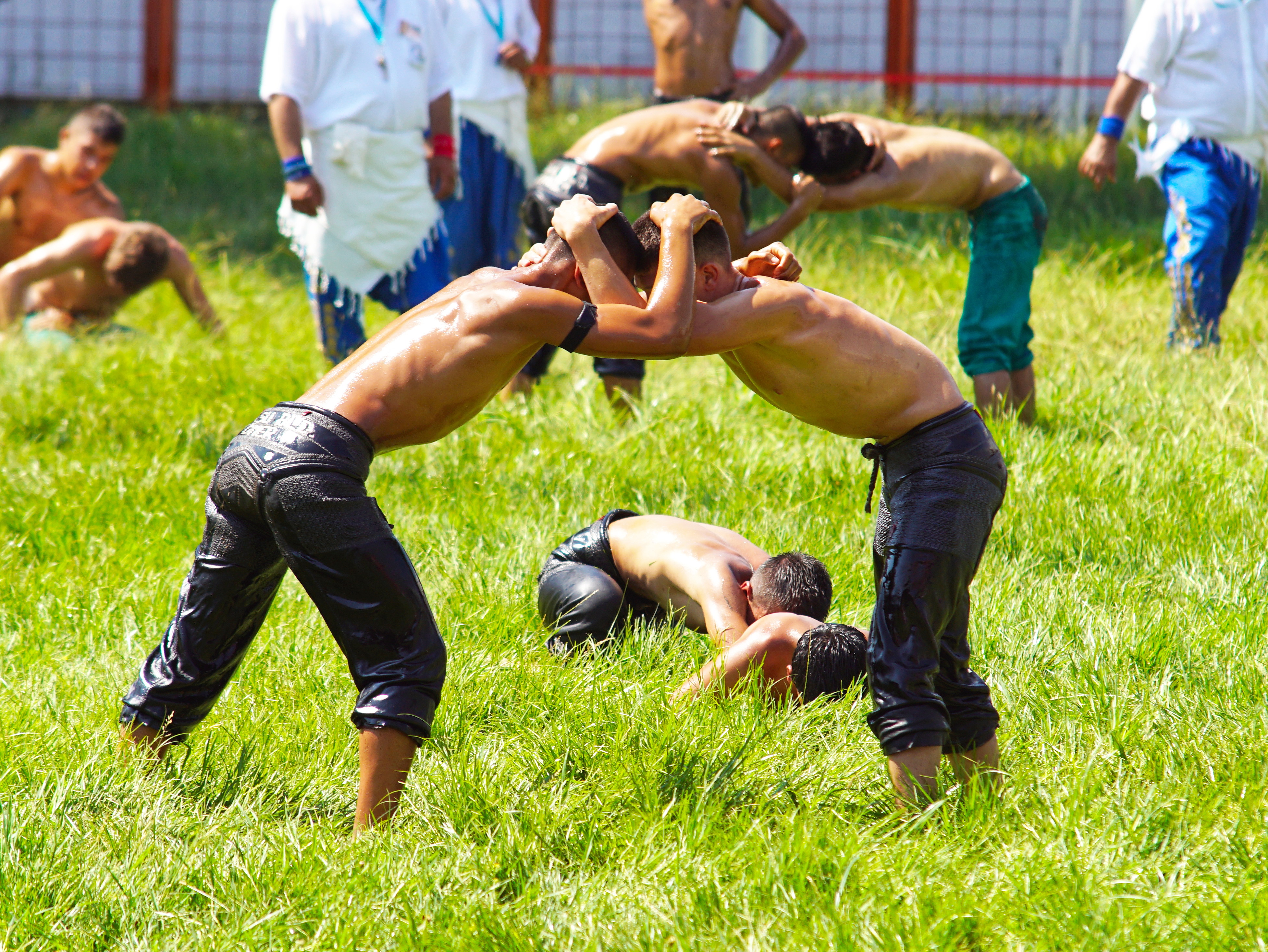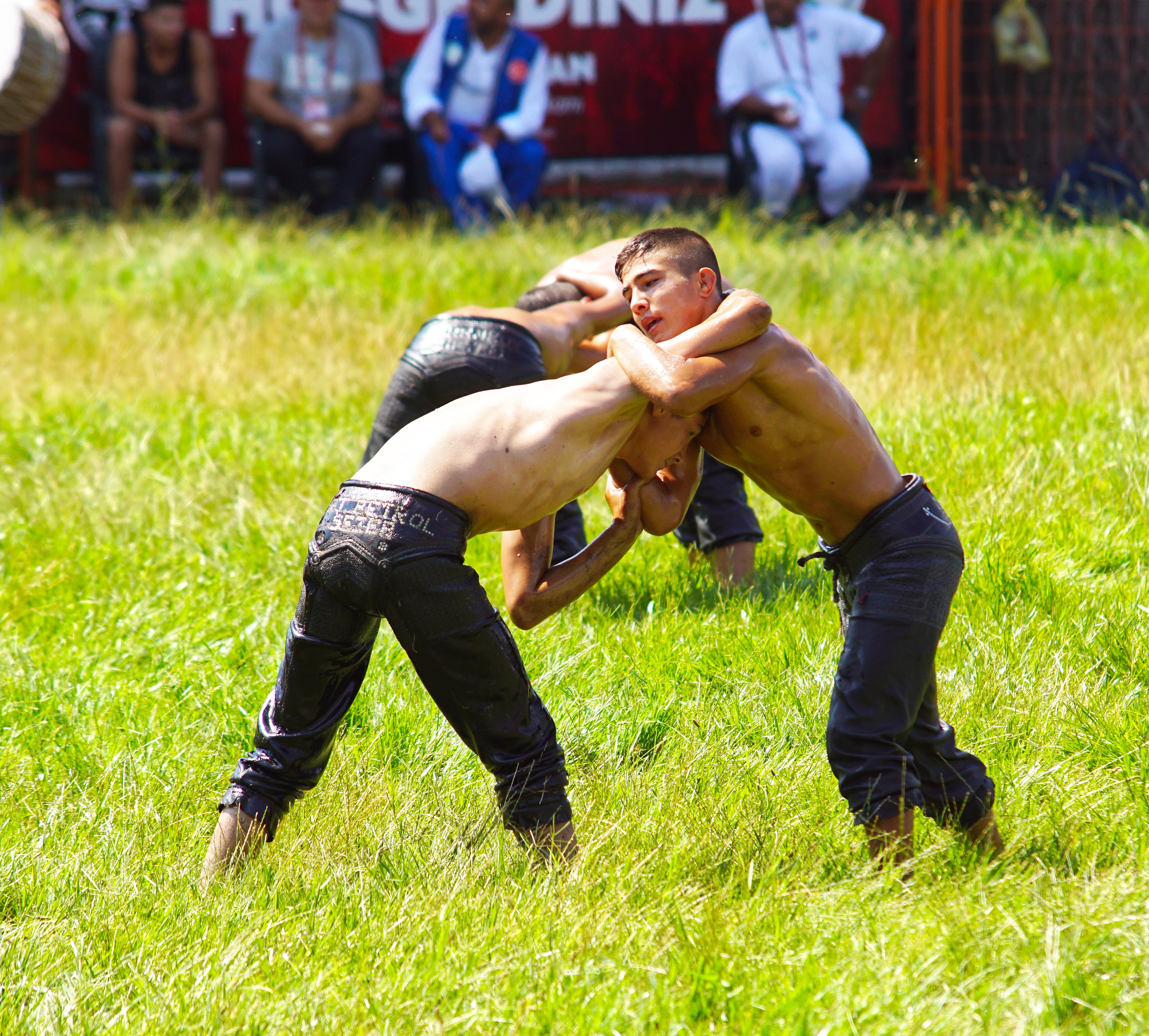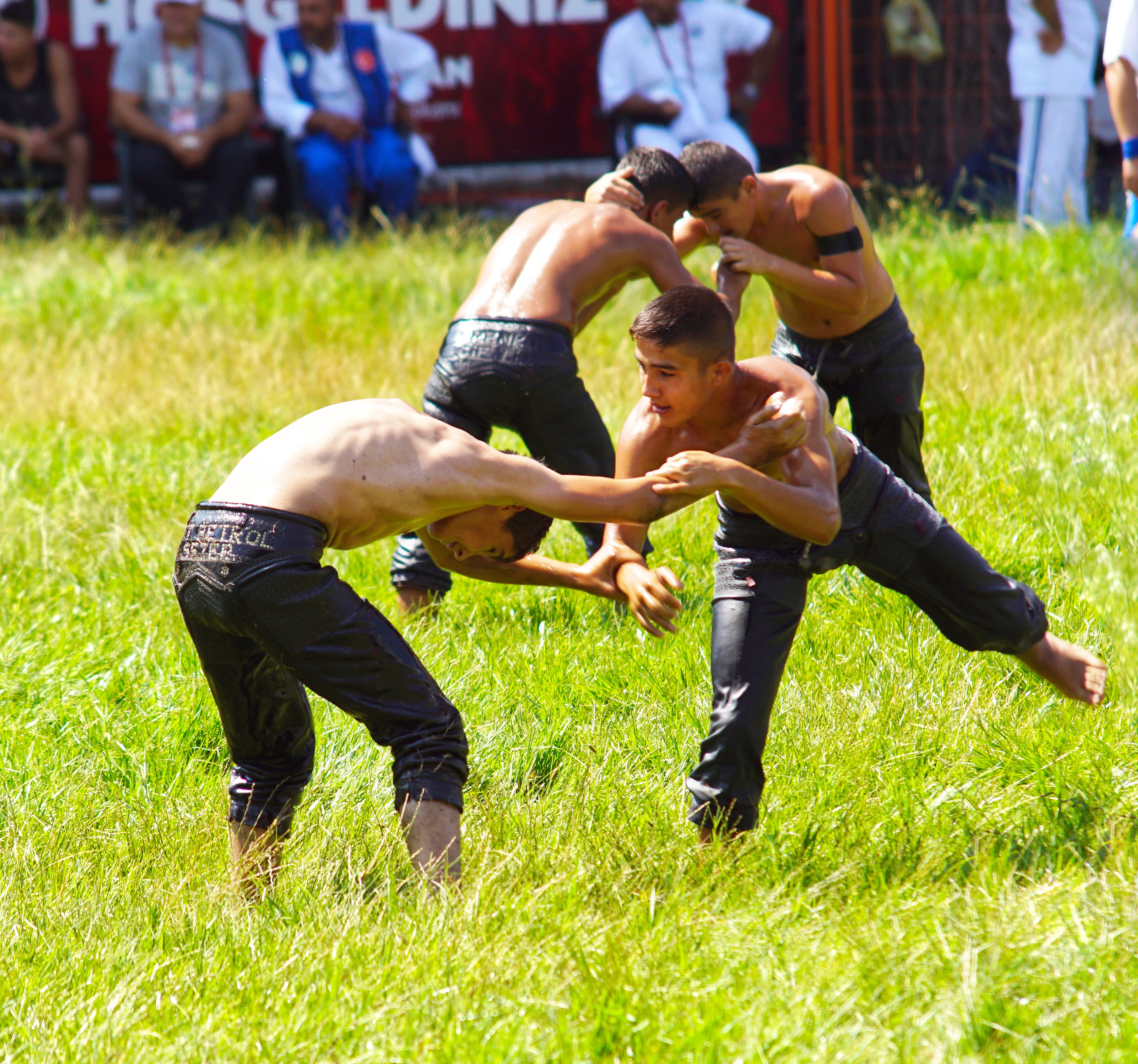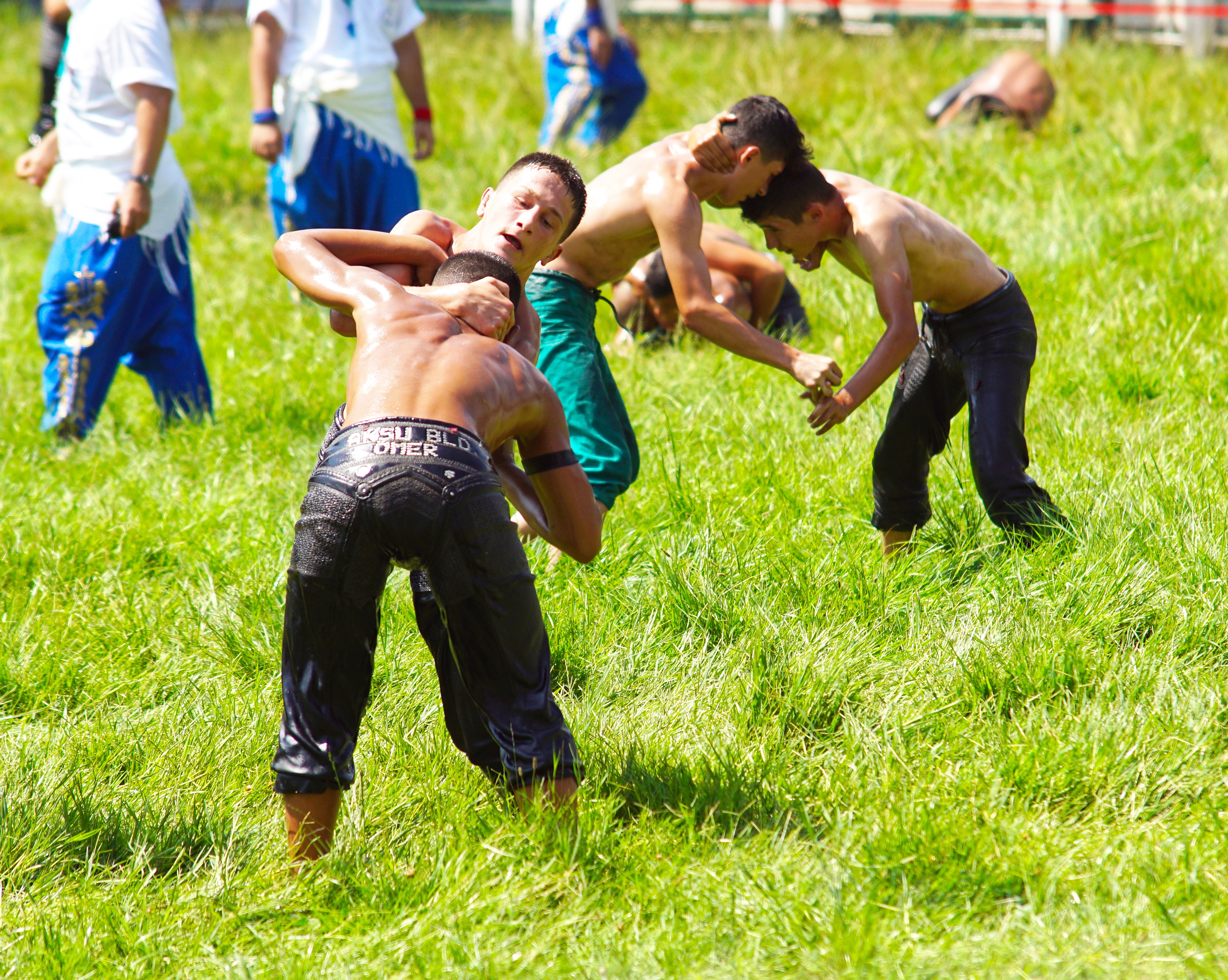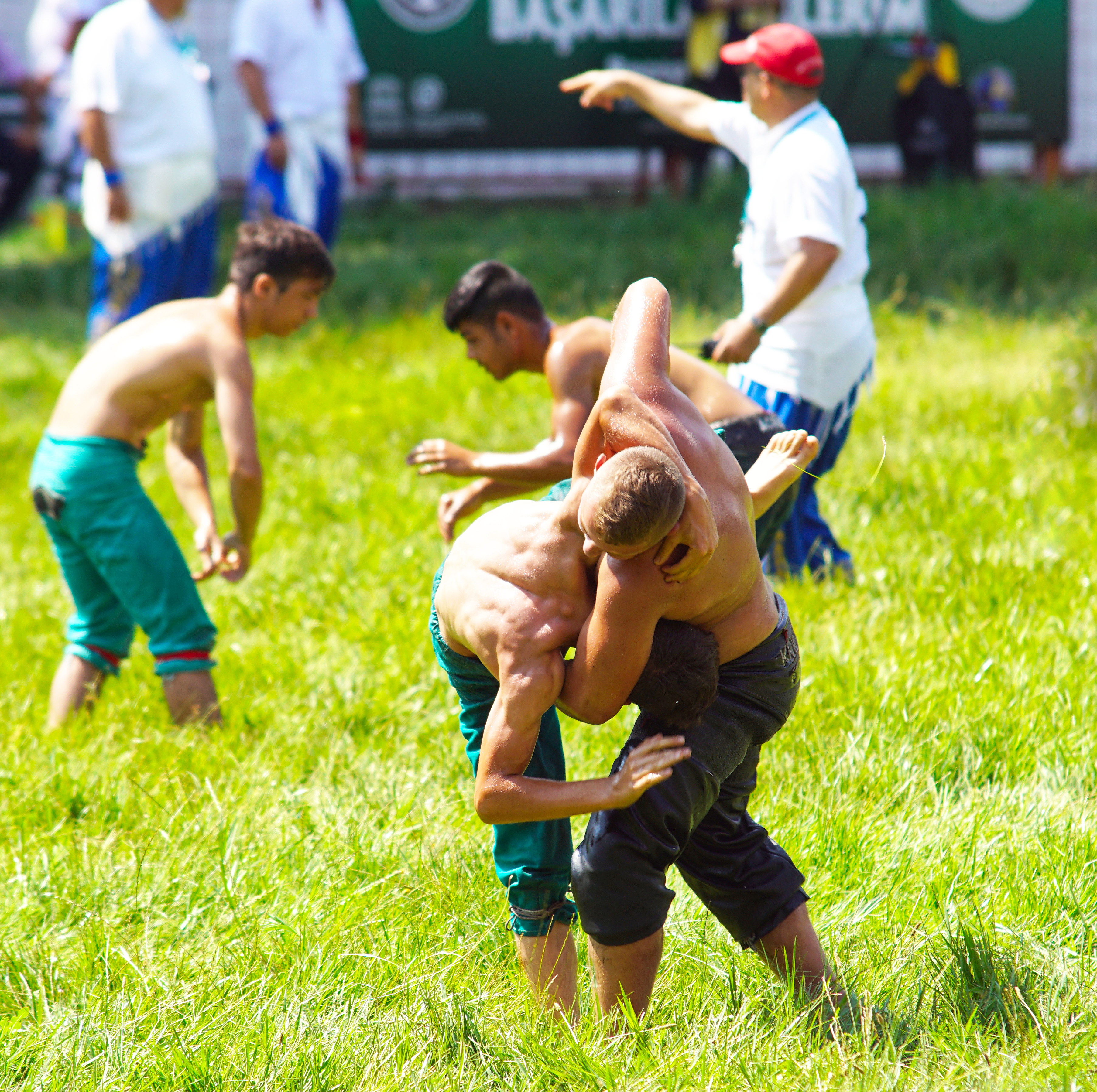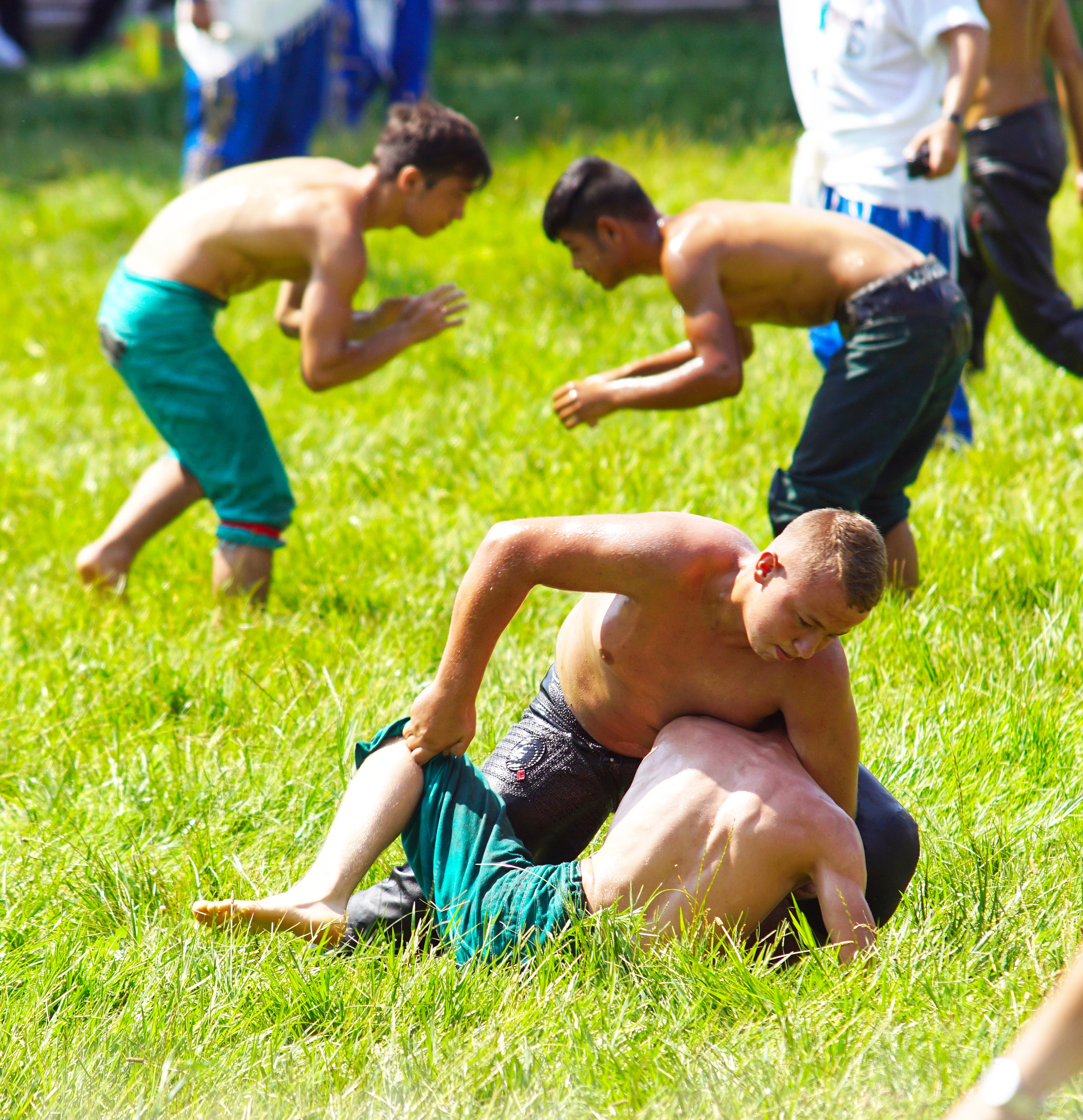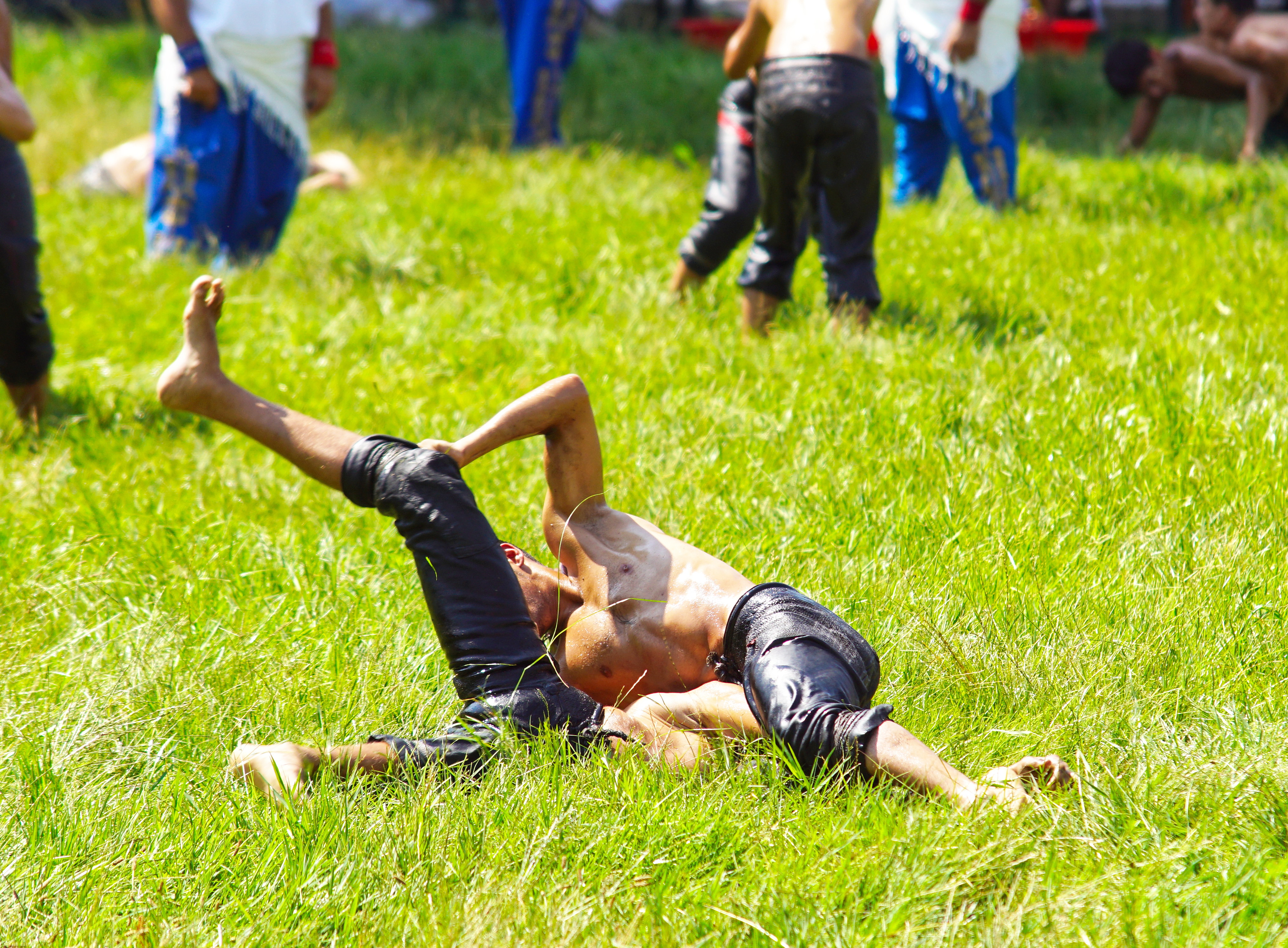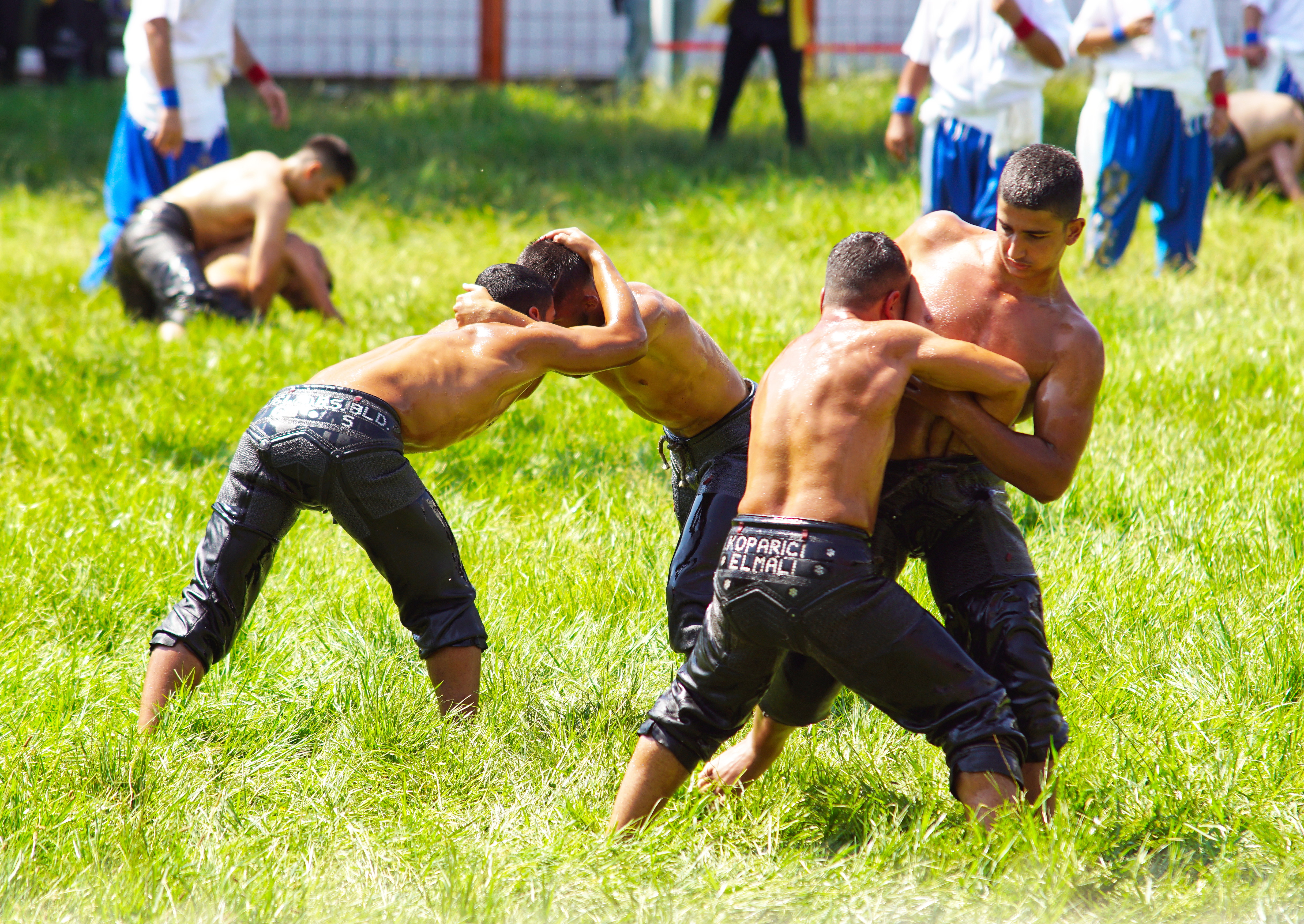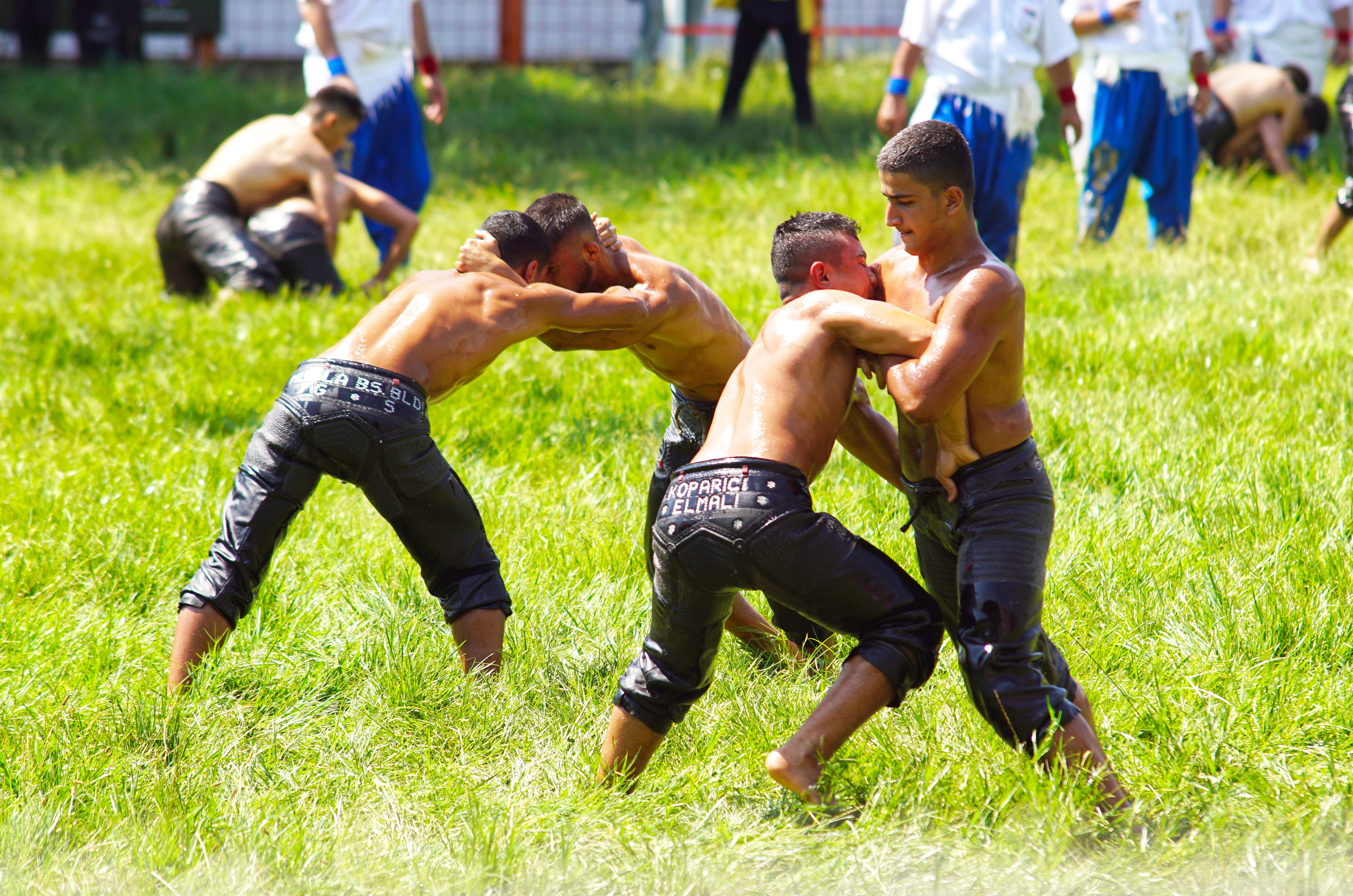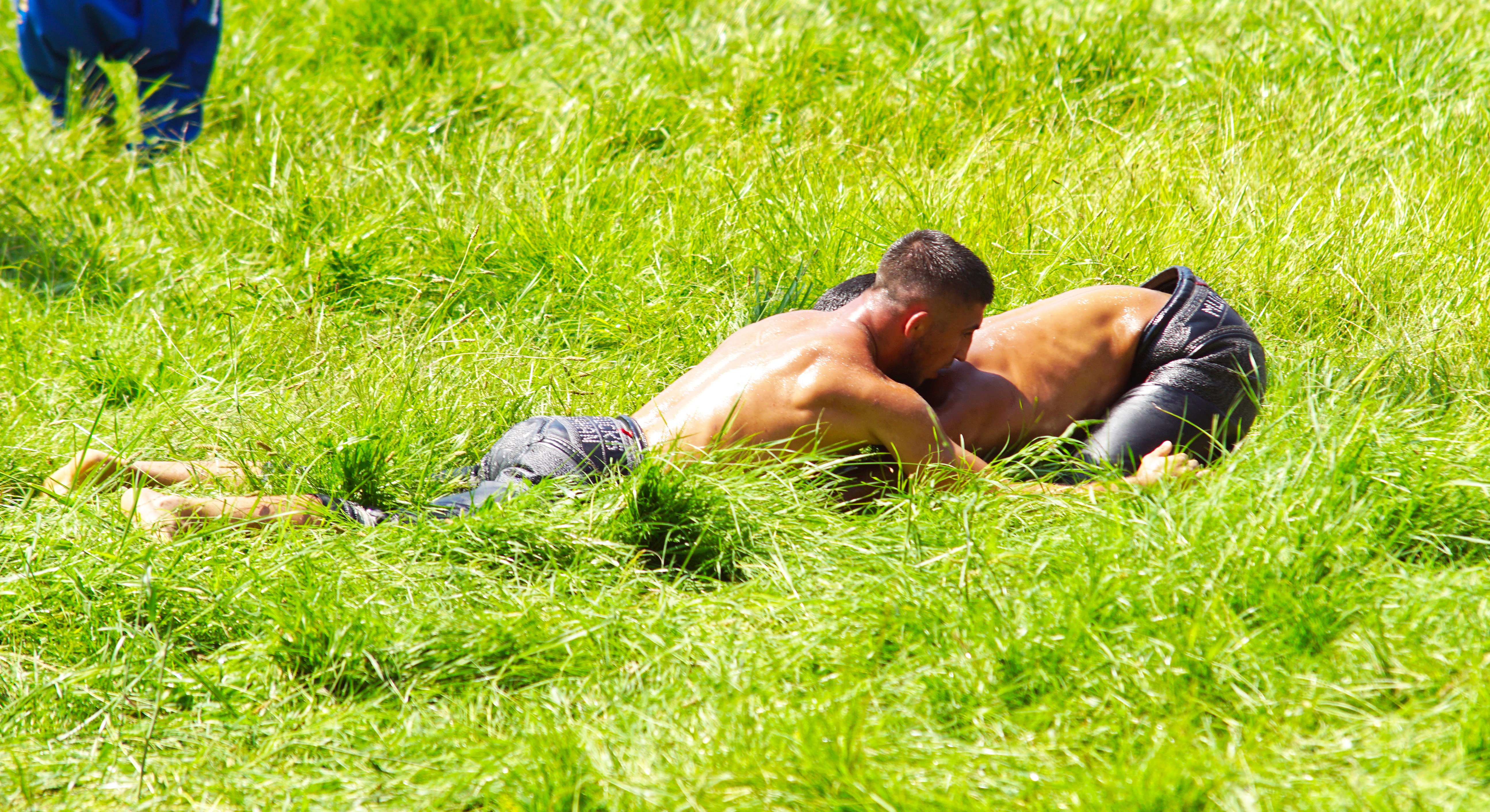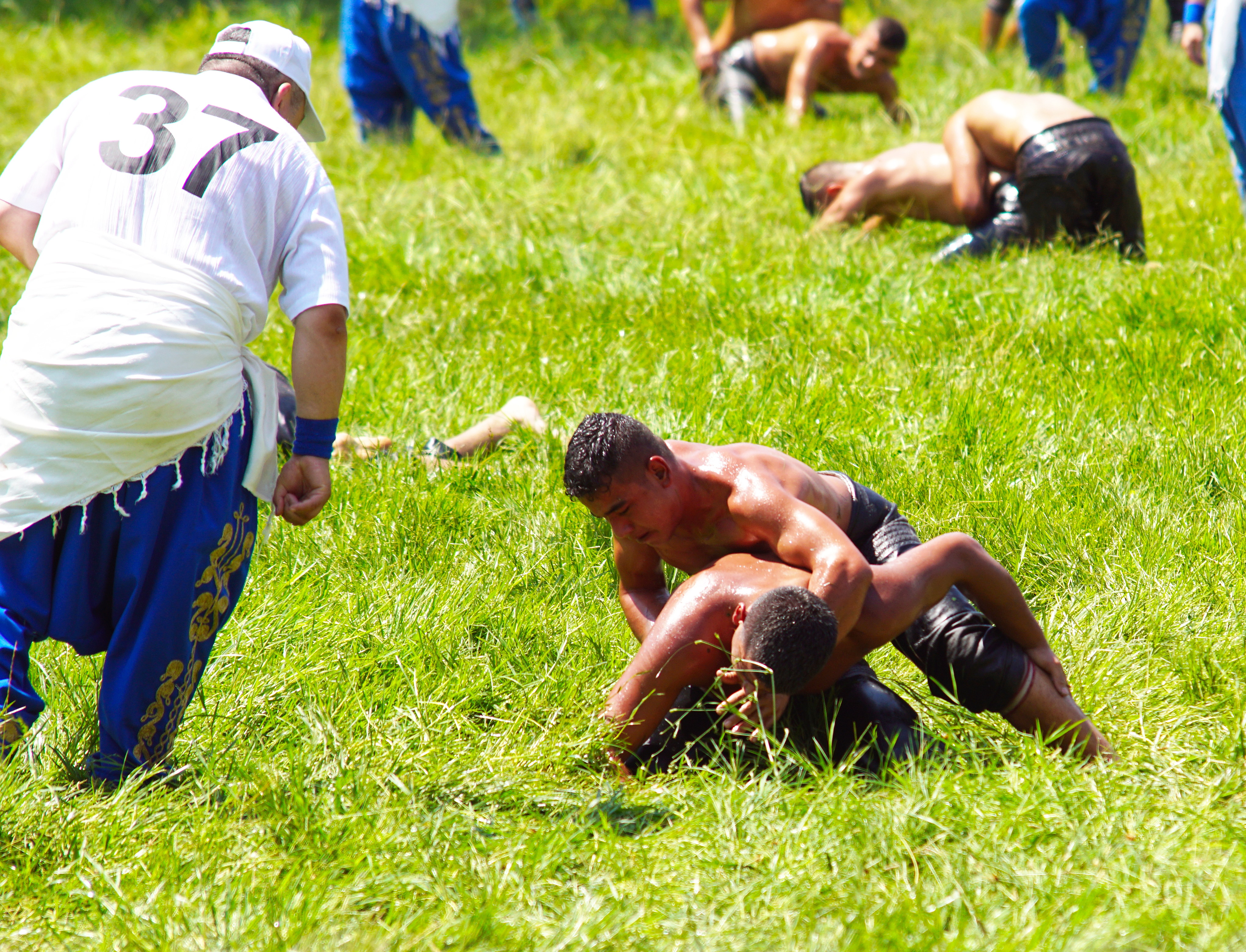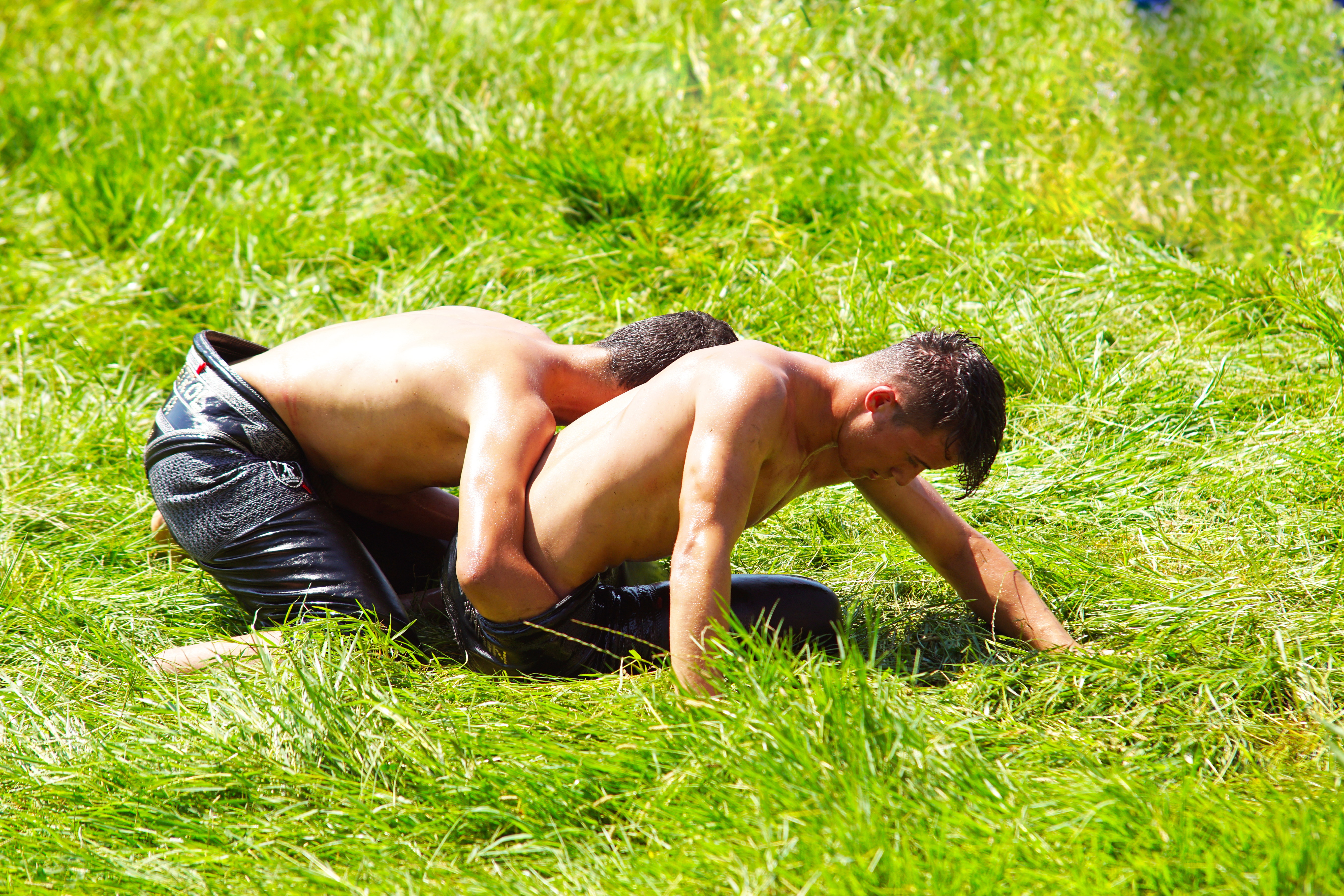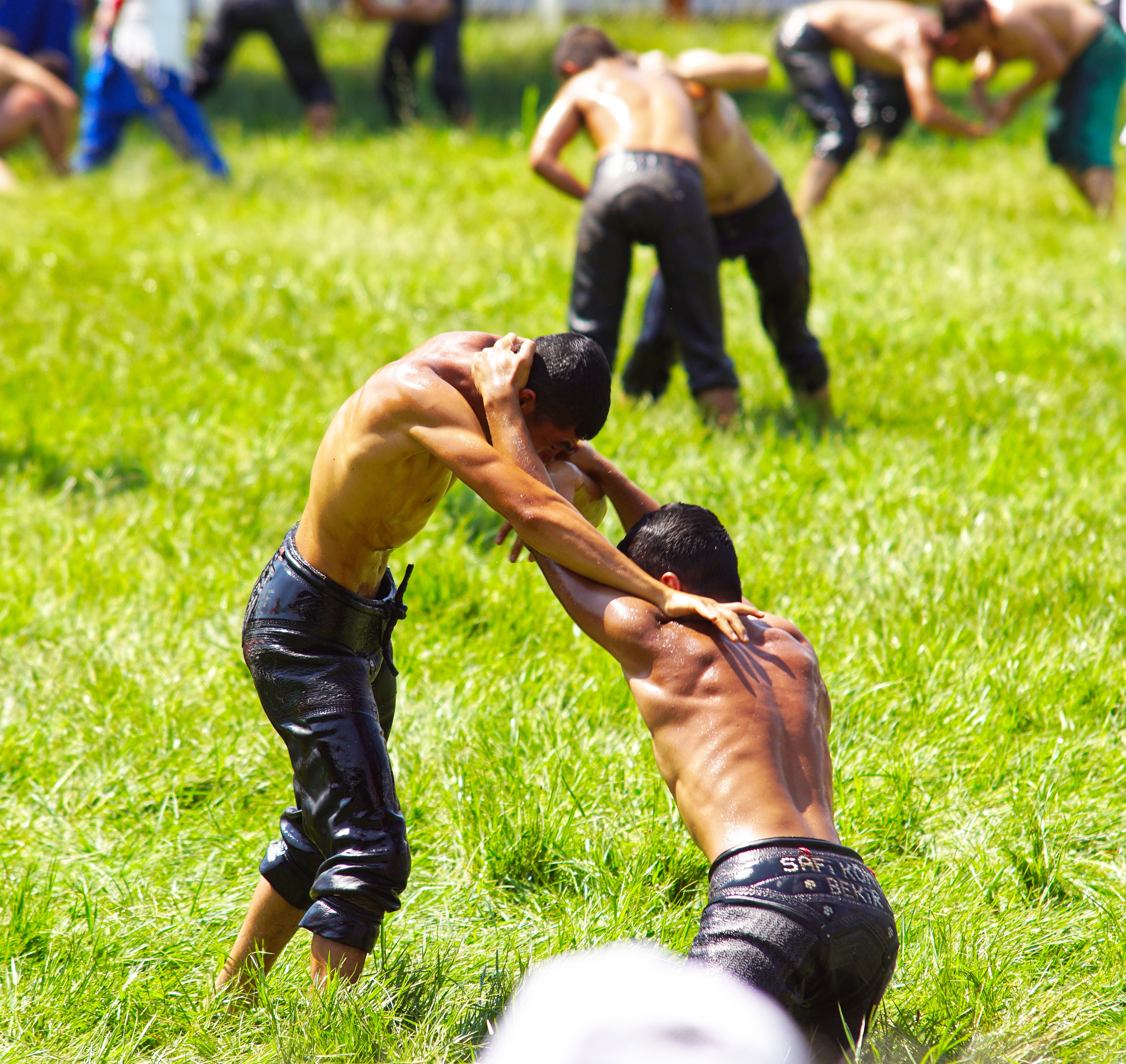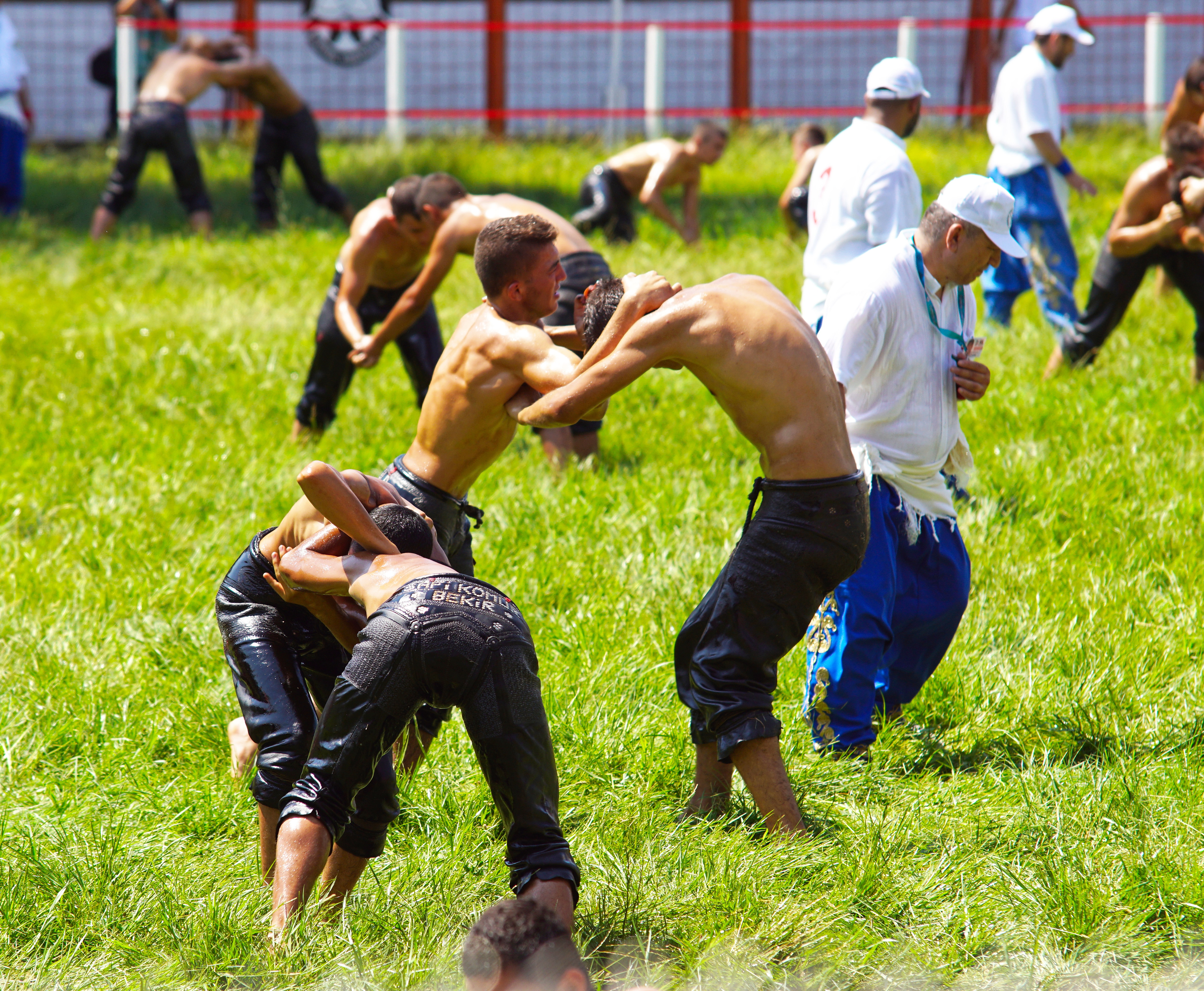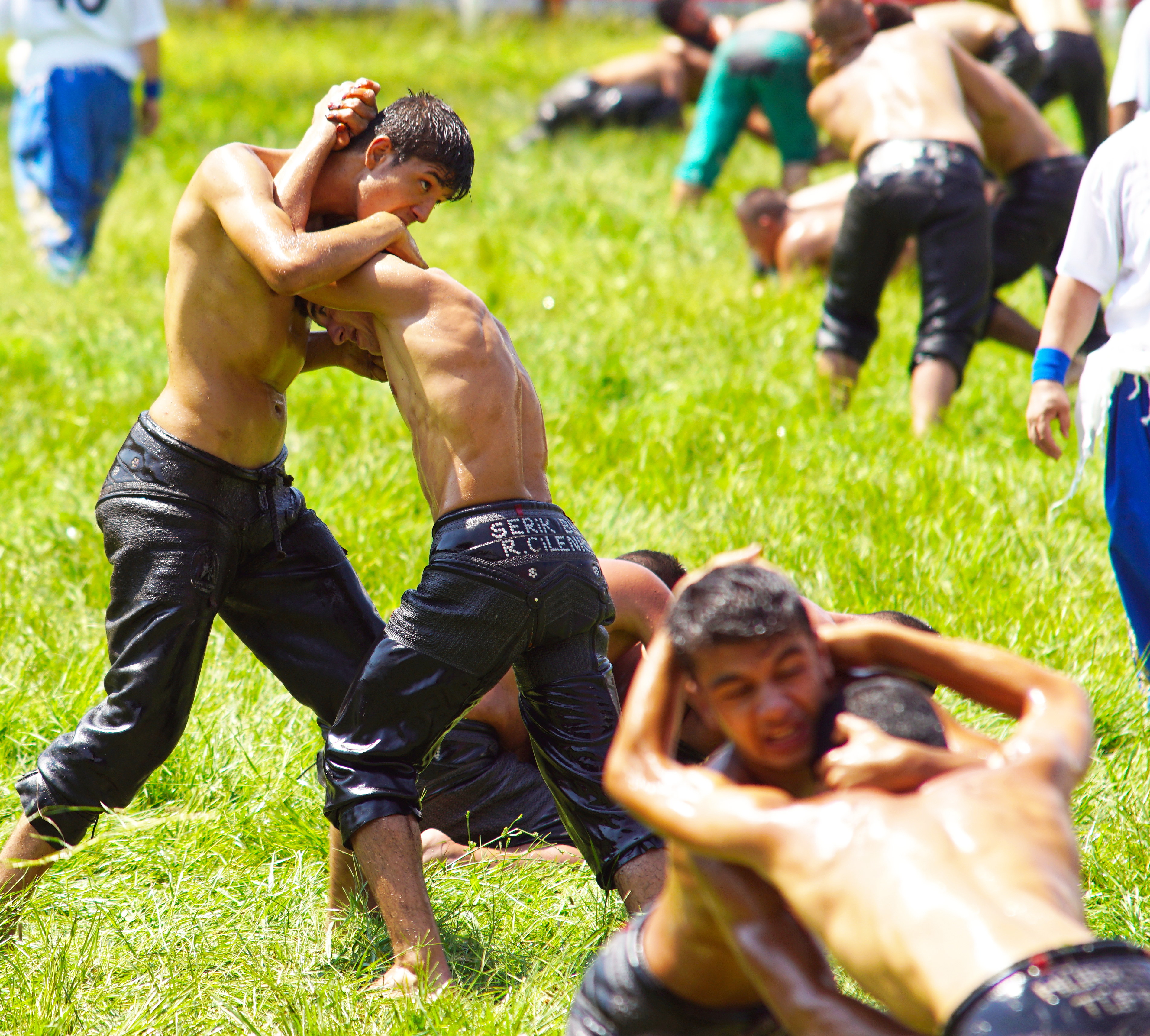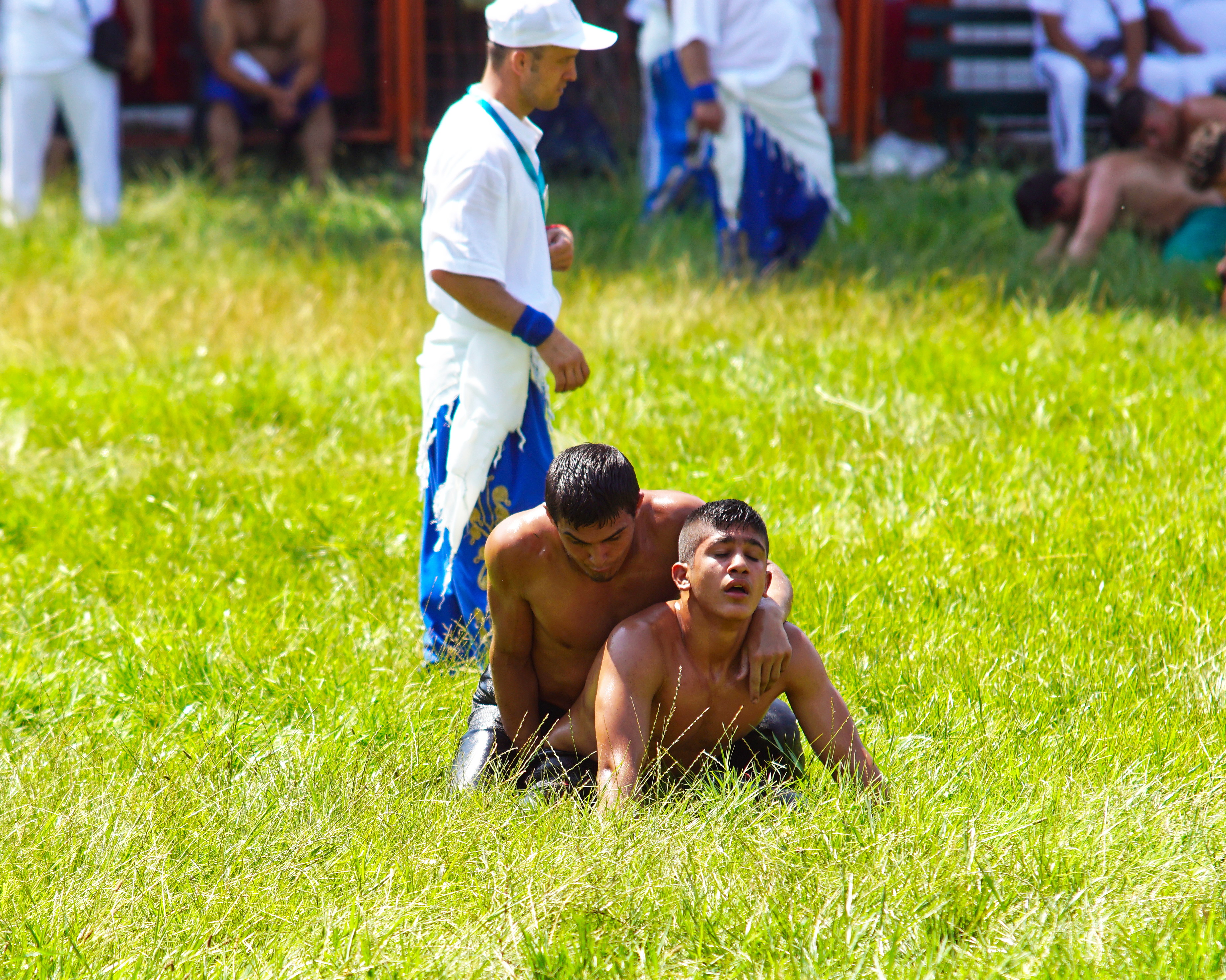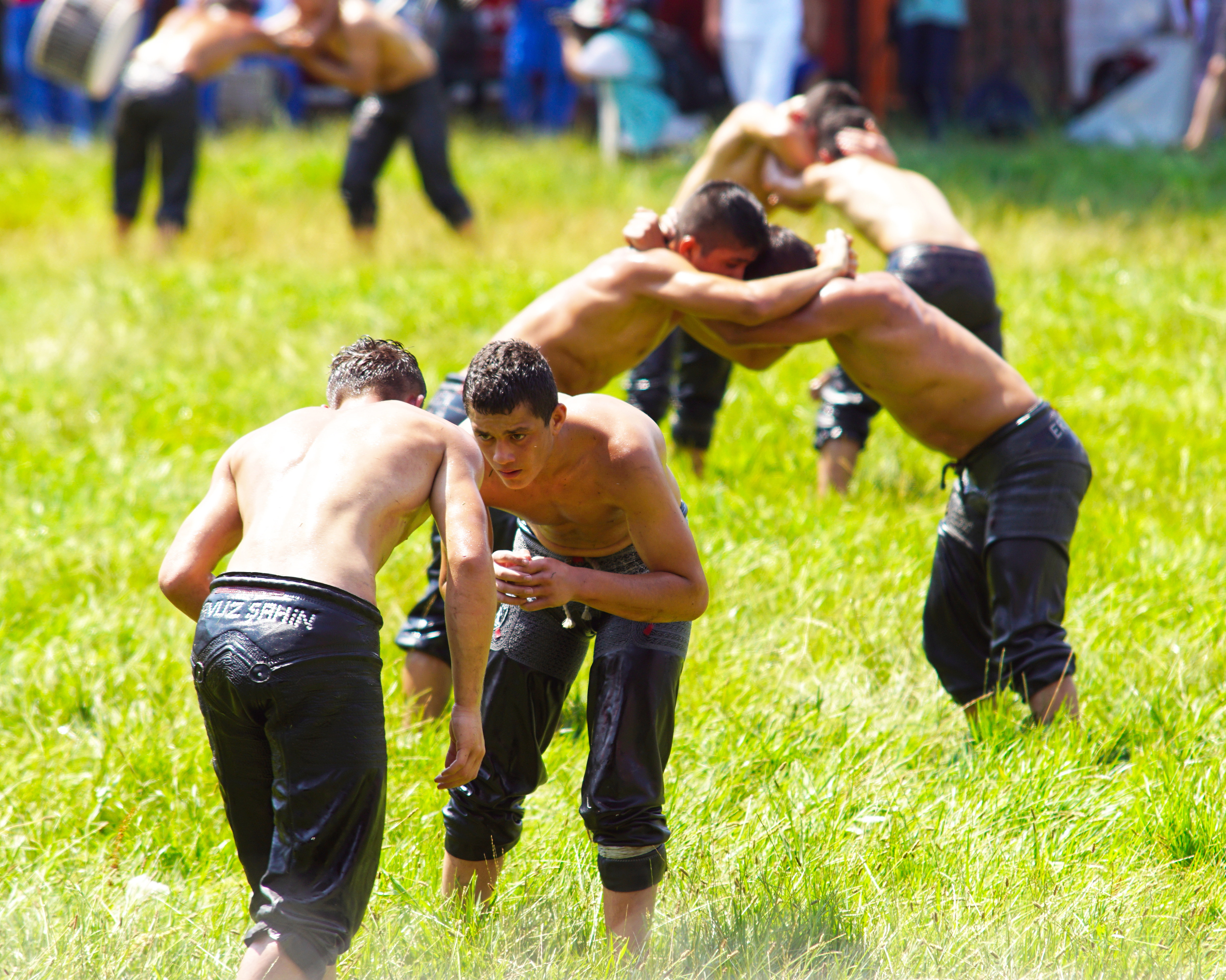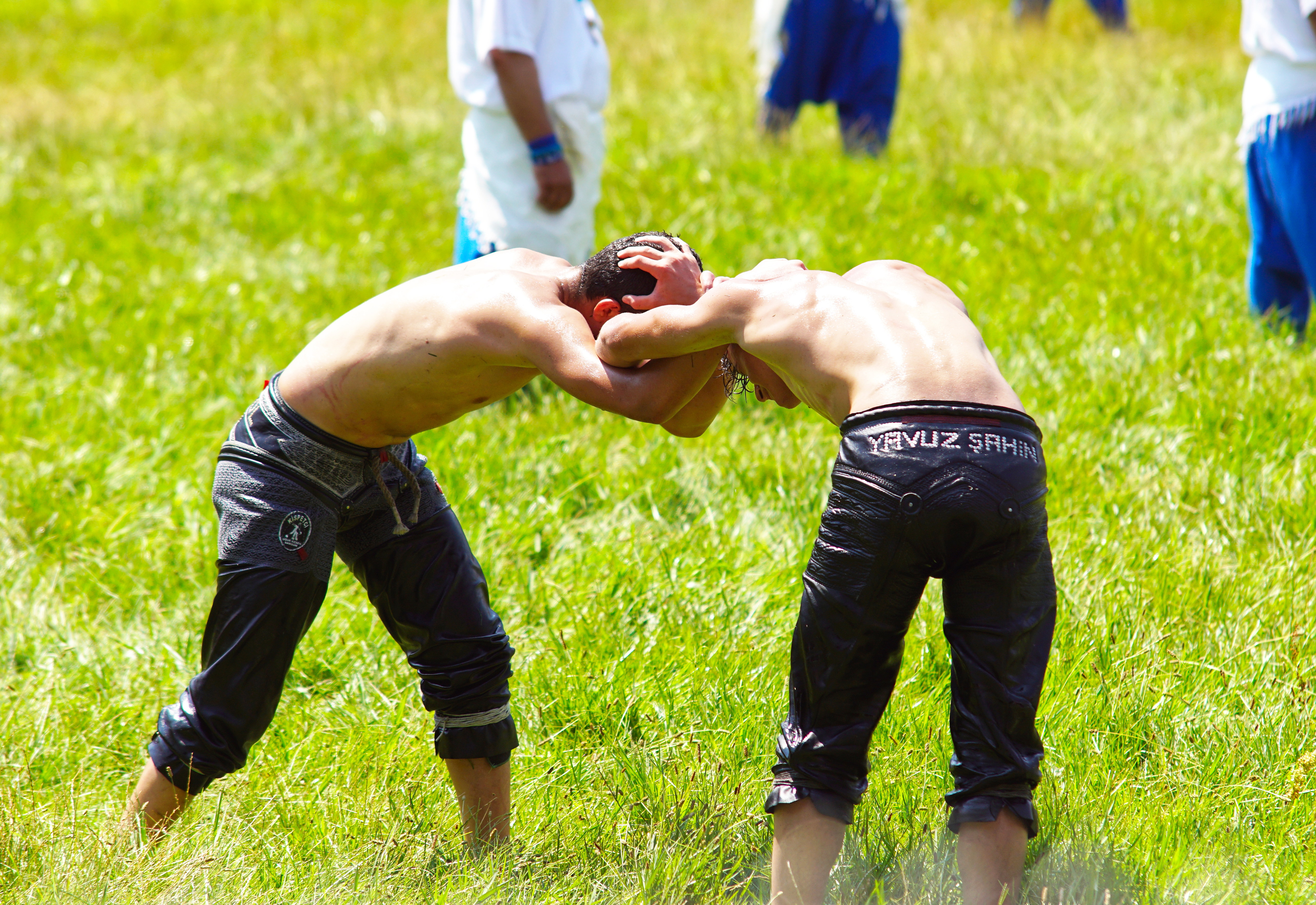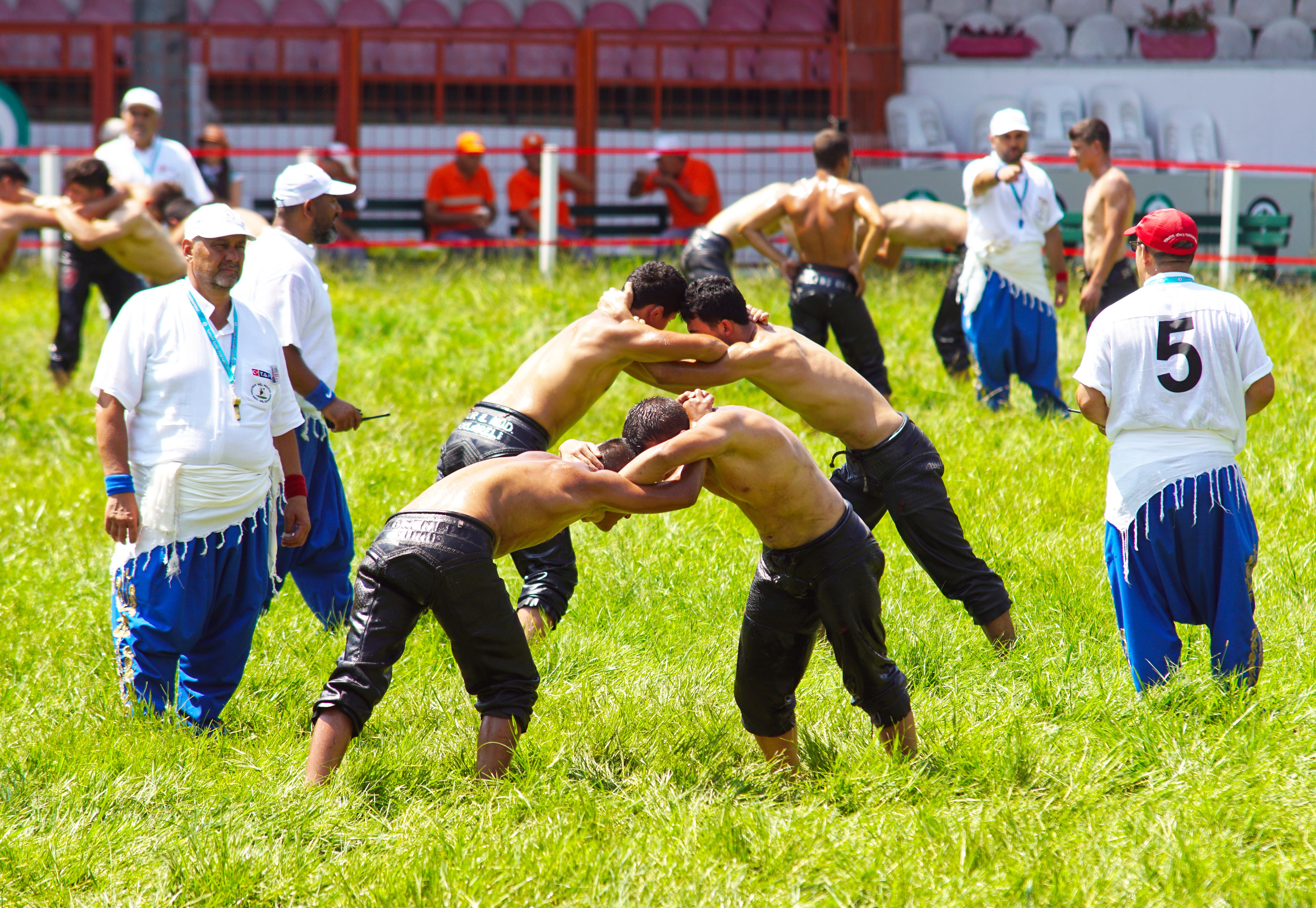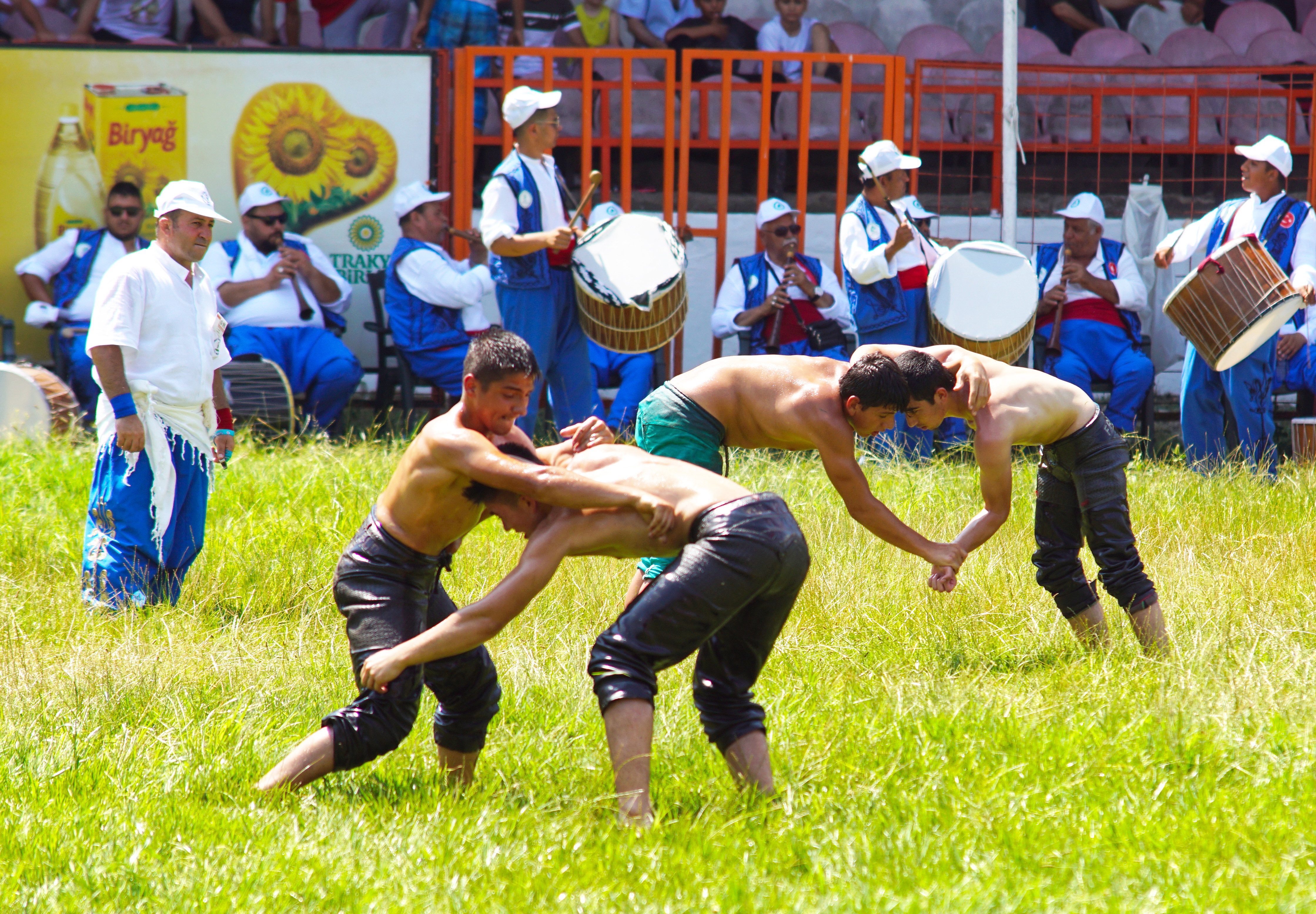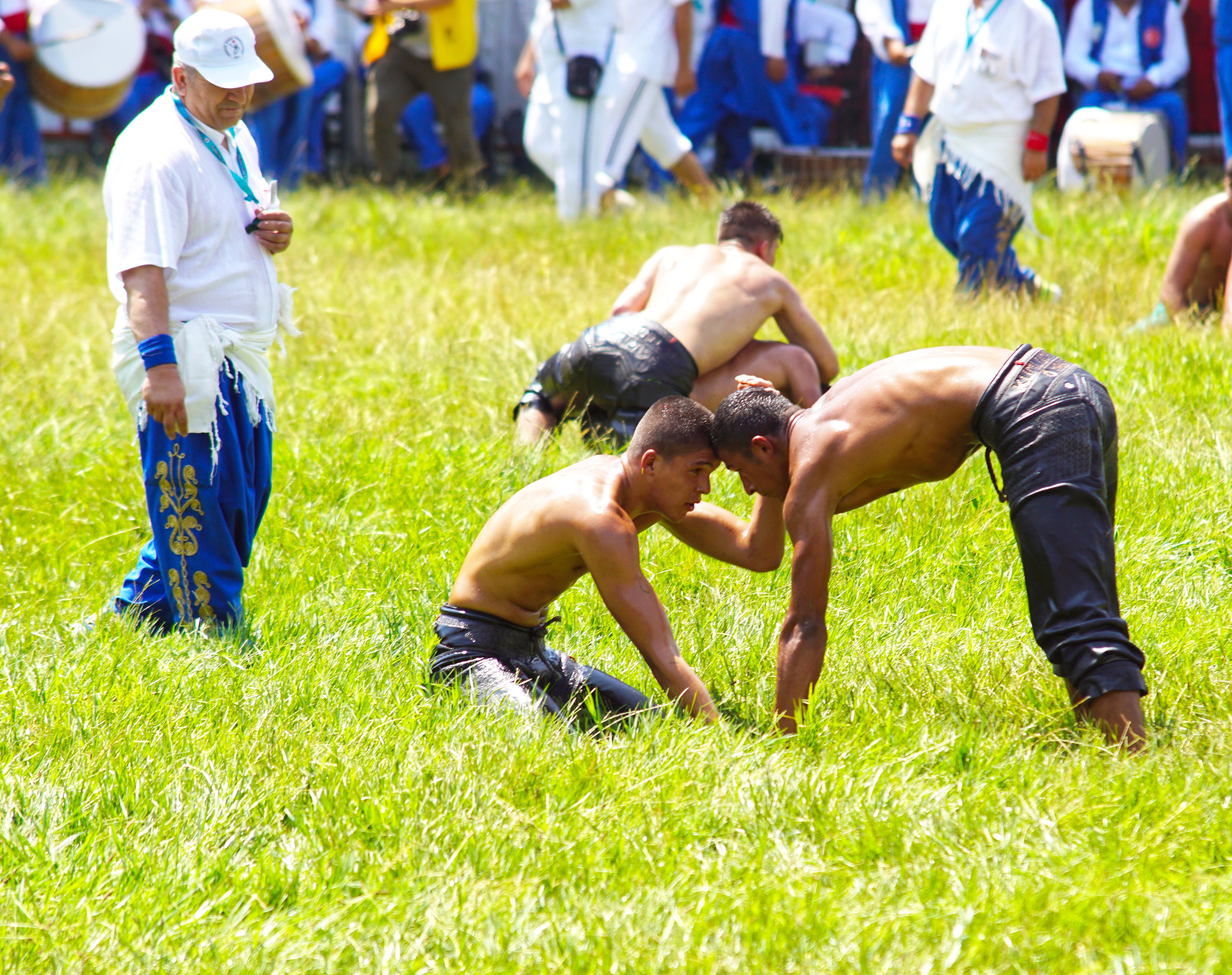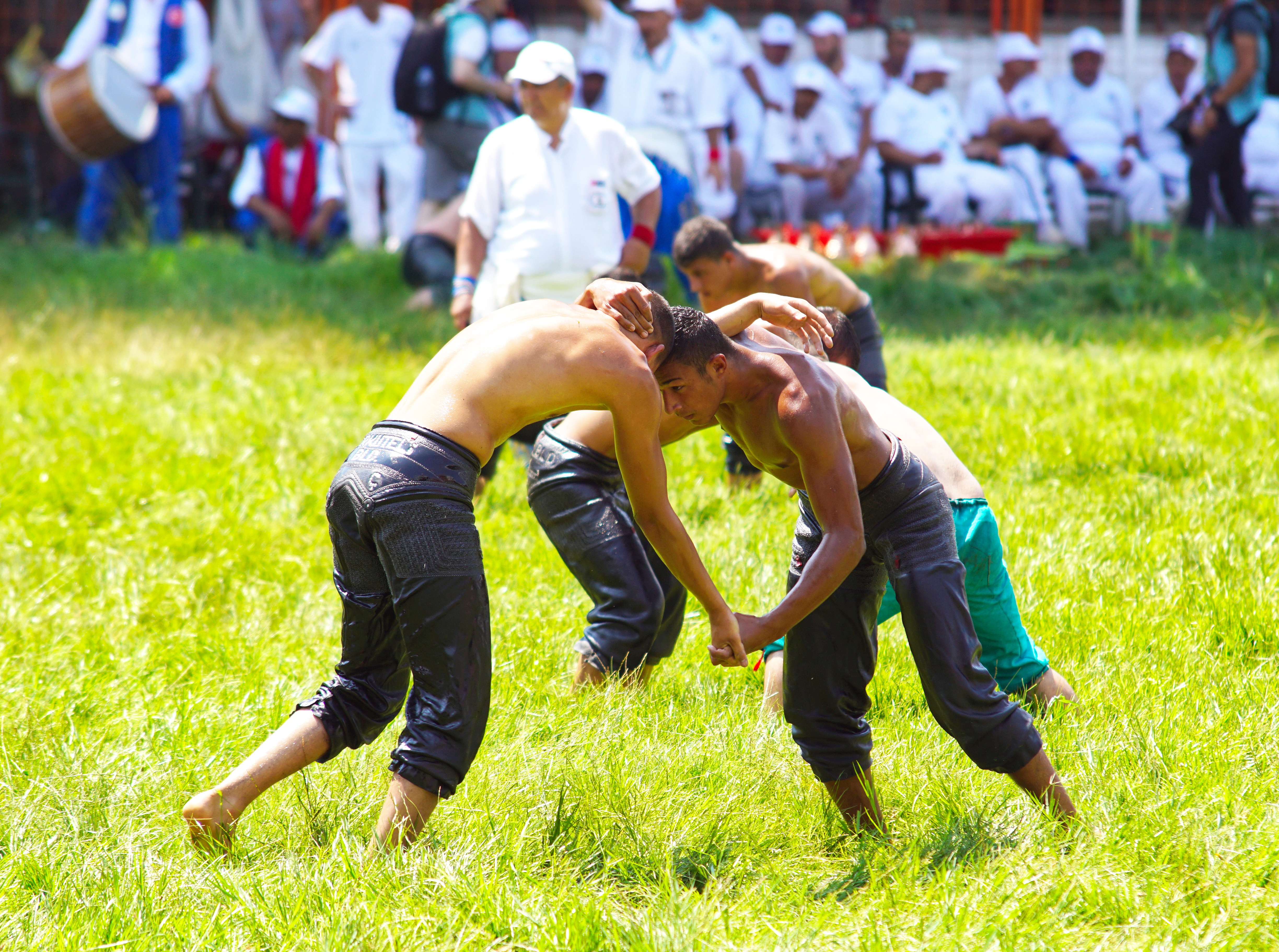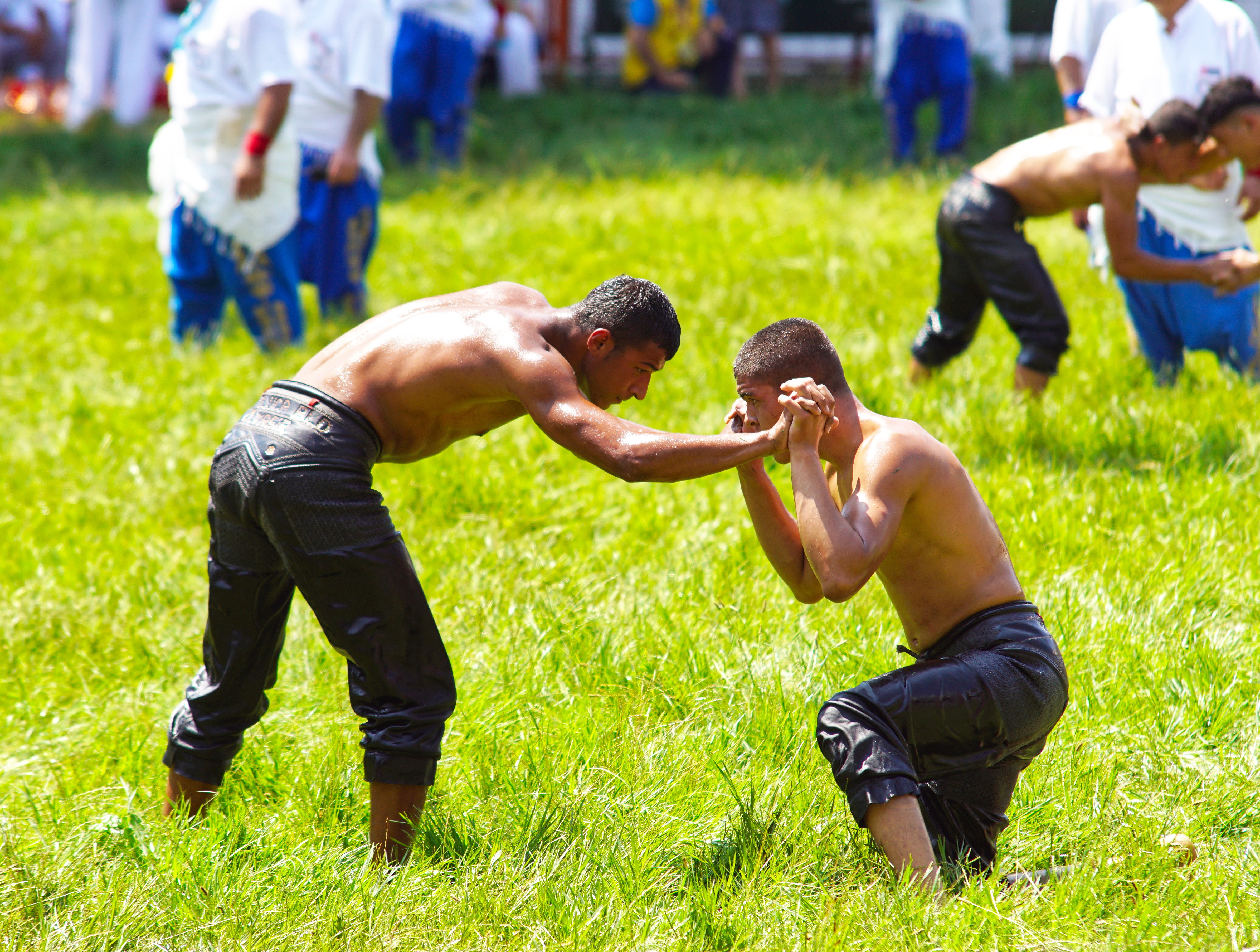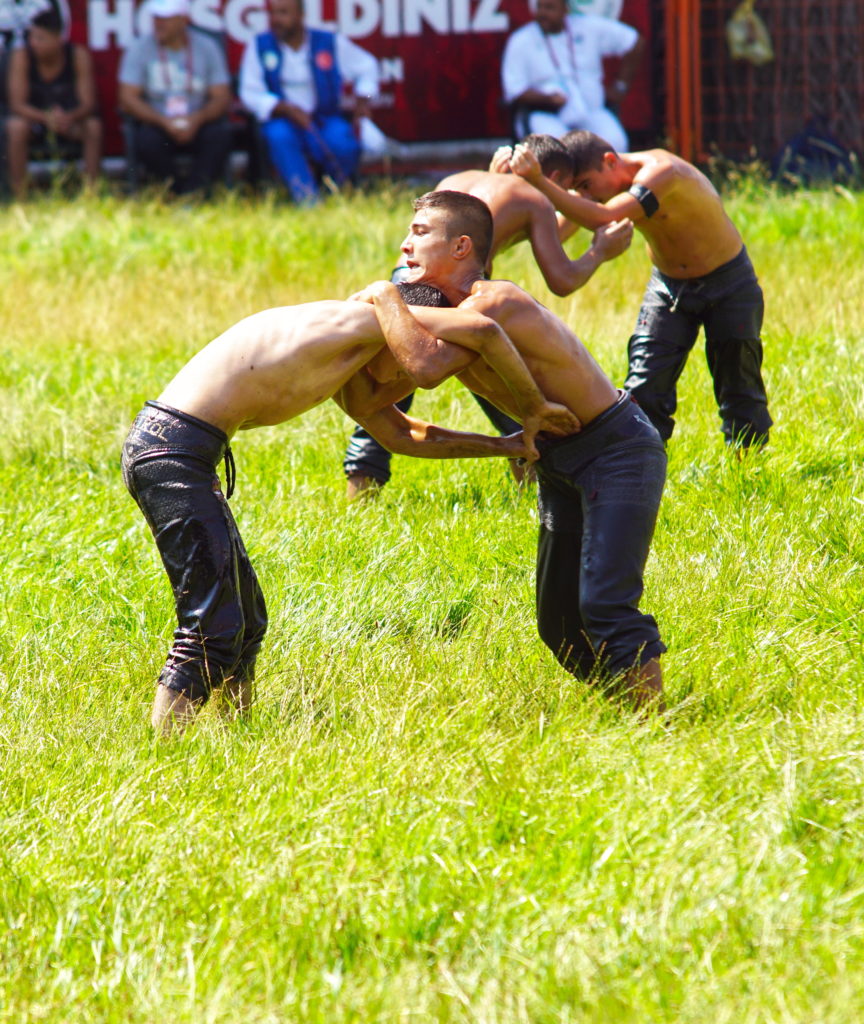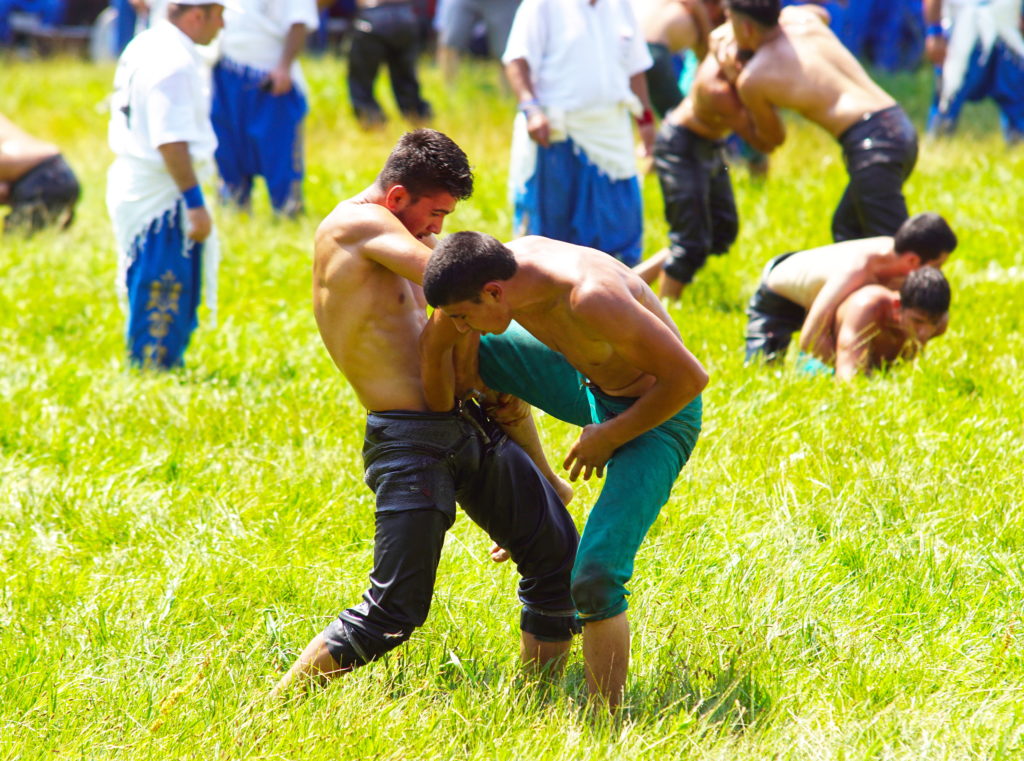Kırkpınar is a Turkish oil wrestling (Turkish: yağlı güreş) tournament. It is held annually, usually in late June or early July, near Edirne, Turkey since 1360, and features men in leather pants wrestling each other while covered in oil. So, naturally, that’s where we want to be!
But first, let’s visit the city of Edirne that hosts this fabulous event.
Edirne
Edirne is a quiet, unassuming town in western Turkey, very near the border of Greece and Bulgaria.
According to the internet, Edirne is famed for its many mosques, domes, minarets, and palaces from the Ottoman period. But you probably knew that, right?
The main shopping street of Edirne, Saraçlar Caddesi, is pleasant and sports a fountain, Sevda Çeşmesi, depicting people dancing in the rain. It was destroyed by the city in early 2020, for reasons.
Note the advertisements on the jewelry store to the left of the fountain: we see zero women looking like that in Edirne. In fact, as in other parts of Turkey, we see very few women at all. Just sayin’.
On İstasyon Cadde is the Coffee SH<STOP>T, selling “The most natural form of coffee.” We wonder what kinds of unnatural forms of coffee are also available, but are too cautious to inquire.
To the far left, hidden in the grass, is a tractor. Next to that is the “22 Seyahat” bus. The white arrow points at a horse, minding its own business. Farther down the road are cars. Yup, just another day in Edirne.
Here we see a construction crew, much braver than we are, working on a roof without safety lines or a net. These Turks are a hearty group, that’s for sure.
The crew works in the hot July sun, passing heavy bricks by walking along a ledge, with no need for steel-toed boots. Well, at least he’s wearing gloves.
Selimiye Camii dominates the horizon in Edirne, one of twenty mosques in the city. It is an Ottoman imperial mosque, commissioned by Sultan Selim II, and built by the imperial architect Mimar Sinan between 1568 and 1575. It was considered by Sinan to be his masterpiece and is one of the highest achievements of Islamic architecture. Unfortunately, we don’t have time to visit it. 🙁
However, we do have time to visit the Grand Synagogue!
Grand Synagogue
Compared to the mosques of Edirne, the Grand Synagogue is unassuming and somewhat difficult to find. According to Turkish Archaeological News, “While walking the streets of the old district of Edirne, it is easy to reach Maarif Street. There, at its southern end stands the newly restored building of the Grand Synagogue of Edirne (tr. Edirne Büyük Sinagogu). The fate of this building reflects the turbulent history of the Jewish community of Edirne, once very numerous, and now almost non-existent.”
By the end of the 19th century, the city of Edirne had approximately 13 synagogues. In consequence of “the Big Fire” (Harik-i Kebir) on 2nd September 1905, all these synagogues were burnt down and destroyed.
The Jewish community started building a new synagogue in January 1906 after getting the permission of the Ottoman Government and the edict of Sultan Abdul Hamid II. The new synagogue was modeled on the famous Leopoldstädter Tempel – the largest synagogue of Vienna – as it was designated to demonstrate the community’s achievements and modernity. Grand Synagogue of Edirne was designed by the French architect France Depré in the architectural style of Moorish Revival. The location of the new synagogue was the site of the ruined synagogues Mayor and Pulya in Suriçi neighbourhood. At that time, about 5,000 Jews lived in Edirne. They were not treated well. For example, “in 1971 the town administration banned the Jewish community from using its cemetery, which was confiscated and destroyed in 1975. The Grand Synagogue of Edirne continued to function as a place of worship until 1983. In 1998, only 3 Jews lived in Edirne.”
Due to the emigration of the Jewish community, the synagogue ceased to operate in 1983. In 1997, because of the lack of interest in the fate of this building, its roof and one of the walls collapsed.
In 2008, the mayor of Edirne, Mustafa Büyük, announced a plan to rebuild the synagogue building and restore its former splendour. In his speech, the mayor stated that the reopening of places of worship of different religions would bring Edirne cultural richness, and after the restoration of two Christian churches, it was time for the synagogue. Mustafa Büyük also expressed the belief that children and grandchildren of Edirne Jews would come to this city to visit the restored synagogue. His words were confirmed by Israeli consul Mordehai Amihai, whose grandfather once lived in Edirne.
The reconstruction of the synagogue lasted five years and cost 5.75 million Turkish lira, i.e. approximately US$2.5 million. The investment repaired the lead-clad domes, the collapsed roof and walls. The foundations were fortified, and the floor inside was restored to its original patterns and colors, as well as the Torah inscriptions. The restoration was overseen by Turkey’s General Directorate of Foundations. The restored synagogue is claimed to be the largest one in the Balkans and the third largest in Europe.
I always thought the Jewish second commandment was interesting. According to Chabad.org, “You shall have no other gods before Me. You shall not make for yourself a graven image, nor any manner of likeness of anything that is in heaven above, that is in the earth beneath, or that is in the water under the earth. You shall not bow down to them, nor serve them. For I the L‑rd your G‑d am a jealous G‑d, visiting the iniquity of the fathers upon the children of the third and fourth generation of them that hate Me; and showing mercy unto the thousandth generation of them that love Me and keep My commandments.”
And there you have it. Their god does not state that it is the only god, but simply that the Jews must not have those other gods before it.
Notice the difference between the inside of a synagogue and a mosque.
Behind the altar, in a cove, is a box covered with a cloth depicting the Shield of David. It looks like it might be covering the Ark of the Covenant, but we’ve watched enough movies to know that we shouldn’t peek inside.
In this photograph, you can see the architectural similarities to Muslim mosques, with its Escher-esque designs and repeating patterns.
Notice, besides the chandelier, the Shields of David scattered about (we count 17), plus the allusion to the Ten Commandments.
We leave the synagogue, wiser to the ongoing stupidity of humanity, yet reassured that most people still have goodness in their heart.
Hilly Hotel
We are staying at the Hilly Hotel, a comfortable and accommodating lodging on the outskirts of Edirne.
The hotel is strangely empty, given the internationally famous event about to begin. But, since we enjoy having restaurants all to ourselves, we shall not complain.
They serve baked butter, cheese mushrooms, crispy chicken made of french fries, and a beer plate with no beer. Yum!
Despite the wacky descriptions, Turkish food is delicious and well-presented. We are including a photograph only of the dessert because, dessert.
Travelers advice: select a room that faces the open field. You won’t be disappointed.
Fairgrounds
The wrestling event has not yet begun, but let’s take a look at the fairgrounds where this mighty event will take place.
Parking is easy and we walk to the grounds. There is no admission fee and everyone is casual. It reminds us of a Renaissance Fair.
And like a Renaissance Fair, people set up overnight encampments, bring chairs and tables for dining, and prepare goods for sale to tourists.
A low-tech merry-go-round provides the potential for entertainment. And I never thought of the Flintstones as being an international icon, but there you have it.
The Tobacco Shop is thoughtfully placed near the children’s play area, for reasons. There are a number of women here with uncovered hair, which is an appreciated change from the usual Turkish delight.
What is a festival without tractors? The folks of Edirne have provided hundreds of tractors for us to enjoy, from commercial size to backyard garden size. I can feel my testosterone surge.
This is the best coffee bus we’ve ever seen. It has its own trash can, an indoor bathroom, and many tables and chairs for weary coffee drinkers. Now all it needs are customers.
The food preparers wear gloves in an effort toward hygiene, although food prepared outdoors does attract flies. Still, that mound of meat looks appetizing, doesn’t it?
This fellow appears to be making vegetarian dishes. Turks tend to eat well-balanced meals, but there is typically a focus on meat and meat by-products, so this is unusual.
Kebab, a popular food in many places, is even more popular here. The Turks have many different ways of preparing it, including over a naturally-heated stove. And that is a nice-looking stove.
The friendly vendor beckons us to enjoy their goods, but we decline. We are not connoisseurs of fine kebab, and we have some concern as to how our GI tract will react to the spices.
Three statues immortalize winners of the Kırkpınar event. Notice the M.C. Hammer pants, which are actually harem pants.
We find two more statues depicting winners of the event. These fellows are cast in a metal that gives the illusion of being oiled, with is fitting.
The sign reads, according to Google, “Wrestler statues were built by the late network, Huseyin Sahin.” Huseyin Sahin is an artist living in Istanbul, and it’s worth taking a look at some of his work.
Near the fairgrounds are large fields of sunflowers, from which we get sunflower seeds and sunflower oil. Oil! Isn’t that the reason we are here? Let’s get to the main event!
Kırkpınar
Edirne is a small town, so it’s easy enough to be where we need to be, without asking directions.
We can find no information about the event’s starting time, so we arrive early to be sure to get a good seat. Really early, it seems.
The grass is longer than I’ve ever seen on a playing field. Well, they must know what they are doing.
There is no entrance fee and, except for a few locations, seating is open. We check out the view from different location, then select seats centrally located. There are men (no women) in white clothes milling about.
Hidden in the tall grass are cans of olive oil. (If you look closely, you can see an image of olives on the can.) The men in white, called Yağcı, which means Greaser, pour the oil from cans into brass containers.
There are many police officers here, looking more like day-workers than trained officers. However, Turks are a friendly group and we can’t imagine anything bad will happen. (Spoiler alert: nothing bad happens.)
The referees huddle together as one person speaks to them, we assume to give final directions, as the arena begins to fill.
LET THE GAMES BEGIN!
We see boys entering a cage on the far left. They fill the cage, and still more arrive. We can see the boys pouring oil on each other as we wait for something to happen. Finally, a gate opens and they begin to enter the arena.
And they keep entering the arena, a few hundred boys all seeming to know where to go and what to do.
A Yağcı attends to the needs of the wrestlers, ensuring that, except for their face, all the wrestlers are well oiled.
Men with papers talk to the boys, as do men with pens. Most of the kids have a look of “Can we just get on with it?”
The Drum and Horn Team, consisting of 20 drummers and 20 horners, produce a steady 12/4 rhythm called “güreş havası,” which translates as “wrestling air.” The wrestler march (literally) into the grassy arena as a horde of photographers keep their distance.
Each pair of wrestlers has a referee who indicates when they may begin. Some of the matches are over in seconds, and others persist for minutes.
The small size of the wrestlers does not detract from the intensity. These athletes are very serious about defeating their foe.
And the victor is throwing an opponent covered with oil…
We have a few more photographs of young wrestlers to share.
Every match ends in a victory and a defeat. The victors exit to the right of us, and the losers exit to the left.
Some of the defeated leave the arena stoically and others leave in tears.
But they are all in this together, and…well, I’m not sure what’s keeping his pants up right now…
The agony of defeat is written on these wrestler’s faces.
Each wave of wrestlers has older boys and, after a few hours, men enter the field.
As with the younger wrestlers, there seems to be attitudes of determination, anxiety, and boredom. Many of the wrestlers have writing on the back of their kispet (also spelled kisbet) which appear to be slogans.
The men are oiled and the Drum and Horn Team calls them to the field.
There is an intensity present in the older wrestlers that is missing in the younger athletes. On the other hand, some of them look quite affectionate, don’t they?
In many of the matches, the wrestlers barely move, then have bursts of activity as the wrestlers struggle for dominance and a quick defeat of their foe.
We see that the most muscled men do not have a clear advantage. Rather, it is skill in both strategy and tactics that seems to make the biggest difference. And, I suppose, luck.
These two wrestlers rolled in the grass for a while before disengaging to take a breath. We wonder if the grass ameliorates the slipperiness of the oil.
Enjoy these titans battling each other.
The wrestlers are well oiled, but the kispet is designed to be grasped. We assume the undergarments provide sufficient protection, as we see no one expressing discomfort.
Okay, I got nothing. Perhaps his hand just slipped. Or maybe…no, his hand just slipped. 🙄
We have a few short videos you might enjoy of the festivities.
We’d like to end with the Salavat, “the touching poem which is sung by Cazgir before letting the pehlivans to Er Meydanı for wrestling in the Oil and Karakucak Wrestlings.”
Allah Allah İllâhlah
Diyelim maşallah
İki yiğit çıktı meydane
Birbirinden merdane
Dinleyin ağalar sözümü
Pehlivanlar yer batmanla üzümü
El paçada diz yerde
Güreşelim düz yerde
Elini terste takar
Evini başına yıkar
Hasmın karıcaysa hor bakma
Yiğitsen meydandan çıkma
Karşıdan gelir kır at
Kanatları kat kat
Verelim Peygambere salavat
Sallâllahu alâ Muhammed
Google translates the poem thus:
Allah Allah God
Let’s say, ma’am
Two stout outs in the square
Roller from each other
Listen to my words
Wrestlers grape with ground batman
Hand in knee on the floor
Let’s wrestle on the ground
Puts your hand in reverse
She washes her house
Don’t look contempt if my opponent is a wife
Yigitsen do not leave the square
Download horse
Fold the wings
Let’s give the Prophet war
Sallâllahu alâ Muhammed

